About a four hour drive east of the bustling city of Mumbai (Bombay) is the idyllic village of Khairat. The drive itself descends from a private toll highway, to a one-lane "highway" to a dirt road and then its a trek on foot to get to Khairat. Hidden behind a small hill is a one room school with a single teacher and thirty children. Each one of them has an OLPC XO-1 laptop. Every child comes from an illiterate farmer family, and has never before seen a computer. How has the XO changed their lives? Read on.
Somebody Should Set The Title For This Chapter!
The school consists of a single classroom managed by a sole teacher. He teaches the languages, mathematics, physics, biology. He has also become the role model for children in this village. The children have become adept at using the XO laptop to write, paint, record, photograph, and to peruse other pieces of software on the laptop to learn about concepts like the solar system, and arithmetic. All this is wonderful, but first, some history.
Back in October 2007, OLPC in conjunction with Reliance ADA (an Indian conglomerate) and some volunteers began work on the Khairat pilot project. Their goals were modest. The school at Khairat had many advantages: a passionate teacher, a passionate team, and a passionate village community. The problems they faced were with respect to unreliable electricity, high humidity, irregular topography, a few school dropouts. Would laptops it make a difference? Would they even survive?
Reliance ADA, being in the telecommunications business, agreed to provide Internet access using a cell phone connection. The volunteers set up the connection and the teacher was given a short training session. Some of the volunteers even rigged up a mill and yoke to create a cow power prototype for charging laptops. Off they went, exploring their digital worlds in a small green laptop that they would tote every day from home to school and back. In November 2008, I had the opportunity to visit Khairat as part of a research project. In my observations I found that the children had done a remarkable job of learning to use the XO and to purpose it for their own work and fun. They had documented events such as Mahatma Gandhi's birthday (October 2), and a visit by a tight rope walker troupe. They were quick to open the Paint activity and whip up a local scene. They were fluent in writing their names in English, Hindi and Marathi, oblivious to the fact that hundreds of volunteers worldwide had contributed to language translations to bring such features to communities like Khairat.
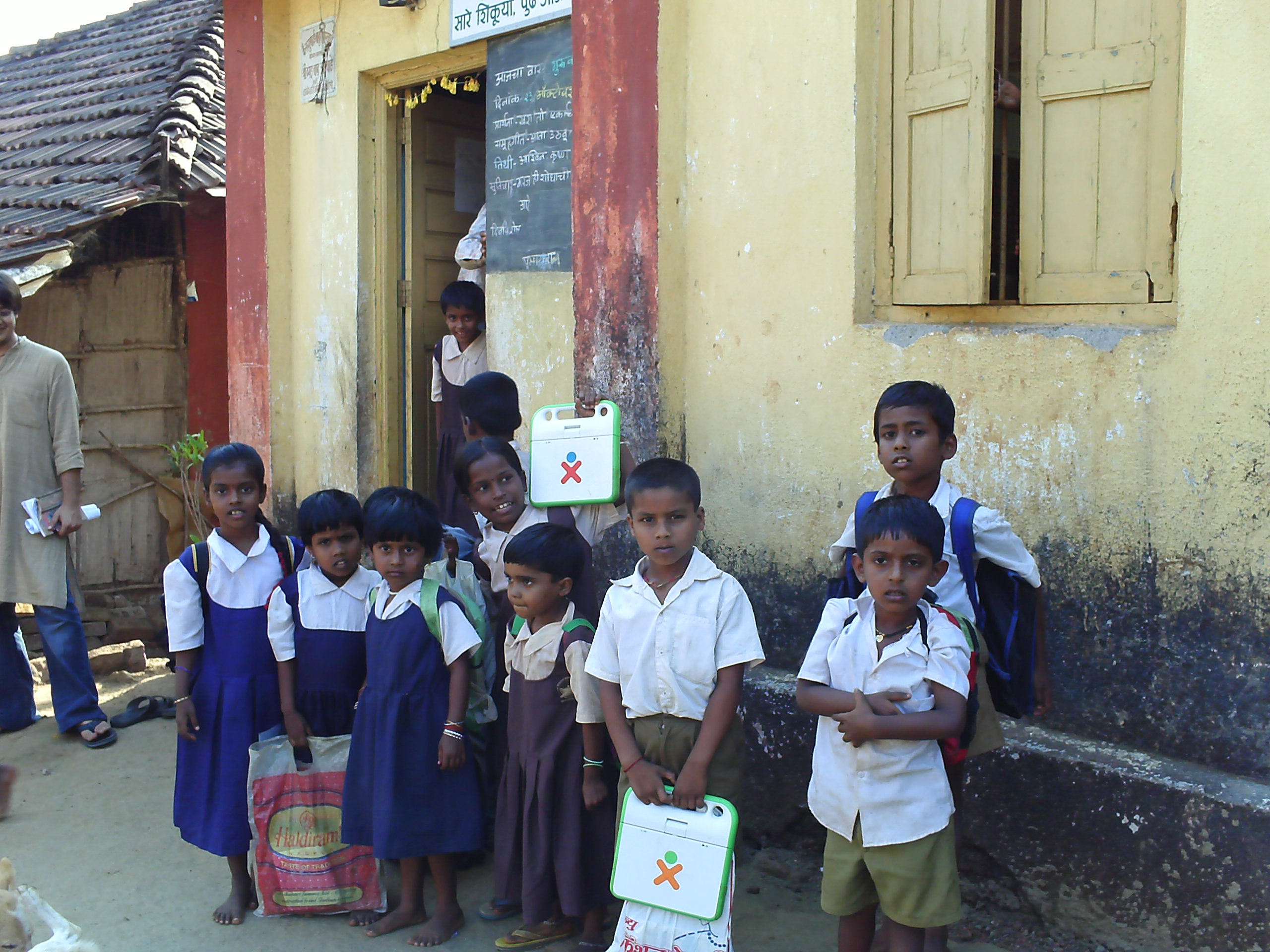
The XOs are currently used in Khairat as the primary method of instruction. The blackboards gather dust with remains of lessons from a year ago. The teacher teaches mathematics by creating "fill in the blanks" problems in Marathi, the local language using the Write activity. The children use their XOs and fill in the blanks. As the children fill in the answers, the teacher sees the characters appear magically on his screen. All these players are oblivious to the fact that their computers carry some of the world's most advanced networking technologies for collaboration. Mesh networks, collaborative word processors, and other bits that first-worlders haven't seen in their classrooms as yet! The teacher simply commands his class to "go to the neighborhood and join the mesh".
These six-year old charmers are truly standing on the shoulders of giants. We hope that many a toothless grin will address a boardroom or a swarm of voters someday. We hope that the XO along with Sugar will help these children open a window into the world we take for granted. We hope that some day, they will address problem that we have not been able to. We hope that some day, they will find ways to make their homes and families healthier, safer, and happier. The children and the teacher have done remarkably well in two years. They are headed towards bright future, and we hope the worldwide OLPC and Sugar communities can help them get there.
This essay is written by Dr. Sameer Verma based on his visit to Khairat in November 2008. Dr. Verma is an Associate Professor of Information Systems at San Francisco State University in San Francisco, California. His research includes diffusion and adoption of sustainable and innovative technologies.
Dropouts become regular at school
Back in October 2007 our group had just started working in the Khairat pilot project with modest goals. Learning from the field is the most wholesome experience. And, Khairat school was ideal for us in many ways - passionate teacher, passionate team, passionate Khairat village community, very poor electricity, very high humidity, irregular topography, four school dropouts and interesting learning tools - 40 XOs. Having worked with OLPC for about 1.5 years back then, I was well-versed with XO's technology and unique features. But I never knew it had magical powers - powers to bring four school dropouts back to school and turn them into regular students.
Low motivation and Distance Issues
We used to have interesting conversations with Mr. Sandeep Surve, teacher at Khairat school, and were dazzled by his commitment and dedication towards educating children, in spite of all odds. In one of his many conversations with Arjun, Mr. Surve once sadly remarked that four children had dropped out from the school. Their small village was was a tough 20 minute walk from Khairat school. Also contributing to their absence was the lack of encouragement and support from their parents. Mr. Surve felt very strongly about the future of these children, and had tried hunting them down in the fields to get them back to Khairat school. But, it never worked out Mr. Surve told us with remorse on his face.
One Laptop Per Child
It is always wonderful to be a part of an innovative team where challenges are looked at as enabling agents, not as disabling ones. We were struck by the thought that the four school drop outs should be given their XOs, whether they came to school, or not. After all, they were officially registered at Khairat school. I still remember the smile of hope on Carla's face, when we met for dinner, two days before the Khairat parent's meeting. She had this feeling that these children would enjoy interacting with the XOs, and that their experience with the learning tools might bring them back to school. "Maybe, they would discover the joys of learning", were her last words that day.
Chasing Kids around the Fields
It was Monday, and the last day of this first visit to Khairat school. Humidity in Navi Mumbai was at its peak. Glad that XOs were working fine under all these severely humid conditions , we divided ourselves into two teams - Arjun and Amit went to Mumbai to look for parts for an interesting rural power project, while Carla and I went to Khairat school. When we picked up Mr. Surve on our way to school, he introduced us to his companion from the same village, where these four children lived. He expressed an interest in introducing us to their parents. After a while making our way down the dirt road, we saw three children bathing with mud near an old thatched hut. Mr. Surve said, "There they are!" When we came near the hut, the children were disappeared. Carla and I looked at each other with astonished faces. We now understood why Mr. Surve had to chase the kids to bring them to school. After a while, an older sister came carrying water on her head. She said that their mother was doing the laundry across the fields. We climbed through the field and into the shallow river spoiling our clothes like small kids, until we found her. The teacher invited the entire family to the meeting.
Impact of XOs and Love
I had gone back to New Delhi. Carla had a week left with her before flying back to Mexico. Or, maybe, to Sri Lanka, to discuss with our friends over there, on their plans to provide one laptop per child to the children of Sri Lanka. We at OLPC always had very innovative schedules.
I continued to hear about these four children in the update e-mails that we used to exchange with each other on a daily basis. Although, they seemed to respond very well considering their long leave of absence, Mr. Surve and the other children, showered them with friendship, love and their smart-tips on using Sugar activities. We were still not very sure whether these kids would ever become regular students at school over the coming months.
August, 2008
I visited Khairat school for the second time, after almost a year. This visit was organized as a part of celebrating the OLPC India Day by Harriet Vidyasagar, co-founder of the Digital Bridge Foundation. The Mumbai team invited Nicholas, Debbie, Satish, David and myself to visit Khairat school. I was delighted to see new volunteers contributing excitedly in supporting our project at Khairat school. Mr. Surve and Amit, as playful as we remembered them demonstrated us the wonderful ways in which the children were using Sugar activities. E-toys and Memorize were their favourite activities. Mr. Surve delighted us with the news that four children : Garima, Vinod, Kamala and Sooraj had become regular at school, and were great in using Sugar activities. I realized that the XO has magical powers.
"If it can work here... It can work anywhere..."
In war ravaged Afghanistan during the rebuilding from multiple partner organizations the challenge was not just implementing an XO program of 11,000 [*] XOs across Afghanistan, but communication the tips and tricks to get it working, localizing for two more languages, Activity and content development, adding the Koran, starting game development, and teacher culture change on a large scale.
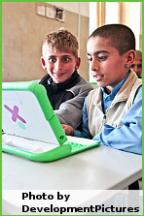
Since the fall of the Taleban 8 years ago, millions of children have gone back to school. Rote learning is the norm and many in the education system have little faith in teachers. Access to resources beyond the standard text books is unusual. Even those teachers who wanted to encourage their students to look further were often stumped for where to look.
The key is to find those 2 or 3 teachers in the school that really identify with it. Then train them / motivate them further to be champions within the school.
Before deployment doubts were naturally cast as to whether or not 60+ year old teachers from a traditional conservative part of the country would be able to adapt. The first signs were mixed...
Yet there were teachers there who were clearly passionate about the opportunity that the XO provided to improve the education for the children. Could it be that by giving these teachers additional training they could help the others along?
Less than a month later the answer came back; YES! All the teachers of grade 4,5,6 in Istiqlal high school in Jalalabad used the XO as a tool in their day to day classes. Children were naturally enthusiastic and from day one started exploring.
On the basis of what we learned in Jalalabad more than 3,000 XO laptops have been successfully deployed across Afghanistan in Kabul, Jalalabad and Herat. Parents and teachers have become enthusiastic as well and family health information / opportunities to increase family income are also being made available via the XO Laptops. Even the troubled Zabul province through co-operation with the Provincial Reconstruction Team may soon receive XO laptops.
To support the school a little more and build an ecosystem we started to hire part time computer science interns from the university to visit the school more regularly than we could to support students and teachers.
"I often want to learn something at home but at home there's no books and no teacher. But this [XO] itself is like a teacher..."
4th Grade school girl, Sayed Jamaludin School, Kabul
A comprehensive monitoring effort is underway to measure improvements in educational accomplishment, thinking skills, health and economic status of the family against baseline measurements taken before deployment. The XO can be a catalyst to radically improve education and addressing the wider environment around the children in which that learning ultimately takes place.
Mike Dawson and http://olpc.af were the sources for this document.
* 11,000 XOs from http://wiki.laptop.org/go/Deployments, though implementations of 396 in first stage, 2,000 in second phase, so 11,000 is probably a goal number.
How 27 XOs Have
Changed The Lives Of
An Entire Community
Afghani refugees in Pakistan
A story of disaster and success, as life is precious and learning is beautiful. Although XOs can't assure it will be easy, it still can be wonderful.
Sometimes small changes have a way of growing into something much bigger. This was certainly the case with a small pilot deployment of 27 XO laptops at the Atlas Elementary School in an Afghan refugee community near Islamabad, Pakistan. Before the nonprofit OLPC Pakistan brought their XO laptops to Atlas School the teachers often kept order with big sticks; smiles were seldom seen on the faces of the refugee children.
Within a few short weeks of the XOs arrival, students were happily using their laptops to learn language, math, art, music, and geography. They were even learning English using E-books in their native Pashto language. Incresing laptop usage directly related to and increase school attendance and improved student behavior. Big sticks were no longer the lecture as they once were before the XOs arrived.
As they became more proficient in the use of the laptops, children cooperated in teaching other children how to use some of the Activities. They even learned to dismantle an XOs and do simple hardware repairs.
But then the school year ended and disaster struck. The owner of the building where the school was conducted said the children and instructors could no longer use it for a place of education. Although the principal hopes to find a new location for the school, for now its physical location has become unavailable.
Not to be deterred by this setback, OLPC Pakistan has continued with a second pilot school deployment at the Mehfooz Shahid Model School in the Korral Valley, beginning with XOs for all of the eight girls and seven boys in the school’s fourth grade class. An additional ten laptops have been placed in the school library where other students can use them and check them out overnight for use at home. More XOs are on order, and near future plans are to have one for every child in the school.
But what has happened to the children of Atlas School and their XOs? The OLPC team that had been working with them wondered as well. The team looked for the children and found them spending their days helping support their families by selling fruits and vegetables in the market or picking through trash heaps looking for things to recycle. The team found something else if interest, too ... the XOs.
The children still had their laptops and carried them to their work every day. Whenever time permitted, they continued to learn and play with their laptops. They formed an XO Club and met in the evenings at each other's homes to exchange ideas and show the new things they had discovered and created on their laptops.
The entire refugee community began to benefit from the laptops as the XO Club members took them to community meetings and allowed adults to use them to learn. They also shared them with their family members and other children, helping them to learn with their laptops.
The school remained closed last year, but the former students continue to receive an education from their learning software located on their OLPC XO laptops. The small investment of fewer than thirty XO laptops has changed the lives of an entire refugee community for the better.
This account was written by OLPC Support Gang member Caryl Bigenho, based on field reports from OLPC Afghanistan and OLPC Pakistan team members with additions by OLPC Support Gang Volunteers.
You can learn more about the XO Learning Club and the children from Atlas School today: http://wiki.laptop.org/go/OLPC_Pakistan_XO_Club
Nepal: Local Solutions are the Key
One of the biggest challenges in implementing a project such as One Laptop per Child in a community school in the developing world is that it needs to be supported in a sustainable way. This is an even greater challenge for a nation-wide deployment, as in Nepal. Placing one laptop per child in a school is only the beginning - indeed may only happen long after the beginning!
The first step is to involve a broad range of people from the beginning. OLENepal was started by Rabi Karmacharya and Bryan Berry in August 2007. From the beginning it worked directly with the Nepal Department of Education. A Board of Directors was recruited from respected members of the community in Nepal including educators.
In the first year beginning in April 2008, laptops would be deployed to two schools near enough to visited easily. Each child in classes 2 and 6 in the two schools would receive a laptop. OLENepal would provide educational activities to supplement the existing textbooks in two subjects: Mathematics and English. Each of the two schools would have a schoolserver which would be connected to the internet via a local service provider.
The important point is that the deployment was limited so that the process could be proven before a wider deployment was attempted. Even so, preparing the educational materials proved more time consuming than anticipated and during the school year OLENepal worked intensively to provide them before they were required. The schoolserver, especially using ejabberd to support collaboration, proved more challenging than expected and, truthfully, the servers were not used for much of the first year. Internet access also proved more difficult than expected since both schools needed directional radio links to the provider. All of this was made much more challenging by the Nepal power grid which tries to meet the growing demand for electricity with limited capacity by shutting off the power for several hours each day.
Before school opened in April 2008, teacher training sessions were held for the teachers in classes 2 and 6 in each school plus the principal and specialist teachers in mathematics and English. The training was held offsite in Nepali presented by Nepali educational specialists from OLENepal for seven days followed by three days in-class training after school started and the laptops had been distributed. For most of the teachers, it was their first experience in using a computer. A critical part of the training was a one-day session for the parents at the time the laptops were distributed.
In the school year beginning in April 2009, the deployment plan was more ambitious, but still controlled. The number of schools expanded from two schools in one district to twenty-seven schools in six districts. The scope was expanded to include English, Mathematics, and Nepali in classes 2 and 3 plus English and Mathematics in class 6. The number of deployed laptops was expanded from less than 200 to more than 2000.
The Nepal Department of Education provides teacher training centers in strategic locations throughout Nepal. A special training was set up in the Kavre district near Kathmandu so that both the teachers in the three schools in Kavre but also educators from the teacher training centers could attend. This allowed the educators from the training centers to take responsibility for the training sessions in the other five districts.
The educational materials developed by OLENepal take the form of Flash animations. These are presented via the Flash plugin for Firefox. Firefox is packaged as a Sugar Activity (E-Paath). The E-Paath activities are organized by class, subject and week (based on a 30 week academic calendar). Each activity is accompanied by teacher notes and a lesson plan (both in Nepali). E-Paath grew in content and sophistication as the first year proceeded.
Important improvements were made and continue to be made as the direct result of classroom use.
In the second year, the schoolserver plays a more significant role. E-Pustakalaya, an electronic library currently containing several gigabytes of content is stored on the schoolserver. It is available to the XO by another incarnation of Firefox as a Sugar Activity. This technique makes both E-Paath and E-Pustakalaya more accessible to younger students who don't have to deal with the complexities of selecting links, tabs, and typing in search text.
OLENepal was very fortunate in that high school students graduate too late for the normal university admissions process in the United States, United Kingdom, Australia, and India. As a result they have a year off between. Several of these students, graduates of prestigious private schools in Kathmandu, volunteered to work full-time preparing to support the deployment. Eight of the volunteers were organized in teams of two to support the deployment in each of the four districts remote from Kathmandu. Initially they performed tasks in support of the OLENepal staff such as repairing laptops while also learning Linux, Python, the Sugar Activities, and E-Paath. They participated as colleagues with the OLENepal staff learnig to communicate by IRC chat, email, wiki, and trac. As the time of deployment approach, they were committed to two tasks: prepare the laptops for deployment and prepare to support the teacher training and laptop distribution in their districts.
The laptops themselves arrived in two air shipments - 300 boxes containing 5 laptops each on pallets. The UN World Food Program provide space to house the laptops and to prepare them for distribution. Preparation became a very intensive assembly-line process. The boxes containing laptops for each district beginning with Kavre were opened. The laptops were removed from the packaging and united with their charging adapter. The next step was to test each laptop (receiving inspection) using the test-all feature of the firmware (something which is extremely valuable and not well publicized). Units which passed were then connected to charging stations (the others were placed on a DOA rack with a tag identifying the reason). Each laptop was then loaded with the OLENepal version of Sugar (NEXO) by nandblasting. Since the 'nandblaster' continues to cycle broadcasting the contents of each block of Nand, laptops could start receiving the broadcast anywhere in the cycle and be removed whenever they completed the cycle. Once nandblasting was complete, the laptop was identified (using a permanent marker) and Bryan Berry recorded the serial number and identification number. After the laptops were repacked in the boxes, and the boxes identified by district and box number along with the identification numbers of the laptops in that box. It took a team of six all day to process 300-400 laptops fueled by lots of pizza.
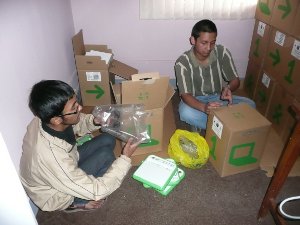
Interns unpacking XOs
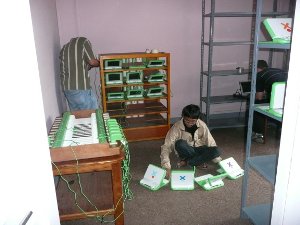
Running 'test-all' and Nandblasting

Classroom showing charging station and wireless Access Point on the wall to the left
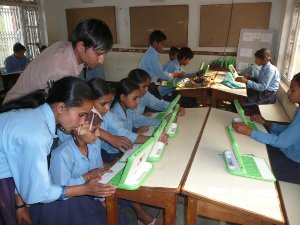
XO class in session - notice students helping each other (girl in foreground, boy in background)
Meanwhile the Kavre teacher training was taking place. As a result these volunteers were shuttling between the World Food Program factory and the teacher training site. At the training, the volunteers were invaluable in working with individual teachers to help them over difficulties as they tried to use the XOs to try out the activities discussed in the training sessions. This was critical since these teams plus an OLENepal staff member would attend to each of the training sessions in the other districts to support the Department of Education trainers.
OLENepal maintains a staff of paid professionals plus volunteers. The leadership and staff are almost all Nepali. The skills required cover an amazing range - government relations to coordinate activities with the Department of Education and other sponsors, educators to plan the educational materials to support the school curriculum, designers to prepare the artwork, animators to prepare the Flash scripts, software engineers to integrate the activities with Firefox, the menu system, and Sugar, network engineers to enable school access to the internet, electrical engineer to design and implement the charging stations and to coordinate electrical needs with each school, and system administrators and software engineers to implement the schoolserver and ensure communication between the internet, the administration network between the schools, Department of Education, and OLENepal, and to support the infrastructure at OLENepal.
You can learn more about OLE Nepal's work at http://olenepal.org/. Also, see "Tackling the Problems of Quality and Disparity in Nepal’s School Education: The OLPC Model": http://wiki.sugarlabs.org/go/File:SDBhatta-2008-OLPC_model.pdf.
This story was contributed by OLPC Austria member and olpcnews co-editor Christoph Derndorfer based on information provided by OLE Nepal team-members. Special thanks to Tony Anderson, Bryan Berry, Rabi Karmacharya and Subir Pradhanang for their support during the process.
Escuelab Mobilizes Country-wide Effort
Peru, by Kiko Mayorga
One of many encouraging signs about OLPC is a network of people within a developing country building the capacity to leverage technology to advance education. In Perú, Escuelab (Escuela [School] + Lab) is such a network: a dynamic, collaborative in-country partnership creating an environment ready to ensure that additional contributions make a powerful difference.

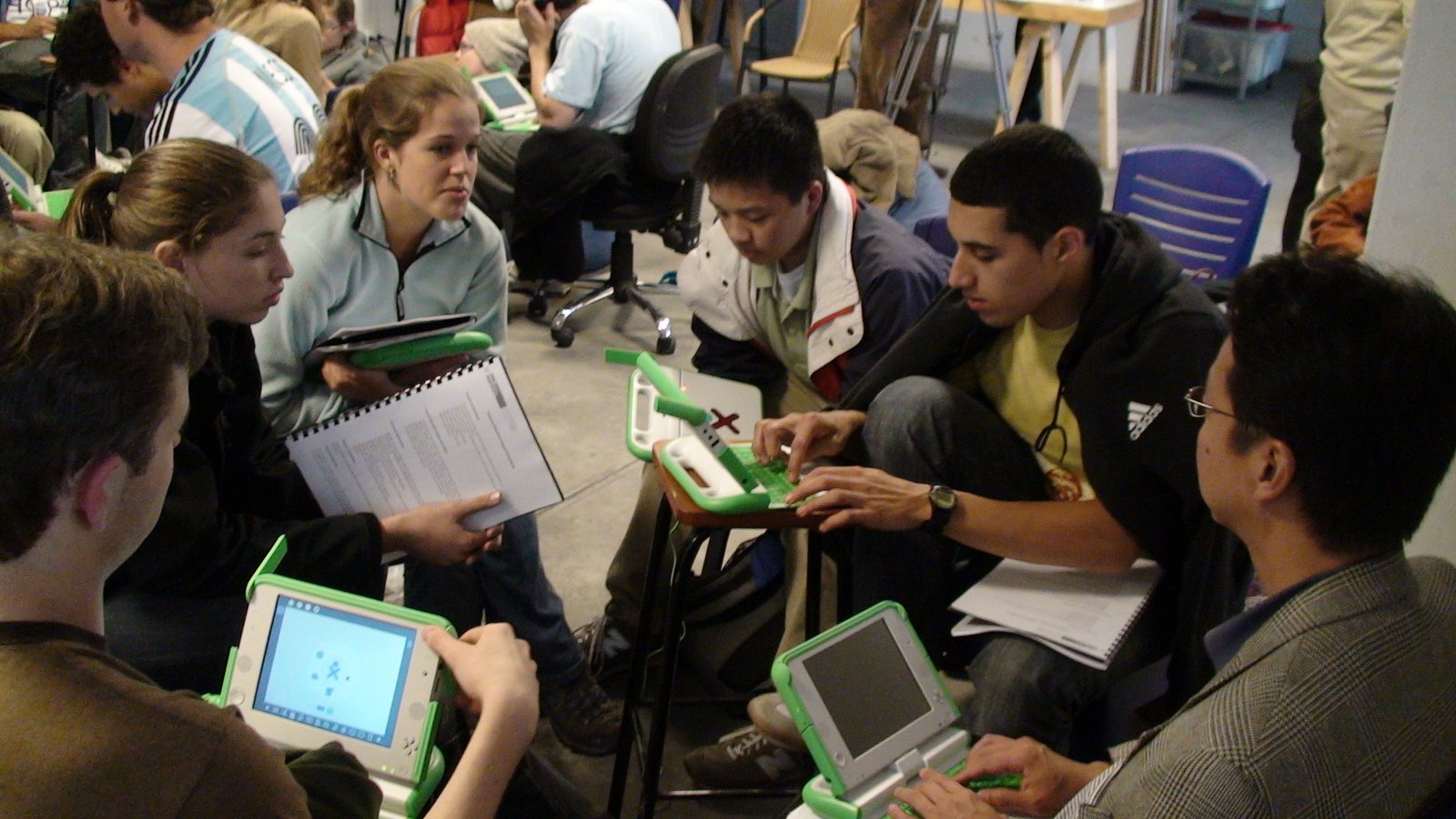
In Peru, as in many other developing countries, education is a great concern. Recent studies place Peru's educational system among the world's least effective. In response, many are promoting the use of technology in the classroom, piloting and implementing various solutions. Still, it's more than just implementation. Integrating the technology into our culture is a constant challenge. Culture is complex and has its own internal forces; if we are to succeed with this challenge we must follow its logic.
|
|
The XO laptop inspires many to believe that the right technology can improve education worldwide. Those fortunate enough to have time, expertise, and funds to contribute to a program like OLPC naturally want to be confident that their contribution will matter. |
Escuelab's response to this challenge: an open space for disparate participants to share expertise related to technology and education. Escuelab promotes interdisciplinary and collaborative work while studying and prototyping a generic platform to facilitate physical and virtual encounters and experimental activities that will trigger projects and collaborations we don't need to predefine.
Escuelab brings together educators, managers, content experts, software developers, government employees, elected officials, engineering students, international visitors, and other enthusiasts. A network forms among participants collaborating to advance plans and projects. These "Electrolearning Saturdays" resemble a science fair, where everyone has the opportunity to meet people sharing the interest of contributing to a better educational system in Peru.
It's interesting to see how well the participants mesh. People begin learning and sharing almost immediately, as even people who have never met routinely find common ground. Escuelab creates a space for ideas, perspectives, and collaboration that people might not otherwise get the chance to share. Discussions succeed in such an environment that otherwise might have been lost across disparate places, times, and organizations.
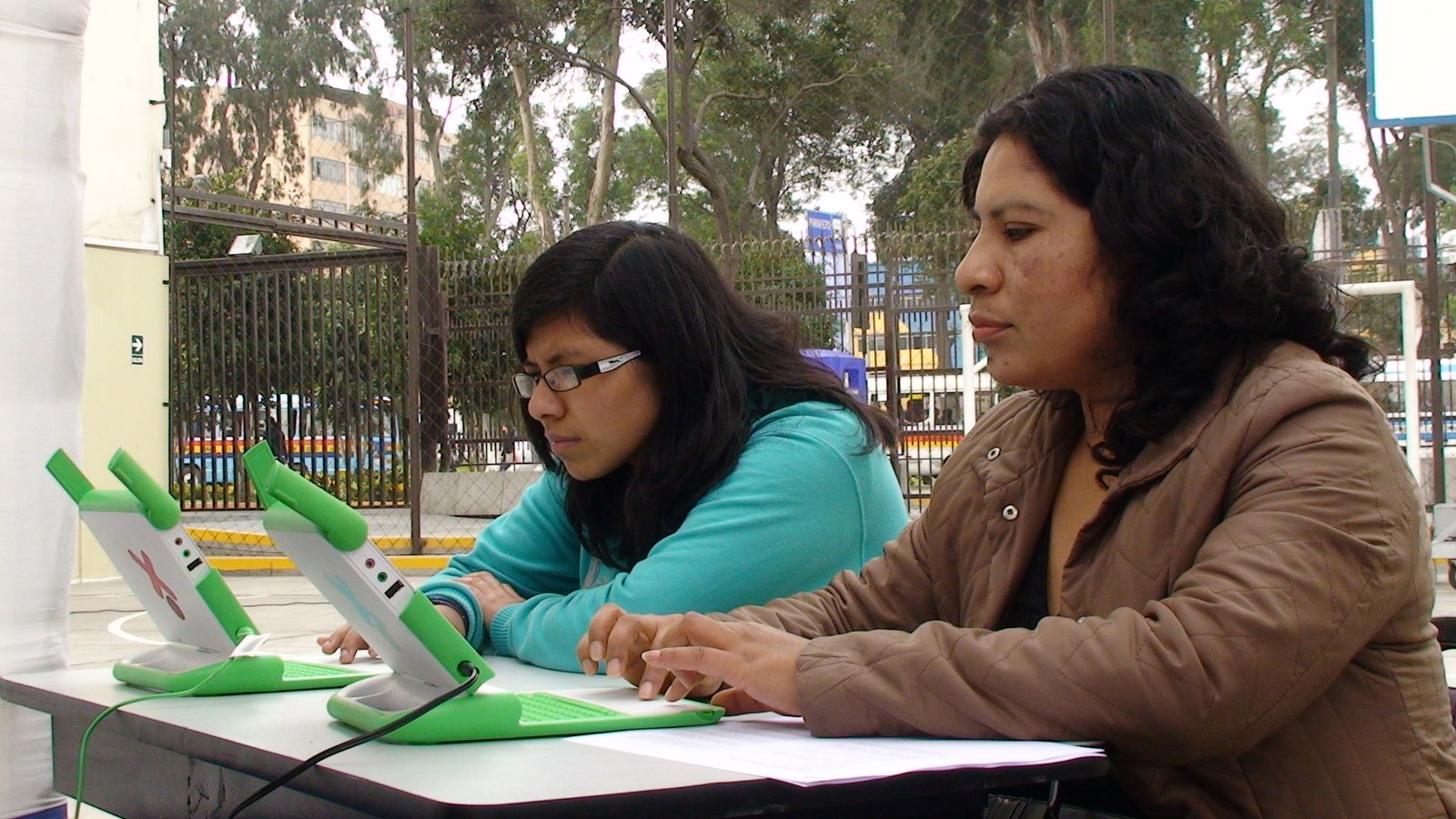
An important early product of this process, Escuelab collaborated with the Peruvian Ministry of Education to host four workshops:
- Two three-day workshops involved a total of 74 UGEL directors. UGELs (the Peruvian Ministry of Education's acronym for Local Educational Management Units) coordinate across schools in a geographic region. One workshop focused on the Metropolitan Lima and Callao Region, and another on rural areas near Lima.
- A three-day workshop for 44 educators working as trainers in the field for Regional Lima. The workshop was held at Escuelab and was coordinated by the Director for Primary Education of the Peruvian Ministry of Education.
- A five-day workshop for a group of 24 American volunteers in Perú through a collaboration between OLPC Foundation and the Peruvian General Director for Educational Technologies.
|
|
Escuelab is a community and volunteer-based effort that complements the official Ministry of Education of Peru XO deployment, the second in size in the world |
Within these workshops Escuelab has organized smaller groups focused on using technology to enhance interactions among distant participants. Escuelab's "experimental lab" atmosphere builds powerful, continuing relationships among participants, then provides an enabling environment for advancing the specific projects that result.
Next steps for Escuelab include building more cooperative networks not just around education, but around other culturally relevant areas like Architecture and Urbanism, Art and Culture Management, Civic Participation, Environment, and Cultural Diversity, thus acting as a collaboration Hub, facilitating spaces and infrastructure and a practical, hands-on approach to technology integration.
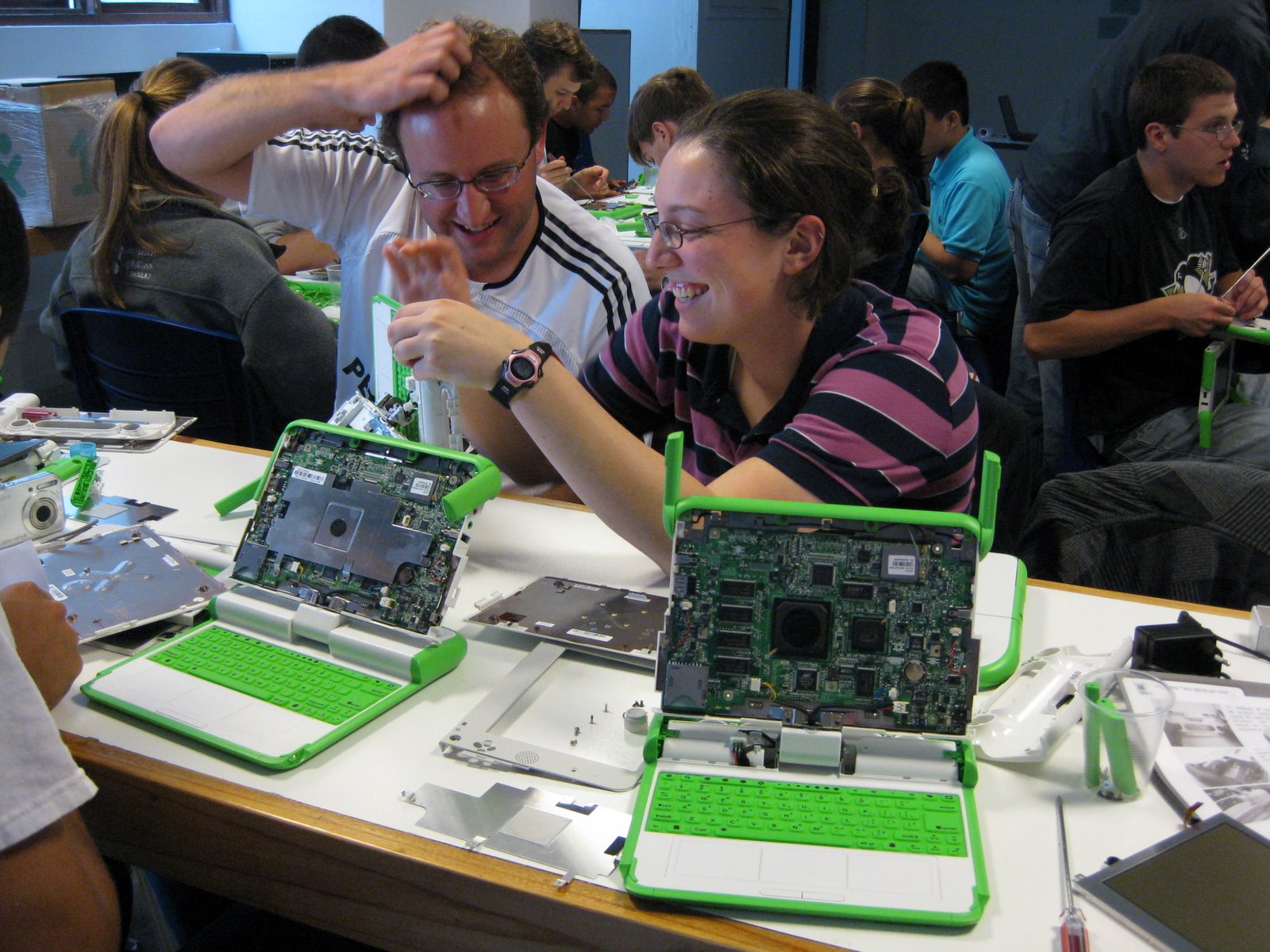
Part of the effort involved training a group of people to repair XOs when they stop working.
Just a few months along, Escuelab's multidisciplinary atmosphere has already created a rich social laboratory, where local, regional, national, and international researchers, creators, artists, and activists experiment in a supportive environment, acting as a way-finder through the possibilities and complexities of richer, more effective learning experiences.
Escuelab space/project is supported by:
- Alta Tecnología Andina (a peruvian non proffit organization working in Culture and Technology for fourteen years now) (www.ata.org.pe)
- the Prince Claus Foundation for Culture and Development (www.princeclausfund.nl/)
- the Spanish Agency for International Cooperation to Development (AECID) (www.aecid.es/)
www.escuelab.org

Making Waves in the Caribbean
(by William Stelzer)
There is one thing one learns very quickly in Haiti and that is not to take anything for granted. And to treasure every success, no matter how simple it may seem. So as we stood by for the first Annual Waveplace Awards webcast at a small hotel in Port au Prince, there was something wonderful about just watching the kids enjoy free time their XO laptops. Some took pictures of each other, while others created music. A few kids were even off and running with Etoys. Nobody seemed to mind the delays caused by the technical problems of connecting four countries simultaneously.
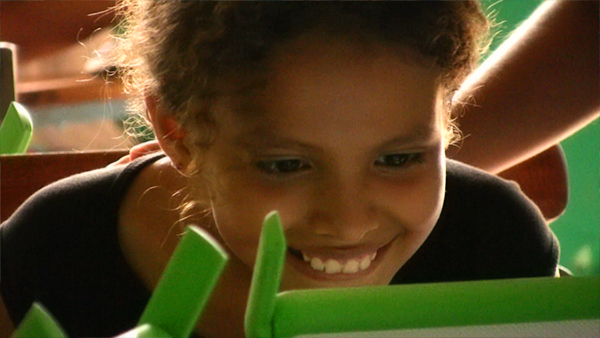
In its own small way, the past year for the Waveplace Foundation has been an epic journey. As amazing a machine as the OLPC XO is, getting the maximum educational value out of it was in many ways an unknown. Although it would have been easy enough to simply teach children how to type, take pictures, and look up information online, Waveplace had in mind a much more difficult and transformative goal. And that was to find the best ways to teach children constructionist learning, to discover for themselves how to use computers to jump start their thinking, inspire their imagination, solve sophisticated problems and harness the tools needed to accomplish their dreams.

The kids at Guy Benjamin School, in St. John, U.S. Virgin Islands became the first to take on the challenge. At this early stage, the best description would be a roller coaster ride, as everything was new and untested, and the pilot quickly became an adventure in problem solving. But for the kids determined to plow through, the results were groundbreaking, and through Etoys they became among the very first computer programmers and digital storytellers at the elementary school level in the Caribbean. Even more importantly, the lessons Waveplace learned there would greatly improve the pilots to come.
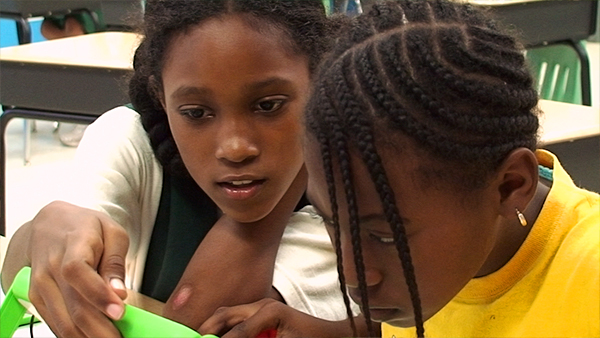
Midway through the St. John pilot, Waveplace also began a pilot in Port au Prince, Haiti, this time in partnership with the Mercy and Sharing Foundation. Working in Haiti is like living in novel. Filled with larger than life characters and obstacles that seem at times impossible. Food riots, hurricanes, floods and the ever present danger of corruption in a devolving country. What is beyond question though is the desire and determination of the kids. For most of them it was the first time they had ever even touched a computer. It was both humbling and inspiring to watch them search the keyboards for the letters that made up their names. And then to see them, only a short while later, create digital artwork and animations on the XO laptops as if they’d been doing it all their lives.

One of the stars of the Haiti pilot was a young orphan named Jessie. Though she walked with prostheses, her spirit and drive were absolutely without limit. I spoke with Haiti's then Minister of Handicap Affairs and he told me that because of Haiti's unforgiving living conditions, one in eight Haitians were disabled. As I listened, I couldn't help but be struck by the critical role children's laptops played in unlocking the potential of kids like Jessie all over the world.
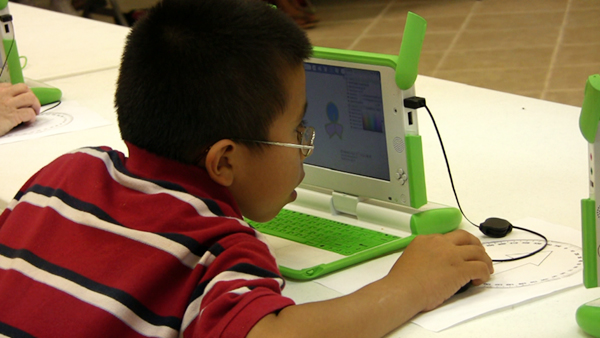
In the Immokalee, Florida pilot it all finally came together, everything just clicked into place. The kids were fantastic and we also were lucky to have highly educated, dedicated teachers to spark within the kids the almost contradictory conditions needed to make this strange beast called constructionist learning come to life. Then as a bonus, we even had a chance for our work to be documented and broadcast by National Public Radio.

One of the teachers there, Christa Crehan, eloquently wrote this about Immokalee's two Waveplace Awards winners. "Maria and Eric began the program with trepidation. What they created is from their heart. We allowed each child to take his or her gift and focus on that gift to create a story all their own. Maria's focus was her incredible eye for detail in her beautiful artwork, while Eric chose to focus on learning complicated programming skills. There is something for every child in Etoys no matter what their contribution to the world may be. We will help them find their voice."

The best word to describe Nicaragua is simply magic. There we partnered with Campo Alegria for a pilot in the small village of Buenos Aires. We were back in a difficult and rugged environment, but also a beautiful one. It was here that the true transformative potential of the XO and Etoys most dramatically revealed itself. And not just for the students, but for the teachers also. As I watched the kids, who almost had to be torn away from working with their laptops, I felt as if I was watching history in the making, and that dreams of the visionaries who began this project were finally coming to life before my eyes.

It was also from Nicaragua that we first met Wendy, who was to later win the highest prize in the First Annual Waveplace Awards, the Seymour Award.
Mary Scotti, the Waveplace team member who stayed behind to document the pilot through its duration, interviewed this slight, lovely and introspective girl as she described her world:
"My house has three people, my mother Joanne, my father Ricardo and me. I have an older sister who is fourteen years. She lives with my grandparents on the Pacific side of Nicaragua in the district of Tola. Our home is very far from the school. My mother will not let me come all this way alone. She rides with me on her bicycle until we reach town where it is safe. She meets me on my way home after class.
In my spare time I like to go to the lake and bathe. I also like to draw in my notebook. I don't live in a neighborhood. There are not many houses by me so I learn to play alone. I love to read and have a few books of biblical stories. I help my mother cleaning the house and doing the dishes.
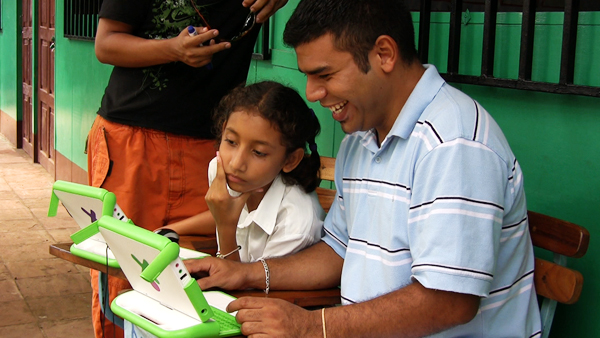
I would like to study English and become a translator. I want to go to the University. I would like to live in San Juan del Sol. It is very beautiful there and has a beach.
I used to think that laptops were good but really I had no clue about them or how to use them. Now I especially like learning how to draw with them. I would like to keep making art. My parents are very happy for me and think this is very good.
I want to remember everything that happened here in this class. This is an unusual chance and time. I especially want to remember our trip to the camp. That will always be a special day for me."
Wendy's essence engages and inspires. She is imbued with natural talents. In the states we would declare her "gifted" no doubt. Thanks Wendy. May your light shine and your dreams be realized. Along with those of each and every child in the world.
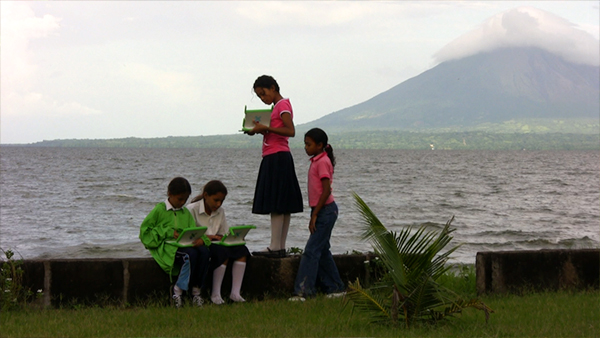
Etoys: a tool to change teaching practices
by Fabiana Marella
The project which is described here is integrated in the curriculum for teaching the concept of air convection in fifth grade. The objective of the work sequence was to present the students with several approximations of air convection concepts. Starting from molecular theory, the project also had as a goal to encourage the process of observing, defining a hypothesis, experimenting, and communicating the results. The pedagogical interpretation started with the basic properties of matter: mass and volume, considering its macro- and microscopic dimensions.

Next, we focused on the definition of air, according to the properties indicated, and experimental devices were constructed for the purpose of experimentation and analysis. Again, following the same process, we considered weight, atmospheric pressure, density, and temperature, as properties of matter, and specifically of air. The activity that we presented is part of the learning process that has been transformed by the use of XOs in the classroom. The curricular content was air convection, but a specified goal of the activity was for the students to understand the convection phenomena from the point of view of the properties involved: mass, volume, density, and temperature.
Questions were raised such as: Why does a balloon rise? Or why does a pinwheel turn when it has four lighted candles below? These questions sparked new questions: How does a hot air balloon work? Is there a link between its performance and that of the pinwheel? How could you design an experimental device to observe this phenomenon? In connection with the above, questions were structured for the children to use in their work. The experiments' results did not agree with the explanations given in the previous hypotheses, and the children needed to look more critically at the design of the devices. This encouraged the children to investigate others' work on the subject and through that search they found materials produced by other children on the Internet, as well as academic papers.

Since we didn't have the proper experimental devices available to demonstrate the causes of the air convection phenomenon, Etoys became our tool to model reality, as well as to allow the students to put into play their knowledge and share the results of their work.
The children programmed convection models such as the pinwheel. They made representations of air particles and designed animations to show constant mass, differences in volume, density, and potential energy (both gravitational and kinetic). Through the models, the children finally were able to "demonstrate" and communicate the results of their "research".
Discussion: Afterwards, we drew a comparison chart which exhibited the differences between the work with Etoys and traditional teaching practices.
- Etoys graphics are sharper
- animation replaces note-taking and helps to enliven the phenomenon
- Etoys allows simultaneous and integral understanding of the relationships inherent in the phenomena

Using Etoys to emulate natural phenomena, besides becoming a powerful tool to share completed work, requires the individual to develop a profound understanding of what he or she intends to represent. To program an emulation implies a significant level of knowledge about the physical characteristics of the agents in play (in this case, air particles at constant mass and variable volume, at different temperatures, with different levels of kinetic and potential energy, etc.) In addition, programming requires the individual to grasp and manipulate the cause, effect, and consequence of the relationships implied by the phenomenon being modeled.
For these reasons, we assert that this new learning tool, far from being merely an enrichment device, transforms the teaching/learning mechanic.
It asks more from the learner, because it requires him or her to anticipate steps, and encourages the development of deductive hypothetic thought. Likewise, it brings about inductive reasoning through trial and error. The use of programming-specific language forces the individual to organize thoughts in a logical sentence structure, using if, for, while, do, or, and. Learner-created models give the teacher the opportunity to put the student in a situation to critically analyze the emulation. Contrasting reality and the model enriches the understanding of the subject matter, at the same time allowing flexibility and the possibility to improve on the concept.
Briefly, we brought the computer to the classroom to "teach to learn" within the paradigm of the information age. The challenge is to use the XO to do what cannot be done with pen and paper. Otherwise, we would be turning this revolutionary tool into a conservative one, by allowing it to be absorbed into past practices. In the words of García y Castrillejo, "the challenge is to decide if we are educating to use a tool, or educating for an era of choices". Mtra. Fabiana Marella
Even when it feels like it can't be done,
the XO can still help you defeat illiteracy
Uruguay, Children With Learning Differences
Learning is more than just being good at what you are required to be good at. When you can't reach the expected goals, when school feels like endless frustration, another chance can be yours when the XO gives you a fresh beginning
The 14-year-old boy stood in front of his sixth grade class holding his new XO. He had tears in his eyes, but he was smiling as he shouted, "
"Sé leer! Sé leer! ... I know how to read! I know how to read!'
|
|
Uruguay distributed the 396,727th laptop in their schools in Oct. 2009. Now every student in every public elementary school has received one. Connectivity and other logistic efforts complement the CEIBAL project, currently the largest 1-on-1 ICT4E initiative in the world
|
This story began a few days earlier when he accepted his very own XO as part of Uruguay's Plan Ceibal. Under the plan, all elementary school students will eventually have their own XOs. The whole country has enthusiastically embraced the XO and the One Laptop Per Child concept. Under Plan Ceibal, every child, regardless of economic status, cultural background, place of residence, or academic ability, will eventually be included in the distribution of the little green XO laptops.
When it came time to distribute the laptops in his sixth grade class , the boy was very nervous and anxious. He had always been a problem student, misbehaving, not getting along with the other students, and often being out of control in the classroom. Academically, he was behind the other students in his class. Although he knew the sounds of all the vowels and consonants, he was still unable to put them together to read or write words. At the age of 14, he was still "analfabeto"... illiterate.
A few days after the children received their XOs, the teacher asked them to tell a story using the Write Activity, which is part of the Sugar software that come with every XO. The boy came up to her desk and said,
"I want to write about Nacho, the character I liked in the play we saw last week... but I don't know how."
"Come and tell me what you want to write," she answered.
She took his laptop and wrote the story as he told it. She says she was amazed at how beautiful it was.
"Now, you have to read this to your classmates," she told him.
"But if I don't know how to read?", he asked.
"Ah, but today that doesn't matter," she smiled and told him in a soft, conspiratorial voice. "You are going to know how because you wrote it."
He went through the story several times in silence, then went to the front of the room and read it aloud to the class.
For him, it was an unforgettable day. For the first time in his life, he was able to read. Later, he read simple stories written by his classmates on their XOs.
And, so began his "alfabetización" ... he became a reader.
|
|
The XO that this child used is not modified in any sense compared to "mainstream" ones, though efforts are underway to reach the needs of other special kids.
|
This story was written by Caryl Bigenho with permission from Rosamel Ramirez, the sixth grade elementary school teacher who lived it at her school in the state of Durazno, Uruguay. The story originally appeared on Rosamel's blog at: http://www.blogedu-rosamel.blogspot.com/
You will find more stories there (in Spanish), along with many excellent photos and videos. Among them are some wonderful photos of deaf and hard of hearing children using Etoys on their XOs (Nov. 2008). Other great resources from Uruguay can be found through links at the Plan Ceibal website at: http://www.ceibal.edu.uy/
La Portatil Viajera ... The Traveling XO
From an account by Iris Fernandez
It was the second Sugar Day in Buenos Aires, Argentina. I was seated among the assistants when a man entered, dressed in a suit and carrying two children's backpacks. It appeared one was for a boy and the other for a girl. They were a powerful attention getter because this person had no child with him. He was Alejandro Fernández, and he told us this wonderful story.
The story
This happened in La Plata, the capital city of the province of Buenos Aires.
Alejandro had participated with his daughter in learning the guitar using the Suzuki method. This method requires that a parent learn the instrument along with the child so that the child will learn music in a way similar to the way they learn to speak: by imitating the sounds.
Alejandro's wife, Analía De Biase, is a preschool teacher at the Preschool at Our Lady of the Rose in La Plata. When she saw the Suzuki method of teaching and learning in action, she proposed translating it to teach the use of the XO computer to small children and their families. "Usually teaching technology separates the generations instead of uniting them," Alejandro said.
So she took three XOs she received as donations to her preschool class. Most of the children had no previous contact with a computer. The group of three-year-olds, together with Analía, explored the small computers. They learned to turn them on and to take photos.
The next step was to make a picture-chart that told the children how they could teach their parents to do the same thing. The children chose the pictures and the correct order they needed to put them in.
In Argentine preschool, one typical activity is called "El Cuaderno Viajero ... The Traveling Notebook" in which a folder or notebook is passed among the children's homes, spending several days in each. While they have the notebook, the family writes things about their their pets and family members or uses it to exchange cooking recipes, poems and songs. Sometimes they include photos.
Two or three children at a time took an XO to their homes in little children's backpacks, together with a notebook for their families to write in. The assignment was for the children to teach their families how to turn on the XO and take photos and film a video. After they had explored the computer, they were to write something in the notebook that accompanied the laptop.
Alejandro told us that when the XOs came back to class they made a backup of all the family had recorded. Then they went to another family. "One day I was looking at their files and I noticed that some of the families had discovered how to write documents and add photos (I still don't know how to do that)."
When the school year was finished in Argentina, all of the children in the classroom had taken an XO home to share with their families. And the surprising result was that the three-year-old children had taught their parents, brothers, and sisters how to turn on the computer and how to use it to complete the assignment.
Somebody Should Set The Title For This Chapter!
You have seen in the first part some of the many ways that the XO is used in different parts of the world, under different circumstances, to achieve success in learning.
Those stories did not happen by accident, and in many cases setting up a deployment is not an easy task. The following chapters describe some of the major issues that need to be addressed, why they are important, and how they can be a part of your own success and that of your students.
The XO Is A Teacher's Dream Machine
What Is The XO?
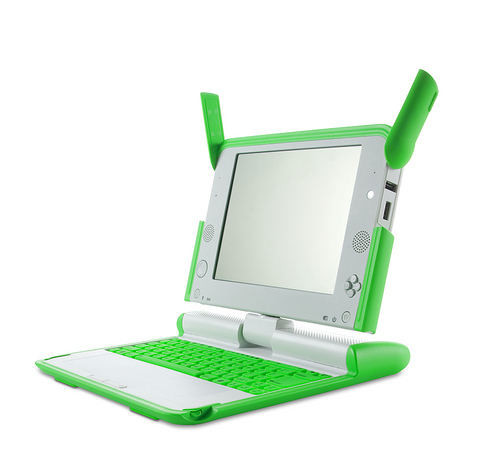
Teacher Training Sarawak, Borneo
Why Choose The XO For Your Learning Project?
Children recognize immediately that this little green laptop was designed for them. Despite its toy-like appearance, the XO is actually a very powerful tool.<?xml:namespace prefix = o ns = "urn:schemas-microsoft-com:office:office" />
.
The XO Is Tough And Safe For Use By Children.
Children drop things. Because of its solid state file storage system and no moving parts, the XO is resistant to breakage.
Has your laptop ever been too hot for your lap? Unlike laptops designed for adults (full sized, notebooks, and everything in between), the XO's battery does not get hot and there is no internal fan.
The plastic shell case is tough and has a non-skid surface. The screen is very clear even in the bright sunshine, Open or closed, it is moisture and dirt-resistant. The XO is durable so that learning can take place beyond the classroom and in remote locations where there are no schools. Children use it outside, at home with family, and anywhere in their community.
XOs Are Better For The Environment.
XOs are designed to be repairable on site and durable. OLPC does not want to contribute to the world's growing technology landfill. XOs require only 10% of the power it takes to charge a conventional laptops. And, the XO battery lasts far longer between charges.
Children use it outside, even in the bright sunshine, at home with family, and anywhere in their community.

Children Study in the Bright Sunshine Arahuay, Peru
"It's An Education Project, Not A Laptop Project." OLPC Founder, Nicholas Negroponte Daniel Apapi uses OLPC laptops donated by the G1G1 program to teach children in Cambodia. He describes the XO. "It's not a 'laptop' meant to replace what you or I are working on. It is a tool for kids to guide them through their own learning - when their teachers don't show up, when there is a huge differentiation between levels in one class, when there are too many students for one-on-one instruction. * I have seen in our students and the other OLPC programs we work with in Cambodia, that these tools are inspiring children to lead themselves into areas of education that they are not given access to in their normal government classes."
There is No Need To Purchase Software.
The XO software is all Free and Open Source. This means you never have to purchase software or pay user or licensing fees for any programs you wish to use. Your XO will not run Microsoft Windows, Mac, or other commercial software. There is free, public software to parallel many commercial applications. You can download lots of free programs, e-books, and Activities (applications) for your XOs and never have to pay for them! The Open Source Community is creating and developing more, all the time. OLPC is committed to the Open Source software platform. It is ideal for learning and encourages anyone of any age to create new Activities for the XO. Activities can be and have been created that address language and curriculum needs and desires specific to other countries and to many different types of learning sites.
Unpack It, Charge It, And Use It!
The XO comes loaded with Activities (software applications) selected especially for young learners. A long list of additional Activities can be downloaded from the OLPC Wiki at http://wiki.laptop.org/go/Activities. Instructions for using the Activities are available online and in print at http://www.laptop.org/8.2.0/manual/. Most of the Activities are designed to encourage children to work together, sharing and collaborating and socializing with others, rather than isolating themselves behind their own computer.
Connect With Other XOs And To The Internet.
The XO is wireless! No cables or cords are needed to connect your XO to other XOs and to the Internet, if available. Wireless access works better in developing nations, where it is faster and less expensive to introduce them than wired ones. XOs find other XOs within range, using a mesh network. The built in mesh network allows nearby XOs to talk to one another directly (wirelessly) without the need for a traditional Internet Service Provider (ISP). Collaboration between teachers and children on Activities does not require an Internet connection.
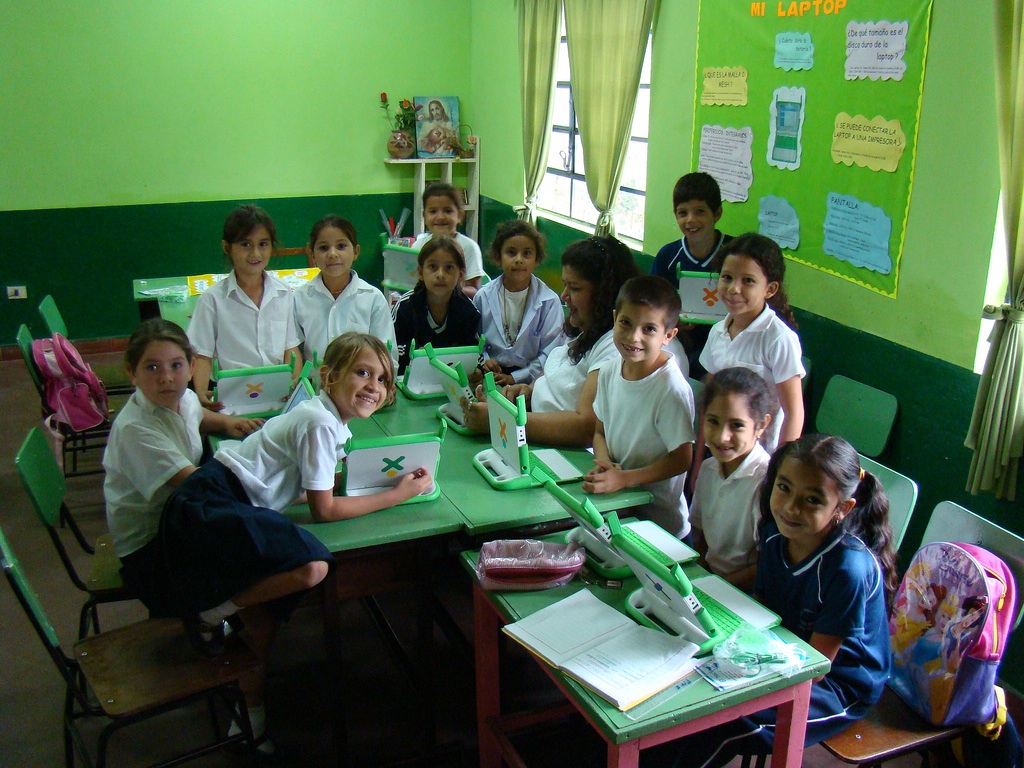
Collaborative Learning, Paraguay Photo Credit: Daniel Drake
XOs can connect to the Internet on any unlocked wireless network, or with a password on a locked network. If there is one open Internet connection in the neighborhood, all children within range of that connection can access the Internet for free.
Where Will You Find Support For Your XOs? From The OLPC Community! XOs have a built in "Help" Activity. Your "User Manual" is just a click away. The larger OLPC Community, volunteers from the many time zones all around the world provide additional support. You can find links to all of the information you need for support for your hardware, software, and for your project, at http://support.laptop.org. Everyone involved with the OLPC Laptop Project is encouraged to connect with others. Children, teachers, activity designers, and others who use XOs become part of the OLPC Community, learning, creating, sharing, connecting, and contributing.
Join Us As We Change The World. Create a project for the XO "Teacher Dream Machines" and join the XO Phenomenon!
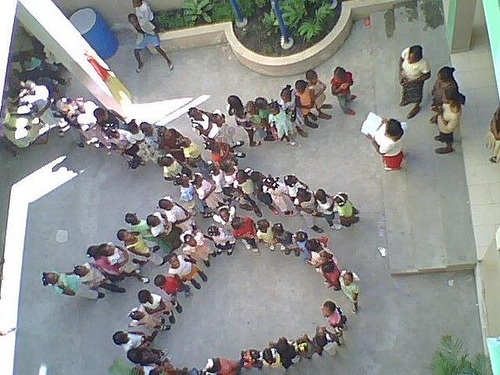
Children Dance the XO, Haiti
Powering The Dream - With Electricity
Rwanda, Nauru, Madagascar
Although XOs need very little power, it adds up fast when you give one to each child.
Many rural and remote areas lack a reliable power source. From one of the poorest places in Rwanda comes a touching story on how XOs are having an unexpected impact on rural communities. At night in this village the XO is the only source of electric light for some families - their home has no electricity. This causes us to reflect on how deep are the many needs here.
Low power consumption is one of the features that make the XO is a revolutionary computing platform. The usage compared to the average laptops and the even more recent netbooks is much lower. The XO battery is long-lasting, quite reliable, and environmentally friendly.
The biggest challenge to power usage is attempting to power all the XOs in a classroom at the same time, or to charge them while they are being used. The battery charge lasts about three hours, depending on what Activities are used. The video camera uses the most.
An important priority for you to consider in your project is training users early on charger safe practices. Obviously parental help is desirable and recommended, but it do not assume it will be available to all children all the time.
For more advanced power topics, additional specs, and links for on line resources see general battery and power supply pointers in the OLPC wiki.
Deployments in developing countries need to consider the cost and the volume of the extra power requirements for the XOs. As mentioned above, sometimes you have to reinforce wiring in the schools. In most cases the students cannot charge their XOs at home. Multiple outlet plugs will have to be purchased to be able to plug in the computers in a classroom or location at school. Additionally, if you are using a School Server or wireless connection access points, you need wiring for those. It is convenient to build some sort of cage to prevent theft or damage.
|
|
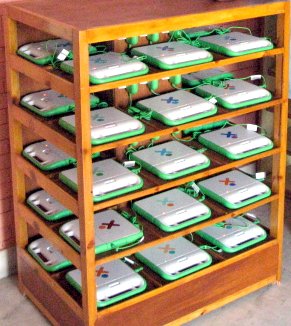
Rack to charge many XOs, OLE Nepal |
Some ingenious arrangements have been fashioned for
recharging a lot of XOs at the same time, like the pictured example from Nepal. OLPC has experimented with a charger for many XO batteries at once ("gang charger") and a one-plug-to-many-XOs contraption, neither one widely available yet in 2009.
The XO gained early popular fame with the possibility of using alternative energy sources, given its low power needs. The prototype hand crank proved not to be practical, but solar panels do work, weather permitting. Although a 10 W panel can solar charge an XO directly in about three hours, their reliability long term has not been established yet, and obviously they would be rather useless during the rainy season in many countries.
In a village in Madagascar the XO deployment is "piggybacking" on a power generator installed there a couple years ago for an ice making plant. XO and other communication deployments can be a rationale for government or private/community infrastructure improvements, and in some circumstances this need has to be budgeted from the start, especially when dealing with several hundred XOs in each school.
|
|
Most of the power alternatives for the XO are either in the early conceptual stage or at best in experimental use.
This is an area that would benefit from realistic, devoted effort. |
Solar power has been used successfully by OLPC Oceania. The tiny island nation of Nauru has set up one of their elementary schools with one "solar classroom". It is equipped with panels on the roof and a connection in the classroom for charging the XOs. They are drawing on the experience of others in another OLPC Oceania pilot project in Papua, New Guinea. There, they decided to go 100% with DC share and 15W flexible GoldPeak panels with small capacitors integrated to avoid an oscillation problem. The cost is much reduced over having battery storage, and the laptops can be used while being charged. Others advocate the use of 20W panels if possible, or arrays to serve the whole school rather than individual households.
I want to add a little word of gratitude for the work that Richard Smith of OLPC has done in figuring out many of the most challenging parts of the power issues, and responding promptly with effective solutions when new fixes were needed.
Somebody Should Set The Title For This Chapter!
Getting the XOs to the children who are going to use them may be the biggest task you might face in the early stages of your deployment.
Transportation itself is a rather straightforward matter. I personally load 3 XOs with their chargers in a single XO box.
Teacher. . .Why doesn't this work?
 Cincinnati
Cincinnati
If it's broken we have to fix it!
The XO is easier to maintain than most other computers thanks to its design, but also because there is a living community of volunteers happy to share their knowledge of how to do it.
Is it not working because a student doesn't know how to use an activity? Maybe it's a bug in the software, or maybe it is a hardware failure. Teachers need to know how to distinguish between these possibilities, and then, what's to be done when the hardware may be the cause of the problem?
High school age students to the rescue
During his last two years in high school, Ian Daniher repaired over 200 XO's, from as far away as Nepal. What's remarkable when you talk to him is his passion for contributing to the XO community.
How did Ian come to be an expert at XO repair, manage a business, and be such a passionate advocate of OLPC volunteerism? He had some definite advantages. Since he was home schooled, he developed self direction and a motivation to follow his interests. His father had technical training, and encouraged his efforts to take things apart, figure out how they worked, especially in the area of computers.
After an accident which gave him personal experience with medical monitoring and analysis equipment, he was captivated by the idea that the XO and a small amount of additional external hardware, could make a real contribution in the underdeveloped parts of the world.
|
|
Besides the wiki, the communication channels of the community can help you easily reach a volunteer for help, and soon you may also count yourself among those that help others! |
Pretty soon, his reputation as an XO hardware hacker traveled to the OLPC staff. The Give 1 Get 1 program was in need of repair help. Ian got his first shipment of 10 damaged and defective XOs. By reading the
repair sections of the public wiki at laptop.org he got a jump start on teaching himself how to disassemble and troubleshoot failing devices.
He formed alliances with other repair centers, offering his spare parts in exchange for replacement parts which he needed for his customer's XOs. He used Gmail, and Google docs for online record keeping, billing, and payment collection.
As he starts his freshman year in college near Boston, and the OLPC headquarters, he wonders when he can find time to get a high definition video camera to put together a short documentary on how to disassemble and troubleshoot XOs. He'd like to help document the troubleshooting decision tree and triage tree which would help others replicate the success he has already achieved.
Teachers and administrators need to develop a repair strategy
The price of a XO does not include a surcharge for support and repair. The XO design is simple enough that local resources can be effective in repair, a small phillips screwdriver is enough for a surprising amount of issues. Repair centers, like the one Ian started, can be used when XOs stop working.
Based upon his experience, Ian says that XO repair at volunteer repair centers, like his, can have a turnover time of 2-4 weeks. (This is because the repair operations are mostly volunteer and part time jobs). If someone in a school or school district is able to learn simple repairs, the time for getting replacement parts can be as short as 3-4 days. And if a deployment is able to buy an extra XO or two, (thereby creating a set of spare parts stored locally) the time it takes to repair a broken XO can be reduced to an hour or two.
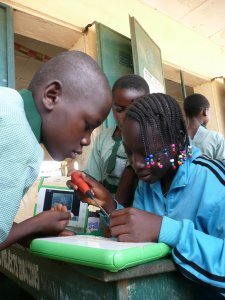
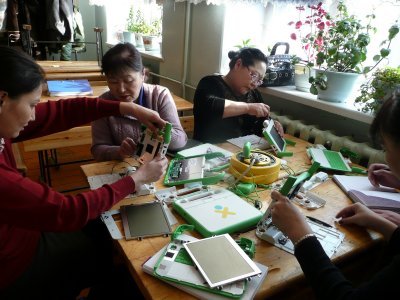
Photo descriptions and credits:
Lessons from Paraguay 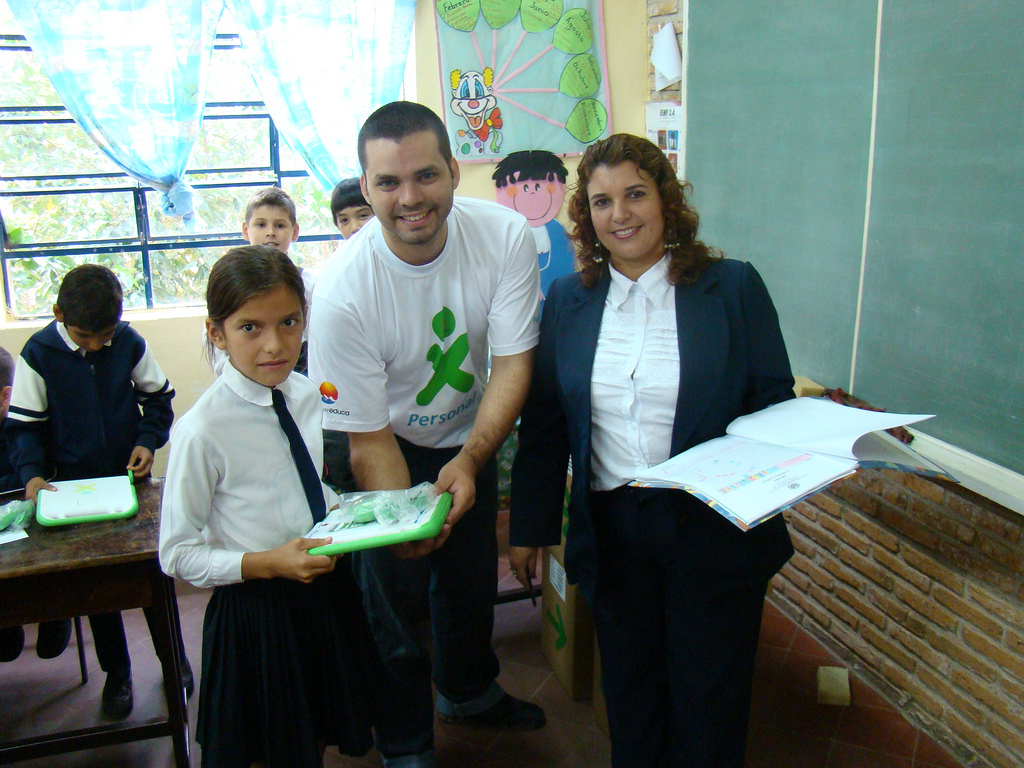
Handing a XO to to a Child in a Classroom is only the Beginning
It's the reward after a lot of planning and months of work. In Paraguay one of the first steps was to obtain a National ID's (legally recognized names) for each child. Normally this does not happen until much later in the student's career.
In Paraguay, as small part of the larger task of identifying, tracking owners, and managing XO's, the planners decided to add a second label with the student's name in addition to the barcoded serial number in the battery cavity. (The serial number is also stored in the memory of the XO.) Even in smaller deployments, planners should think about how to uniquely identify students and keep the records to identify the laptop owners.
Dealing with Quantities
Adding a label with the student's name is just a small part of the initial tasks. Though simple in concept adding labels can be a daunting. Below is a picture of the process.
Updating the software is another critical task. Whenever there is a new release of the software, the XO's that have already been produced need to be upgraded to the latest software version.
In the Paraguay deployment, the planners added changes to the OLPC released software. The XO "nand blaster" designed to make classroom deployments easier is shown in use here updating the computer programs on all of the XOs at the same time.
Connection to the Internet
The planners in Paraguay were fortunate to have internet availability in most of the schools. But this is a topic that will require attention in even the smallest deployment.
Teacher Training
Do teachers know all they need to use XO's in the classrooms, and answer all the inevitable questions? In Paraguay, there was an extensive effort to identify critical skills and to pass them on to classroom teachers. Teachers need to learn about the Sugar desktop and the Activities which come loaded from the factory.
Student and Community Outreach
Then there's the need to prepare the ground with parents, and students. In Paraguay, there were extensive efforts to involve the community, with speeches, celebrations, and school wide gatherings to explain to families how to take advantage of this new tool.
Origins of the Paraguay Deployment
The Paraguayan project started in 2007 when a university class ran a pilot project in the local community. This was a success and spurred interest from others. In 2008, an official Paraguayan non-governmental organization was created. It received donations to fund the project, and obtained permission from the government to enter the schools to implement the project. Effective media outreach resulted in the project typically being mentioned in the major national newspapers several times a week, including frequent front-page stories and editorial publications.
In April - June of 2009, this group distributed 4000 laptops which covers about 50% of the children aged 6-12 in Caacupé.
How is an XO deployment like an Iceberg?
There is a lot of invisible preparation required for a successful deployment. This preparation, if it requires facilities, network infrastructure, or technical expertise, can more than double the cost of a small project. How much of this can be done by dedicated volunteers? Networking and community building skills will help take advantage of local resources and lower the overall costs.
Many Small Deployments Challenge OLPC Oceania
Imagine a country with a population of just under 13,000 people living on a 8.1 sq. mi. (21 sq.km.) island located in the South Pacific 185 mi. (300 km.) from their nearest Micronesian island neighbor. This is the country of Nauru, the world's smallest island nation.
Nauru is just a small part of a group of 21 out of 26 island nations with 1.7 million children aged 6-12, that have embraced the OLPC laptop. Children in Nauru are among the first to receive their XOs in a pilot program for OLPC Oceania. In the program, OLPC donated 5000 machines and expert staff to support the deployments.
The pilots began in 2008 with Nauru, Niue, Solomon Islands, Papua New Guinea and Vanuatu in the initial roll-out. They plan to include Federated States of Micronesia, Fiji, Republic of Marshall Islands, Palau, Samoa, Tokelau, Tonga and Tuvalu in 2009-2010. The goal is to have "One Laptop per Pacific Child" in all 21 participating nations by 2015.
David Leeming, an educational consultant working with OLPC Oceania has some interesting things to tell about the challenges of bringing the XO Laptops to this small, remote nation.
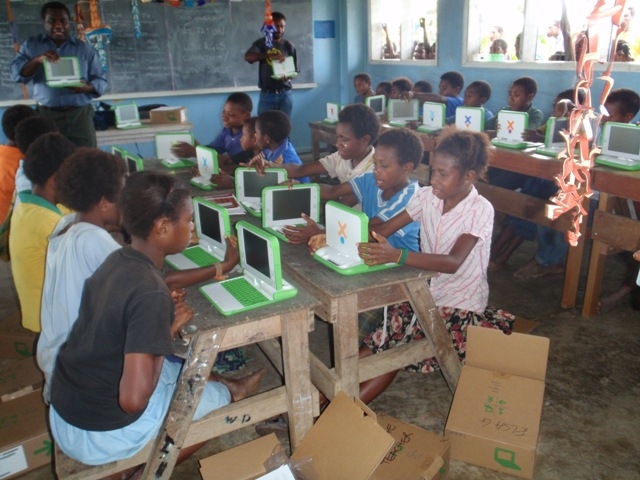 |
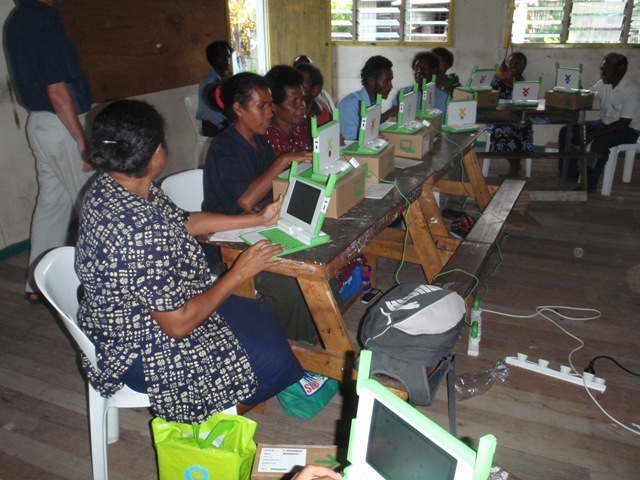 |
|
Each Child Receives An XO!
Drekkir Primary School,
East Sepik Province, near Wewak.
|
Teacher Training on XOs in Gaire. |
Teacher Training
Leeming stresses the need for starting with teacher training to get them over the "learning “hump”. Then they will be ready to assist their students in learning to turn on their XOs, open and close Activities, connect to the mesh, and do other simple tasks to use their XOs.
School Server
Leeming also recommends the school server (XS) for larger classes. In smaller classes the mesh and a possible internet source are sufficient. Thie school server is nothing more than an extra computer running special software to store content and share the internet with a large group of student laptops. It will also provide reliable collaboration for over 30 laptops, web caching, extra content on the server-side, and an automated backup of all the XOs.
The software to do this is free, but will probably require a technician to install and do the set up.
When the server is in place, students can access it with their XOs to use the internet or access stored content. Students can also store their work and finished projects there.
Solar Power
Finding a power source is a challenge some remote areas, and Leeming and others have worked with this in Oceania. On Nauru, he has successfully experimented with the use of solar power in one of the classrooms. He tells how he used his experience with solar power in Papua New Guinea to implement this,
"In a 1000-XO trial in PNG in which I have advised, we decided to go 100% with DC share and 15W flexible GoldPeak panels with small capacitors integrated to avoid a oscillation problem. The cost is much reduced over having battery storage, and the laptops can be used whilst being charged. Others advocate the use of 20W panels if possible."
(Not part of text-Resource note: photos of the solar powered classroom on Nauru can be found at: http://wiki.laptop.org/images/1/1a/Nauru_deployment.pdf)
How the XOs are Used
Leeming has also addressed the issue of how the XOs are actually used by the students and teachers in their classrooms. He says,
"We want the XO laptops to improve quality and productivity and not to serve as a distraction. If in the analysis the XO doesn’t have a positive effect, then they stay firmly shut.
"Likewise, pen and paper might in some/many circumstances be the correct tool to use. For instance, if we are learning about graphs, then a picture flashing up on a screen might not achieve the same effect as if the children have to conceptualise and draw the graph by hand. Of course, the computer can provide tools to help draw graphs too.
"On the other hand, if we are learning about trends and comparing patterns of things using graphs, then the computer can be very useful in improving productivity by providing the framework. You need to understand the framework, but that can be taught separately. A class of 40 grade 2s might take all lesson just to draw a graph, when the objective is to learn from the DATA.
"In Nauru during the training the children were learning about “services in the community”. The teacher, Lavina, wanted them to do a survey of their family members and relatives to see “where they bought their fish”. The XO has in it a program called Poll Activity. It creates bar charts with percentages from a simple multiple choice poll that is very easy to set up.
"Lavina wrote the poll question and multiple choice responses on the board and in no time at all the children had entered it in their laptops. They could then take them home and do the poll with their families and bring back the results next day. This would be VERY hard for grade 2 students to do by hand. The idea would be to look at each other’s results displayed by the XO graphically, and to learn from patterns in the data – i.e. the focus is on learning about “services in the community” and not about what a bar graph is – a separate lesson with pen and paper would achieve that learning objective."  Everyone Wants To See The XOs. Children Not In School, Now Want To Come To School!
Everyone Wants To See The XOs. Children Not In School, Now Want To Come To School!
Kenya OLPCorps Story
Kibwezi Team
By David Norman and Greg Gates

Lesson Learned
Teachers in the United States and other countries should not be intimidated by XO laptops and the challenge to maintain a standardised curriculum. Westerns should respect the local teaching styles, adaptation to computer learning comes about slowly, and with great results.
In Kenya, teaching is literally "rote" or wrote, meaning lessons are written on the black board by the teacher. Students copy the lessons into their notebooks and memorize the facts and statements. These are the educational techniques used in the Imani Primary School. Student notebooks are turned into the teachers for grading and then redistributed. If a teacher wants to add a lesson plan to the student notebooks, he/she will simply go through every notebook and copy the lesson into it by hand. Kenya is a very hierarchical society, and the students generally show great respect for their teachers. Each student within a classroom is ranked relative to his/her peers based on previous test scores. This "class rank" is posted in the front of the room for all to see. A student's success in the Kenyan education system is based on the national exams given to all students in standard (or grade) eight. The ranking of these exams and the results of the preparatory test are very important. In addition to the educational hierarchy within the classroom, teachers are equipped with switches that they use to hit students who are out of line. This generally increases the teacher's control of the classroom and further establishes rank among the students.
Upon first entering this environment, my two colleagues and I were immediately perplexed. "Wow, how are we supposed to foster free-thinking and creative learning in this environment?" The answer was to adapt to the African culture. We realized that it was necessary to slow down and let the African teachers and students slowly soak-in the technology until they took ownership.
An Early Introduction to XO
We first visited Kibwezi in July 2008, one year before the larger deployment in 2009. A group of Americans from Burke Presbyterian Church brought six XO computers the the Imani Primary School in Kibwezi. We introduced the six teachers to the XO and then left them to experiment on their own for one year. When we returned in July 2009, the six teachers were proficient and self-taught. The school principal was so enthusiastic about receiving 100 new XO computers that she had set aside one hour periods for every class to utilize the XOs. The school had a population of close to 400, so instead of "one laptop per child," there was "one laptop per four children." Nonetheless, the growth from 6 to 100 computers was significant after only one year.
Expanding to New Audiences
There is a vocational polytechnic co-located on the grounds of the Africa Kibwezi Educational Center. We held activity nights for students between the ages of 18 and 25. The activity nights gave these young adults a chance to explore the XOs, giving them a chance to use computers for the first time in their lives. Sometimes, the students were not as literate as their younger counterparts, but that didn't seem to matter. Anonymous "Question and Answer" sessions via chat were very popular. Discussions commonly focused on social taboos in Africa and the difference between cultures, such as dating practices in the United States and the spread of HIV.
Maintaining a Connection (A Service Contract, Not a One-Time Sale)
One mad-dash deployment is not enough. It really takes multiple visits to "train the trainer". Our first trip in 2008 was an experiment. We only observed teacher reaction. It was during the second visit that we dealt with customs inspectors and logistics. the challenge during the second visit was not getting a school server to function appropriately. Therefore, we brought it home for servicing. Our group has committed to sending American visitors throughout the year to the Kibwezi school. Considerably, we will adapt to the 1.5 version of the XO computer and find a way to connect the school server to a future high-speed Internet service . Finding a way to make that happen is another endeavour. We are looking into finding a high speed service whether through satellite connectivity or in future fiber optic cable. We are preparing for the future before it is here. That is the way to succeed in partnership with both OLPC and the Imani School. David Norman has joined the OLPC Learning Club - DC to maintain an awareness of updates and changing technology. Having a support network among users is vital and should be emulated by the other OLPCorps deployment schools in Kenya.
The team from Burke Virginia included a mix of students from three East Coast Universities. Greg Gates from Virginia Tech, Krista Yancey from Bucknell, and Kate Tidaback the College of William and Mary. David Norman acted as an adult advisor who helped facilitate logistics.
Blog: http://olpckibwezi.blogspot.com/
Using the XO for classroom-based learning
A cookbook collection of techniques for including the XO
in class room learning with exercises and ideas for future lesson plans.
by Yamandu Ploskonka, Caryl Bigenho and Jerry W.,
edited by Adam Holt, Sandra Thaxter and the Support Gang
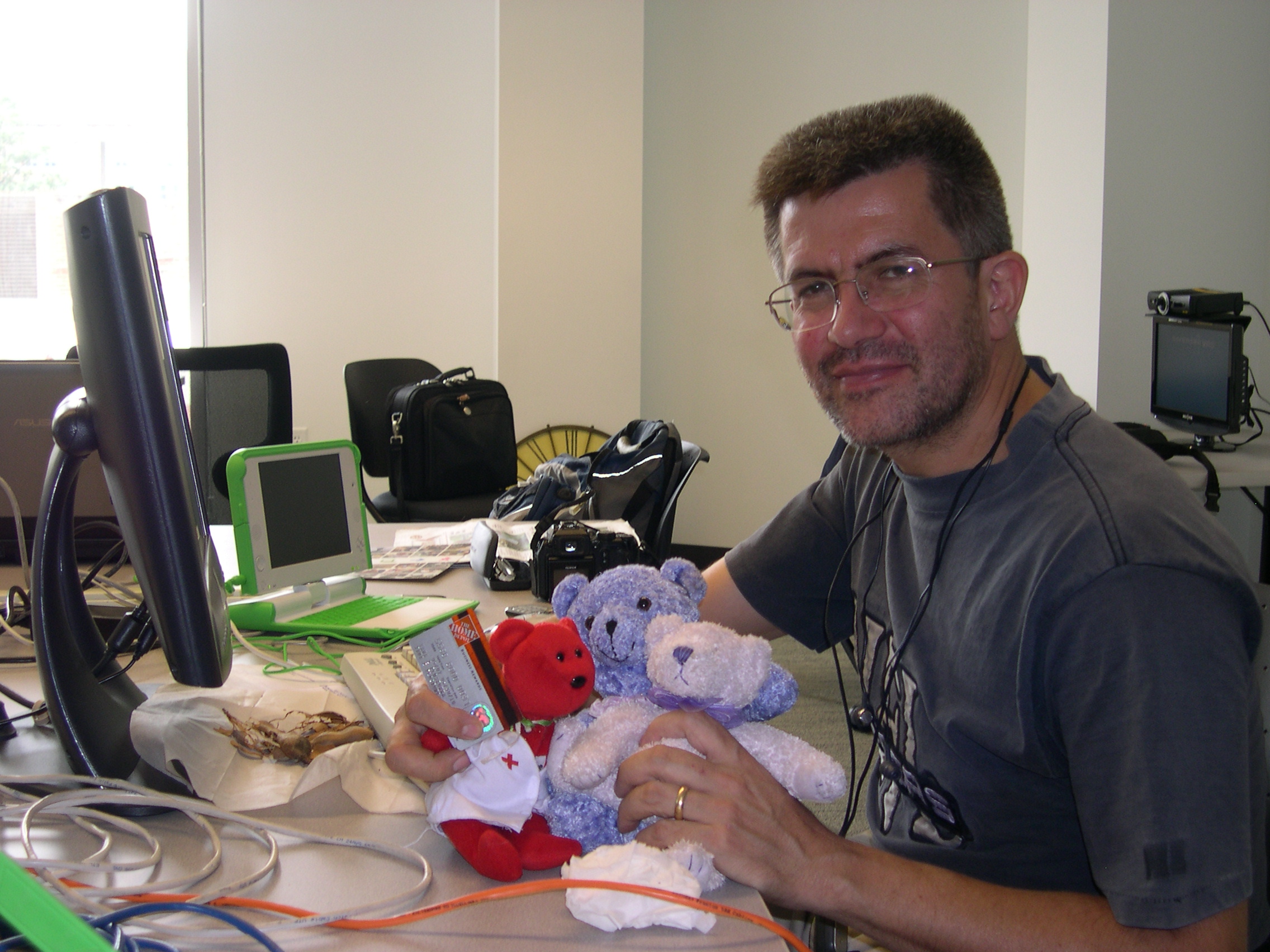
Author Yama @ ClassActs with some little actors by JerryW
XOs arrive pre-loaded with the child-friendly Sugar operating system. It provides programs, called "Activities" for many learning situations along with a browser to explore the internet and a library of other resources. These resources can be very helpful, even if an internet connection is not available. In addition, there is a very large library of other Activities that can be downloaded at no charge to add to the ones already on the laptop.
Some of the Activities in Sugar are very specialized, but others such as Write (the word processing program), and Record (the program for recording video, still photos, and sound) can be utilized by students and teachers in many subject areas. Here is just a sampling of some of the ways teachers have used various Activities with their students. We hope they will inspire you with ideas you can use with your own students. Most of the Activities and their uses discussed here can be done without any additional hardware or software downloads or modifications. Others that go be beyond the basic included software will be shown in italics. Sugar Activity names are in Bold.
Using The Help Activity
Before trying the Activities, it is a good idea to read the Manual. "What manual?", you say. "There isn't any manual in the box". But there is. It is in the XO. Just charge the batteries, open the XO, turn it on, and open the Help Activity (the circle with the "?" in it). It opens the FLOSS manual which will tell you just about everything you need to get started.
But, what if you need help charging, opening, and turning on the XO? The entire manual is also available online. You can access it from another computer at:
http://en.flossmanuals.net/read
Using The Built-In Wikipedia
The XO comes with a small, self-contained version of Wikipedia. If you do not have internet available or your school does not allow students to go online, they can still do research for school projects using this built-in encyclopedia. To use it, click on the book with the "W" on it to open the Activity. This will take you to the portal page.
On the portal page, you will find eight broad categories: Science, Social Science, Humanities, Technology, Science, Culture, Mathematics, Earth and Geography. Each of these, in turn, is broken down into many sub-categories. When you click on one of the sub-categories, it will take you to an introductory article about that subject. The article will be filled with links, shown in blue, that you can use to explore the subject further.
Researching and Writing a Report
Students can use Wikipedia to get information and pictures for reports in any subject area. The XO does have the ability to copy (highlight, then ctrl-c) from a source and paste it into a Write Document. After copying the text in Wikipedia, return to the Home view and open Write. There will be a little page icon at the top with a downward pointing arrow. Click on it and the text will be pasted in. Students should read the pasted text and rewrite it in their own words. This is a good time to talk about plagiarism and proper crediting of their sources.
Printing
Sometimes you will want to print copies of students' work. There are some printers that can be used with the XO and connect with a USB cable. But most printers will not work. For more information about configuring a printer for the XO see:
http://wiki.laptop.org/go/Printing
There are two easy ways to transfer your completed files to another computer and print them out.
Using A USB Drive
In the Activity you wish to save, click on the Journal icon on the top right to "keep" the file in the Journal. Close the Activity. Insert a USB drive in any one of the three USB ports. Go to Home View and open the Journal. Drag the icon for the Activity that has the file to the icon of the USB drive on the bottom left. It will "move" the file to the drive. When it stops flashing and says "unmounting", and you can safely remove the USB drive.
Take the USB drive to your other computer (that has a printer), insert, open the file and print. These files can usually be opened with your text editing program or image browser.
Attach The File An Email To Yourself, Open On Another Computer, and Print
Open the Browse Activity and go to your e-mail account. Start a new message. Write yourself a short message reminding you of what you are attaching to the email.
Next, attach the file you want to send. Your e-mail should have something that says "Attach files" or something similar. Select it. It offers you the opportunity to "Browse" (they are referring to looking for the photo, not to the Browse Activity). Click that. It opens the Journal page for you. Select the file you want and click on it. Then click "Attach". It is then ready to send with your e-mail.
Then send it. Go to another computer that has a printer, open the email, download the file, open it and print it.
Language Arts
Before beginning the Language Arts lessons, the teacher should read and try basic Getting Started sections of the FLOSS manuals for the Write, Chat, Browse, and Record Activities
A Simple Story or Poem
This is often one of the first lessons students do with the XOs. As soon as they have learned to start their laptops and open an Activity, they can open
Write and begin to write an original story or poem. When they are happy with it, they can read it aloud for the other students.
Variation: A Story with Pictures
When students have learned to use the
Record Activity, the
Paint Activity, or the
Browse Activity, they can use a photo they have taken, a picture they have drawn, or a picture or graphic from the internet and paste it into the
Write Activity to illustrate the story or poem they write.
Variation: Writing About Another Subject
Using the same techniques, students can write and illustrate reports for science, art, music, history, or almost any other subject.
Chat
Students love the
Chat Activity. It is just like IM (Instant Messaging). With teacher supervision, it can be excellent for practicing writing skills. It is also a very good introduction to sharing an Activity via the mesh feature of the XOs.
Variation: Collaborating on a Project via Chat
Students can use the
Chat Activity to collaborate on any assignment they might be working on even if it doesn't require the XO.
Collaborating to Write A Story, Play, or Research Report
Once the students have learned to use
Write and to collaborate via the mesh, they can begin to work as a team on projects such as stories, plays, and research projects. Just give them the assignment, have them open the Activities they need and connect via the mesh to share their desktops.
Variation: Recording A Play
When the students finish writing their play, they can make a short "radio show" with the Audio mode of the Record Activity, or as a short "TV Show" with the Video mode of Record. Costumes and simple sets can be added to make the video recording more interesting and fun. The completed recordings can be dragged from the Journal to the icon of a plugged-in usb stick and saved there or shared.
Reading With the Help of Speak
Students who are having trouble learning to read can get help with the Speak Activity. Just open the Speak Activity. When they type the word they want to hear in the space at the bottom, the voice will pronounce the word correctly for them. They can change the face to have regular round eyes or rectangular glasses by clicking on "Face" and using the pull down button on the right. They can also change to mouth to show a waveform or frequency pattern by using the pull down button on the left. They can also change the number of eyes with the slider bar.
Variation: Help Learning Another Language
Speak is multi-lingual! Simply click on the "Voice" button and use the pull down menu to choose the language (or accent for English) that you want to hear. Then type in the word, hit "enter", and listen to the word pronounced in that language (or accent). You can hear the word repeated as many times as you like by pressing enter (check mark on US keyboard). Fun: type an English word and have it pronounced with a variety of accents
Math

The Activities that come pre-installed on the XO offer a variety of possible math lessons. Here are a few suggestions about ways to use some of them.
Learning to Use A Ruler
The Ruler Activity is based on the metric system and offers accurate 1 cm (centimeter) units on the XO screen. There is a normal ruler with 1 cm divisions broken down into mm (millimeter). Students can measure small objects by holding them up to the screen for comparison with the ruler. They can learn how to write the measurement correctly with the format 0.0 cm.
Discovering Multiplication Facts With Ruler
The Ruler Activity also includes grids with 1 cm squares, 1 mm squares, and alternating black and white 1 cm squares. Ask students to count the squares in a rectangle that is 6 squares long and 4 squares wide. Have them write it on their paper as 6x4=24. Then have them repeat with a rectangle that is 4 squares wide and 6 squares tall. Have them write it on their paper as 4x6=24. Ask them if they notice anything. Repeat with other combinations. They should soon discover that AxB=BxA. You could have them construct their own multiplication tables by discovering the facts in this way.
Variation: Modify for Imperial (US/GB)
Metric system is widely used in the world, but not the only measurement system. Convert to Inches, Feet, Yards, Miles, etc. Convert backwards. Modify Ruler Activity to have that option or setting.
Dividing Up A Circle With Ruler
A full circular protractor is included in Ruler along with an enlarged 1/4 circle where the single degree marks are easier to see. This could be used for finding out about how circles are divided up. Show the students a right angle. Ask them to use the protractor to find out how many degrees are in a right angle. Ask them how many are in a whole circle. See if they can figure out how to do it without counting all 360 degrees.
Review Facts With Memorize
Children really enjoy the Memorize Activity. It is is similar to the children's card game cards with pictures are laid out face down on a grid. There are two of each. A player turns two up. If they match, they get to keep them. If not they are turned face down and then the other player tries to get a matching pair.
In Memorize, a grid of squares appears. The player clicks on two of them. If they match, they stay right side up and the player gets credit for them. The pairs can be things like 4+7 and 11, 5x6 and 30, 6 and VI, 4 and four. The Activity comes with demo games and the ability to create any other matching pairs you want.
The games that are created can be saved by clicking on the third icon from the left (it shows an arrow going from a little grid to a little book, the Journal). To bring the game back and play it, Open the Play tab, click on the second tab from the left which will show the name of the game. Choose it to load.
This Memorize activity can be shared with the mesh so that the students can enjoy competitive play. There is no limit to the kinds of pairs that can be created. Mix and match operations, import and add pictures and sounds recorded in Record, created in Paint, or imported from other resources.
Variation: Learning To Count
For very young children, the teacher can create pairs for the games using pictures they draw in Paint, such as three stars matched with "3", one flower with 1, six arrows with 6, and so forth. Pictures could also be imported from Record or other resources.
Speak Activity will also say the numbers typed in to the keyboard and if you start with a 0 (Zero) will spell out the numbers.
Discover Math Principles With Calculate
The Calculate Activity is a regular multi-function calculator. There are Algebra, Trigonometry (sine, cosine, etc), Boolean, and Constants (pi, e?) categories available. Encourage students to experiment with combinations to see what is the same and what is different. Before doing this, students should have some paper and pencil experience with a number line so that they know what negative numbers are.
For example, have them try 4+3 and 3+4, then 4-3 and 3-4. Have them record their problems on paper. Look at the results. Repeat with other combinations. What conclusions can they draw from their results? Can they make up a rule that describes their results? Students can share and collaborate on this. Later teams can compare their conclusions and rules.
Finances
Money is also considered in numbers, and therefore math. Creating a budget, adding up one's current balance, and planning expenses, may help in empowering children and adults out of a cycle of poverty.
Variation: Install SugarLabs Activities Finance and SocialCalc
Installing an extra http://SugarLabs.org activities called Finance
http://activities.sugarlabs.org/en-US/sugar/addon/4040,
or beta SocialCalc,
or grind out in Calculate and Keep the results. Track progress over time. Make Pie charts and graphics of proportions of money spent on housing, food, clothing, medical, transportation, church and charitable donations. Learn typical percentages. Compare locally and internationally.
Sciences
The XO offers many interesting and exciting Activities that can be used in Science. Adding peripherals can make it a useful and interesting tool for doing lab experiments.
Measure Activity
Seeing Sound With Measure
The XO computer has a built-in oscilloscope in the Measure activity. The red microphone jack on the left side of the display (facing a computer as in normal use) under the antennae ears will accept some other electrical signals but check with an electronics technician to be sure the exact circuitry.

GIMP edit of sticker photo by JerryW
Measure In the Lab
XOExplosion.com sells a temperature thermometer plugin to the Microphone amd USB jacks in unassembled kit and completed form. A description is also on the wiki.laptop.org website http://wiki.laptop.org/go/Measure/Start http://wiki.laptop.org/go/Measure#Measure_Temperature .
There are many interesting experiments using Measure on our wiki at: http://wiki.laptop.org/go/Measure#Teachers_guide_to_Measure
There area also instructions for making several different types of sensors at:
http://wiki.laptop.org/go/Making_XO_sensors/How_to_connect_sensors
Be sure to see the links to the various sensors at the bottom of the wiki page.
Here are two experiments with sound that can be done without any added peripherals:
A Simple Experiment In Seeing Sound
Collect a variety of objects that can be used to make a sound by striking them or blowing on then (like a wind instrument, a glass, a piece of wood, or a piece of metal). Have students first experiment a bit with the oscilloscope by whistling, tapping on a table or desk, clapping their hands and so forth. Have them sketch what they saw on the XO screen. Then ask them to predict what kind of wave form the objects that will be tested will have. Ask then to also draw their prediction. Then test their predictions by making the sounds and have them draw the actual kind of waves they saw in another color over their predictions. What conclusions can they draw about the types of wave forms produced by different materials. Ask why they think this happens. Accept any valid speculation.
Variation: See the changes in the wave form as the pitch changes.
Do the same procedure with sounds made by a musical instrument. This can be any instrument that can play different notes, like a scale... even an XO running TamTamMini could be used! Before they open Measure, play a few high and low notes on the instrument. Ask the students what they think the wave forms will look like. Have them draw their predictions. This would also be a good place to discuss "high" notes and "low" notes.
Then repeat the above Seeing Sound experiment (above), again asking the students to make predictions before they see the wave forms on the oscilloscope. Students again draw the results over their predictions. Discuss the results.
How do the higher and lower wave forms differ? You might point out at this time that they are not only "higher" and "lower" on the traditional five-line musical staff, but also are of "higher" and "lower" frequency.
You could have the students follow up by using the built in Wikipedia to find out what other types of waves there are (such as radio waves, light wave, and even ocean waves!
Disability Exercise

http://wiki.laptop.org/images/thumb/f/fa/ECG_icon.svg/120px-ECG_icon.svg.png
Cover or carefully plug ears (with supervision), make sounds and see what it would be like to just see sounds on Measure, instead of hearing them, as if you are deaf.
Variation: Advanced Communications Development
Program the Speak Activity to manually sign language the letters typed instead of sound output (i.e. a sign language output driver). Apply across all XO Activities for accessibility and inclusion. Research and learn about the deaf community. Write a report about it. Sign the report to the class. Have an interpreter team translate. Seek and include other deaf children and adults in activities.
Variation: Advanced Disability Sensitivity
Cover eyes and try to use the XO. With others and supervision, cover eyes with a blindfold, scarf or hands and try to move about the classroom. The first kid/adult to criticize is the next up to try it. Try using a long stick as a cane. Discuss what helped while not seeing, and what hurt (bumps, bruises, name calling, auditory signals, whatever). Speculate what it would be like to be blind all the time. Discuss what it would be like to learn from never having seen. Be sensitive to others with challenges and differences.
Moon Activity
The phases of the moon and other data are available in the Moon Activity. Students can access this to see what the moon would look like tonight through a telescope. They could then go to the built-in Wikipedia and look up why the moon has phases.
Physics
The Python programming language has physics libraries that you can create objects and the computer will calculate the gravity, forces, motion, etc. A young student might be asked to guess where an object you move would go. Compare against what happens in the activity, and in real life. A Sugar Activity exists online http://wiki.sugarlabs.org/go/Activities/Physics contains more info.
Social Sciences
In addition to the obvious researching and report preparation discussed in the Wikipedia section above, there are other projects that students can do well using the XO as a tool. Here are a few suggestions.
Interviewing Family Member

http://wiki.laptop.org/images/a/a2/AudioBooksXO.png
If students can take their XO home, they can choose a family member to interview on a subject the class is studying. The Record Activity is perfect for making either Audio or Video recordings of the interviews. Students can include a photo of the interviewee, also taken with Record. Possible topics, assigned by the teacher, for the interviews could be occupations, childhood memories, favorite pets, historical events they would remember, or interesting places they have been, like "what I did over my summer vacation".
If they have made audio interviews, students can work in teams to transcribe the recordings they have into a project in Write and add the photos they have taken. They might also research the topics of their interviews and write a little background information about the topic.
Variation: Interviewing An Historical Character
Students can research an historical character then prepare an interview with costumes and setting. They can use Record to preserve their interview.
Re-enacting An Historical Event

Adam working hard @ ClassActs Sprint by JerryW
Students research an historical event, collaborate to write a script, prepare costumes and sets and practice, practice, practice. When they are ready for "show time," Record the event using the Record Activity.
Making An Historical TV News Show
Students do in depth research about a chosen date in history. Then assign roles such as news anchors, field reporters, sports casters, weather persons, and maybe even a gossip reporter. They then collaborate in Write to prepare the script for the news show. Costumes, sets, and practice are in order next. When ready, their "camera operator" records their show. After completion, teams can share their news programs with the rest of the class.
Designing A Social Experiment
Since the XO is a networked machine, groups of people interacting might make an interesting social experiment. Introduce this machine into remote environments, and see if you can effect global education change. Write up the experience, and get a Ph.D. at some university.

http://wiki.laptop.org/go/Image:Xo-education.svg
Music

http://wiki.laptop.org/images/thumb/e/e0/MusicXOLogo.svg/84px-MusicXOLogo.svg.png
TamTam Mini is the starting application for music. Younger children can click on images of animals (cat, cow, dog, duck, etc), insects, babies, kids and musical instruments to play a pre-recorded sound those objects would make. A band of various international themes is available, and once selected, the play (arrow) button will start the background orchestra.
TamTam Jam is the Activity for performing music. It includes a mesh-shareable drum function so that children can collaborate in playing in a group. They have a wide choice of instruments or sounds including many folk instruments from all over the world. They can select the instrument they want to try and touch a few keys to see what it will sound like. You can hear an example of a TamTam "band" in Thailand here: http://www.youtube.com/watch?v=ZafVLAbFM1A
TamTamEdit allows the player to create and save up to five virtual "tracks" of music. It allows the player/composer to choose from a variety of scales and instruments, to overlay the tracks, and save the results for later playback of their compositions.
TamTamSynthLab is an advanced application for older children who are ready to venture into sophisticated sound design. synthLab is a physics lab and sound synthesiser modelled on the Max/MSP.
Make A Music Video
Students can choose a song (or write one of their own) and use it to make a music video. They can play it on TamTamJam or save and playback with TamTamEdit. After practicing, they can use the Record Activity to make their video. For variety, they can use different costumes and backgrounds.
Variation: Make Music Video Featuring An Historical song.
Follow the same procedure as the music video but choose an historical song or write one on an historical theme. Students can research costumes, instruments, and sets that would be appropriate for the time they are studying.
Variation: Make a PSA
Students can choose a topic and create and record a Public Service Announcement featuring music, dance, and other creative things they may want to add. TamTam can provide the instrumental background and the video can be made in Record.
Visual Arts

Penguins by Owen Davies
Paint Activity allows basic drawing.
Pippy has some fractal tree drawing examples with source code to run examples.
Custom programming in EToys, Scratch, TurtleArt, and other languages like Python can be used to create an almost endless array of images.
Photography with the built in camera and video could be modified by Paint programs to create images.
Other Fedora programs are downloadable with Yum, but will not be the usual Sugar interface and you can quickly use up your "disk" memory on all the free software available in repositories.
The above penguin drawing was created with Inkscape, one such program.
Blender (http://en.flossmanuals.net/blender) is in the Fedora OLPC Yum repositories for those wishing to try 3D animation, modelling and rendering, though may be resource intensive.
Make A Greeting Card
Students can make greeting cards with original art created in Paint. Photos from Record can be copied and pasted into Paint and decorated. These can be sent as e-cards to friends and family.
Variation: Make and Print A Greeting Card
If you have access to a printer, transfer the completed card to another computer and print it.
Variation: Make and Print a Poster or Flyer
Students can follow the same procedure, moving their art work to Write for layout and adding text. Then they can transfer to a computer and printer for production.
Have A Photo Contest
Have students take their computers out and take photos for a contest. You may want to have them follow a theme, such as My Neighborhood, people at work, pets, or something similar.
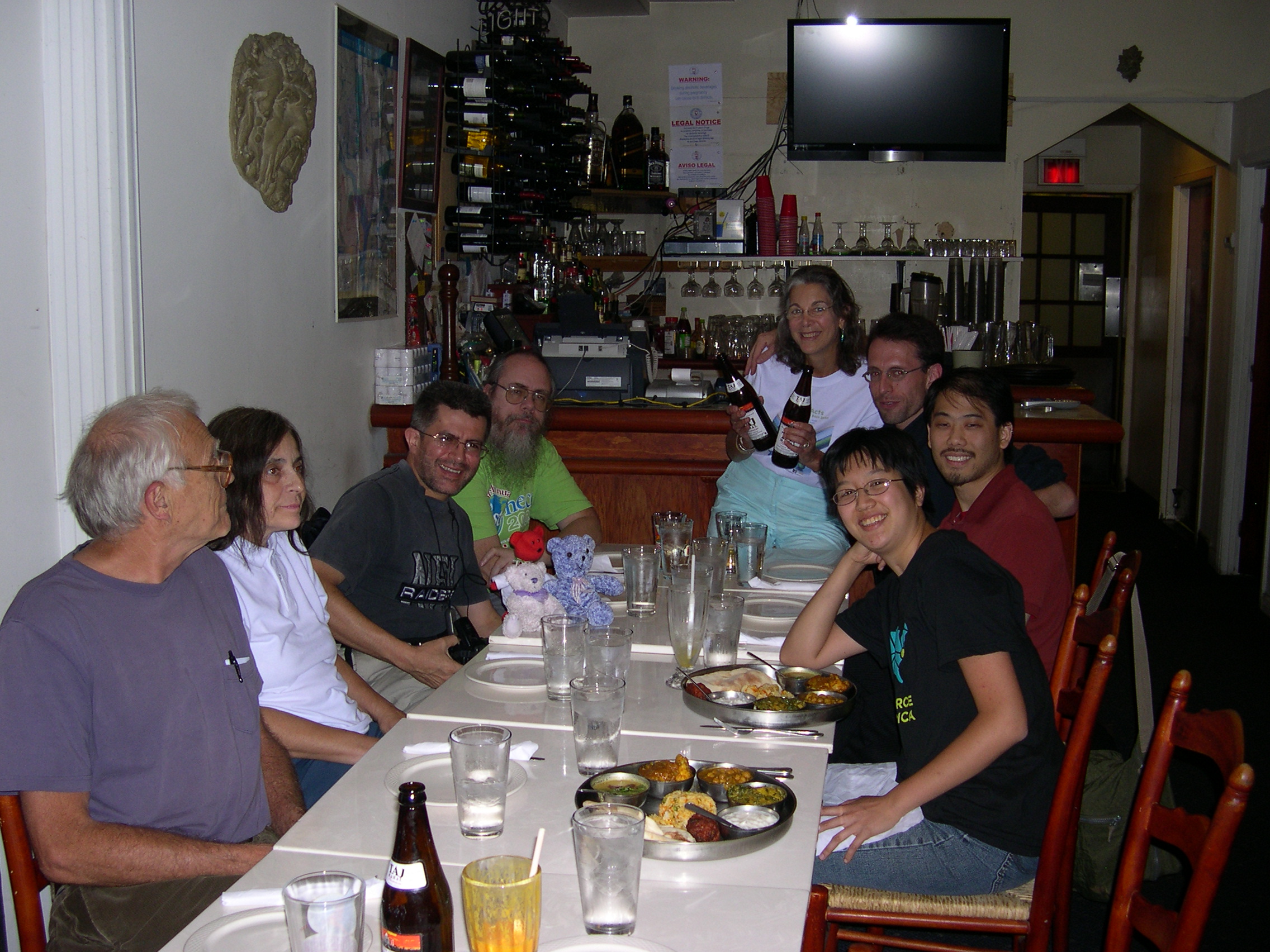
ClassActs Sprint @ Taste of India, Washington, DC, USA by JerryW
Computer Science
Etoys
Etoys graphics involves making scripts for objects to move around and animate. The environment is highly graphical and engaging for young students. Research SmallTalk and compare.
TurtleArt
TurtleArt teaches some programming by graphically snapping together parts to make a turtle that moves and creates shapes.
Geometry and other step by step algorithmic thinking may be learned this way. Logo, an original programming language for young students might be an interesting comparisons for a child's book report on languages.
Scratch
Scratch programming language is a blocked visual language for younger children before perhaps learning Pippy/ Python's code based language. Students enjoy animating characters, modifying their looks, and having them move and talk on the desktop stage.
See an example of Scratch implementation and use in http://en.flossmanuals.net/bin/view/ClassActs/IfTheyThinkItsAVideoGameWhyTellEmItsProgramming:PTAScratchEnrichmentProgram
Pippy
Pippy shows example program's Python ( http://www.python.org/ ) code and allows changes in a mini development environment for execution and editing.
For example, in the Pong program, students can study the code, learn some Python, change the paddle size, number of balls thrown out, perhaps the speed of the game, the colors of the paddles, background, etc by changing some variables. Speeding up the motion would be an exercise for an advanced programmer, though with the newer XO-1.5, it may operate differently.
Further study can be obtained at http://www.python.org/workshops/2000-01/proceedings/papers/elkner/pyYHS.html and elsewhere on the internet.
Terminal Mode
While advanced, the XO uses Redhat's Fedora Linux operating system, and the Terminal Activity will take a student into the Linux/Unix Bash command line prompt (try "ls", "more <somefilename>", "cal", "cd <somedir>", "date", "cal", "pstree", "top" then press "z", "who", ), where they can learn Free Software Foundation's GNU/Linux commands for file operations, system administration (installing and backing up machines "tar -cvf archive.tar <somedir>"), networking (connecting between machines, wireless or wired, try "ifconfig", "iwconfig"), programming (shell, Python, awk, sed. perl) and many other Fedora applications which may not have been "Sugarized".. Analyze and Log Activities show some of what is in going on in the background/ "under the hood" with the mechanics of the XO machine. See and other http://FlossManuals.net Terminal and GNULinux manuals for Linux training materials.
Interdisciplinary
Creative combinations of the other fields are what the XO and OLPC is about. Students can combine a variety of subject areas and Activities to complete a major project. For example, suppose the subject is Sound Waves. Students can use TamTamMini to create sounds and study their wave patterns as described above in the Science category. They could use another XO to Record the results of their experiment. If math is involved in the report, they can use Calculate. Then, using the built in Wikipedia activity or the online version (with Browse) if they have internet access, they can research some of the history of the study of the physics of sound and collaborate in Write to complete a report.
Two excellent interdisciplinary lesson plans using the XO with sensors can be seen at:
http://wiki.laptop.org/go/Image:XO-Measure-Manipulate-Reflect.pdf
http://wiki.laptop.org/go/Image:XO-MyCommunity.pdf
Community Book Sprint
Like the book you are currently reading, which was created by a book sprint described by
(canonical book sprint links here), your school and/ or community can create a book about the history of your community, culture and geographic area, the people, places and events that make it special, and report out to the world why it's so great, what the challenges are, before and after the XO's were introduced.
Variation: Create a School Newspaper using the XOs
As a journalism exercise, your class or school can create a small newspaper, either online or in print, and write about events in your community. Some things might be guest speakers, issues going on in the community, environmental or political, interesting people and personalities, sports events (organized or in the neighborhood/ village), weather reporting (rains and/or drought effecting various parts of life), educational policies and practices (but be careful about some of the things you say, and fact check to make sure it's accurate, relying on multiple sources of information, and not jumping to conclusions), as learning about journalistic ethics (what is fair and balanced, just as anything you say about anyone else verbally gets amplified by having multiple copies in print or online out there), and how your area fits into the global picture.
Variation: Blog about the world
XO's can also be used to blog (web log, like a journalistic diary) about personal issues that individuals face in your community. Be careful not to be too personal, and have adults, parents and teachers, set limits and guidelines on what is appropriate to share with the rest of the internet connected world. Write something about the other sites you see and the best and worst parts of online culture(s).
Measure Lets Students Do Real Science Experiments
"I hear and I forget. I see and I remember. I do and I understand."... Usually attributed to Confucius
Adventurous science teachers will love the Measure Activity. Using Measure with all the various peripherals will allow students to perform experiments with many physical phenomena and discover for themselves some basic scientific principles.
Thinking Like Scientists
The first thing you might want to do is to give your students a head start in thinking like a scientist. I used this simple exercise with middle school students at the beginning of the semester. I would bring in a small paper bag with a little baby doll inside and ask them to guess what was in the bag. They almost never did. So I would inform them that the bag contained a model of the first scientist. Then I asked who they thought that might have been. This time there would be lots of good answers, but of course none of them right. Then take the doll out of the bag and tell them the first scientist was a baby!
Of course, they were shocked and filled with disbelief. So, together we would make a list of all the things a baby does (in addition to eat, sleep, cry, and poop!). The list would include things like ask questions, explore, experiment, come to conclusions, try new things, observe. When we had a nice long list we went back and checked which ones scientists did too. From this we developed our own version of the "scientific method" which we wrote on a big poster and put on the wall to reference all semester.
Once your students have made their plan for working like a scientist, they can be encouraged to use it create their own experiments. The XO with the Measure Activity is the perfect tool for doing this. There are many different peripherals that can be made quite easily and used with the XO to do experiments with the Measure Activity. One of the easiest to start with is probably a temperature probe.
Getting Started With a Temperature Probe
Excellent instructions for building a temperature sensor for the XO are on our wiki at:
http://wiki.laptop.org/go/Making_XO_sensors/Making_a_Temperature_Sensor
You can hunt around in electronics stores for the parts, or simply buy a kit with all the parts needed to build the probe from XOExplosion (http://xoexplosion.com/index.php?main_page=product_info&cPath=1_34&products_id=98). The kit will need to be assembled using a soldering iron.
When it is complete, there will be 2 plugs on the sensor, an audio-type plug and a USB plug. The audio plug goes into the pink Mic Jack and the USB can go into the nearest USB port. Now it is ready to use.
The next thing you will need to do is download a version of the Measure Activity that will translate the signals from the temperature probe into meaningful information on the XO screen. To do this you will need to connect your XO to the internet and go to the Measure/Download page and download the "Unstable release for LM35". Don't let the "unstable" scare you off. It just means they are still working on perfecting it.
If you need help connecting the XO to the internet and downloading, you can find it in the Help Activity or by accessing the same information online at:
http://en.flossmanuals.net/XO/GiveMeTheInternet
and
http://laptop.org/8.2.0/manual/Sugar_InstallingActivities.html
Once you have the software installed and the sensor ready to use, you can start letting students design their own experiments. Think of questions they may want to explore that have to do with temperature such as:
How does the color of a roof affect the temperature inside the house? (Hint: pieces of black, white, and other colors of paper or cloth would be handy for this experiment).
Why do they put salt on the roads in places where it snows a lot in the winter? (a good time to ask how this would affect living things in the environment. Hint: you will want to have ice, water, salt, and small containers of some sort for this one).
How does putting salt in water affect the boiling temperature? What about sugar? What about sand? Which ones made a difference? Which ones didn't? Why do you think this happens? Let students research a bit online if they like. (Be sure you have a safe source of heat for this one. No accidents and don't burn down the school).
Building And Using Other Sensors
Other sensors you can build for the XO include a Magnetic Sensor, a Thermistor (also measures temperature changes), a Humidity Sensor, a Switch Sensor, and a Light Sensor. Links to instructions for building all of these can be found at:
http://wiki.laptop.org/go/Making_XO_sensors
There is an excellent article with ideas for the use of some of them at:
http://www.olpcnews.com/software/applications/oscilloscope_children_learning.html
There are some very creative people doing some exciting things with sensors and the XOs. Here are links to two lesson plans that show some of the things you might try by Claudia Urrea, a visiting research scientist at the MIT – Media Lab.
http://wiki.laptop.org/go/Image:XO-Measure-Manipulate-Reflect.pdf
http://wiki.laptop.org/go/Image:XO-MyCommunity.pdf
Some of the developers of the Measure Activity have interfaced the Turtle Art Activity (a version of LOGO) to the temperature probe so that the changes in temperature will cause the "Turtle" to move and make a drawing. You can find out how to do it here:
http://wiki.laptop.org/go/Measure/Turtle
We Want Your Ideas! Be A Contributor
We have several Contributors working on other projects that will use the Measure Activity on the XO to do some very different experiments. If you have an idea for another sensor that could be built or lesson plans for a new way to use the ones we already have, or new ways to use any other Sugar Activity, you may be interested in applying for an XO through our Contributors Program which makes loans of 1-20 XO laptops for projects that will benefit the OLPC and Sugar community as a whole. You can get information on how to apply here:
http://wiki.laptop.org/go/Contributors_Program
And a template for your application is here:
http://wiki.laptop.org/go/Contributors_program/Project_proposal_form
The Basics: What TimeLapse does and why we’re so excited
Somebody Should Set The Title For This Chapter!
TimeLapse, a developing program that is soon to be an XO activity, will bring tremendous value to so many scientific studies in so many classrooms. It’s wide-ranging potential uses will offer teachers a tool to create a creatively flexible learning environment. In such a setting, students will be able to stretch their imaginations of what to study and how to use their findings. TimeLapse is a tool that enables users to periodically capture images or sample audio data using their XO. As fleshed out below, the ability to gather and study these types of data opens the doors for countless scientific studies. TimeLapse offers teachers and their students a straightforward technology that can be used to explore, collaborate, and push the boundaries of personal or scientific success. How we got here: Dr. Frank Linton’s ideas and original experiment To get an idea of how best to use this activity and to appreciate where it comes from, let’s take a look at Dr. Frank Linton’s inspiring story and his own use of the program. His background is comprised of what can be seen as the triumvirate of paths leading to our OLPC project: training as an engineer, a history of teaching and volunteering in underdeveloped countries, and an Ed.D in educational technologies. I think it’s fair to say that Dr. Linton believes in educating and working for a better world, and has both an idea of where we need to go and some very useful ways to get there. “Cheap technology,” says Dr. Linton, “really changes the world.” As the XO aspires to be a vehicle for that goal, TimeLapse is exactly the type of program intended to deliver improved learning environments into classrooms across the globe. Frank Linton’s own use illustrates possibilities: Dr. Linton, a hobby beekeeper, knew that the sound of bees emanating from their hive could be “almost magically revealing.” “For example,” he explained, “the great keepers know the sound of a Queen-less hive.” So, with an XO at home, Frank began to envision putting the little machine to the task of recording and monitoring the audio of the bees, with an ultimate vision of triggering messages from that data to the beekeepers. With this goal in mind, Dr. Linton collaborated with a group of students in the Arlington, Virginia public school system’s STEM (Science, Technology, Engineering, and Math) program, under the direction of Dr. Jeff Elkner, to create such a program for the OLPC XO. TimeLapse was borne of their partnership. Dr. Linton has since hypothesized that the sounds he captures on TimeLapse are in fact revealing of the hive’s health status. Running the audio clips through an analysis piece of software, then, indicates how loud each sound is by the corresponding frequency. With these measurable and legible accounts of activity, observed at different times in the day and for various lengths of time, Dr. Linton compares his data to that found in the research literature. How TimeLapse can be used in the classroom: Teacher guidance, student creativity, and lots of science to come Part of the beauty of TimeLapse (and, for that matter, science) is that the underlying principles of Dr. Linton’s skilled project are just as easily and excitingly applicable to a classroom filled with young kids. TimeLapse itself can be used for many science experiments that involve the periodic collection of data. This immense flexibility can be presented to students in a way to excite them and spark their creativity. Teachers may use this to foster a learning environment for students to grow by setting their own challenges and then working toward that end. The XO and TimeLapse are there, then, to encourage teachers to encourage students by making creative challenges more accessible, more fun, and more effective. As Dr. Linton suggests, a few examples of potential uses help us conceptualize this program’s educational possibilities. TimeLapse could be used by a student who wants to capture the motion of shadows across the school yard over the course of a day, a season, or a year. Similarly, video or images could capture the movement of the clouds across the sky, or the growth of plants over a season. Audio, like that used for Dr. Linton’s experiments, could aid the student who wants to explore the variety of birdsong throughout the day, or of a particular bird’s tune throughout the season. Personally, I remember the one (and only) science fair I entered in grade school, where two friends and I measured the apparent diameter of the moon at different altitudes. I remember how satisfying it was to collect data, to search our young and ever-curious minds for ways to relate our findings to the teachings from that year’s science class, and to then link up our own conclusions and present them to others. I can only imagine that, with TimeLapse, our data would have been more accurate, we could have collected more of it, and all-the-while we could have had more fun. Looking back on that unique educational experience gets me even more excited about the wonderful ideas that will stem from the classrooms presented with this technology. It’s great, of course, that TimeLapse will make students’ work more effective, efficient, and enjoyable. What’s more, though, is the power of this tool to unleash student’s creativity and get them thinking of what they want to learn about and explore. Limitless activities can be measured, and TimeLapse empowers students to begin their search for the predictive value that can be gained from such accounts. Have fun, and please let us know some of the new and exciting ways you and your students find to put TimeLapse to work!
Squeakfest 2009 Kids Workshop: "Lessons Learned From A Child"
by Cherry Withers (eKindling)
Truth be told, despite the barriers of my well cultivated ego, children have a way of making you realize how little you know. They don’t even have to do anything but be themselves and ask the questions an adult would be afraid to give voice to.
When Tim Falconer stressed on the first day that an adult partner sit with a child in order to learn the program, I thought that this didn't apply to me. I used to be an electrical engineer. It shouldn’t be THAT hard … right?
The object of the three-day workshop was simple enough: learn the basics of Squeak/Etoys using the XO and then have us (the children and adults) build a maze using the concepts we learned. Well, I knew I was in trouble when my little object wouldn’t go around the obstacle course I made. nine-year old Abigail (better known as TurkeyJay) sensed my frustration and looked over at my computer and declared, “You should try a different turn value.” Adding insult to injury, she said, “You can always ask me if you need help.” 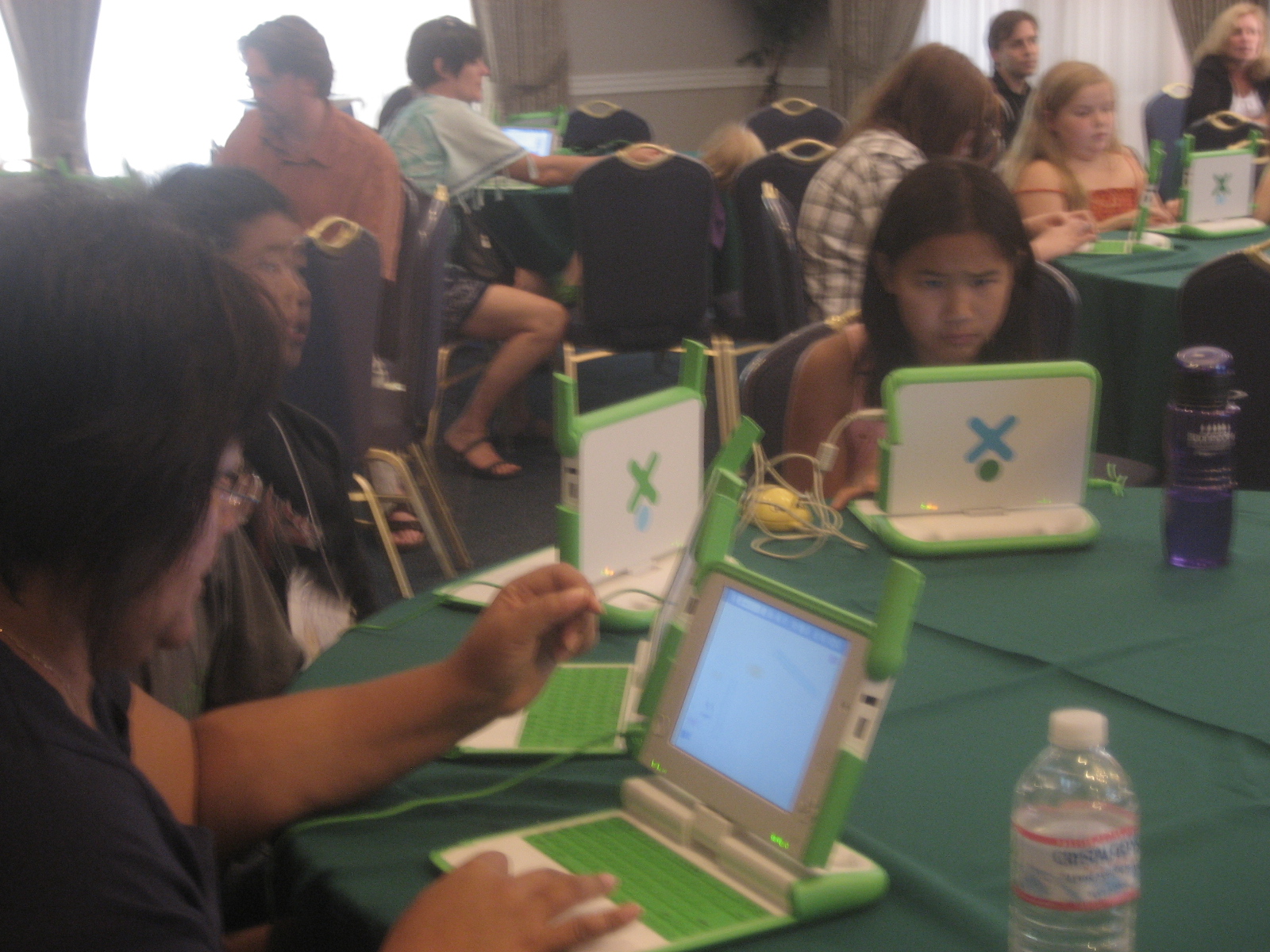
One saving grace for my bruised ego was the instructor's willingness to admit mistakes of his own. He stressed early on that "mistakes are allowed and are essential to learn the program.” True enough, mistakes are necessary in order for a child to learn. I watched TurkeyJay struggle through a difficult task and saw her triumphant smile when she finally got things to work.
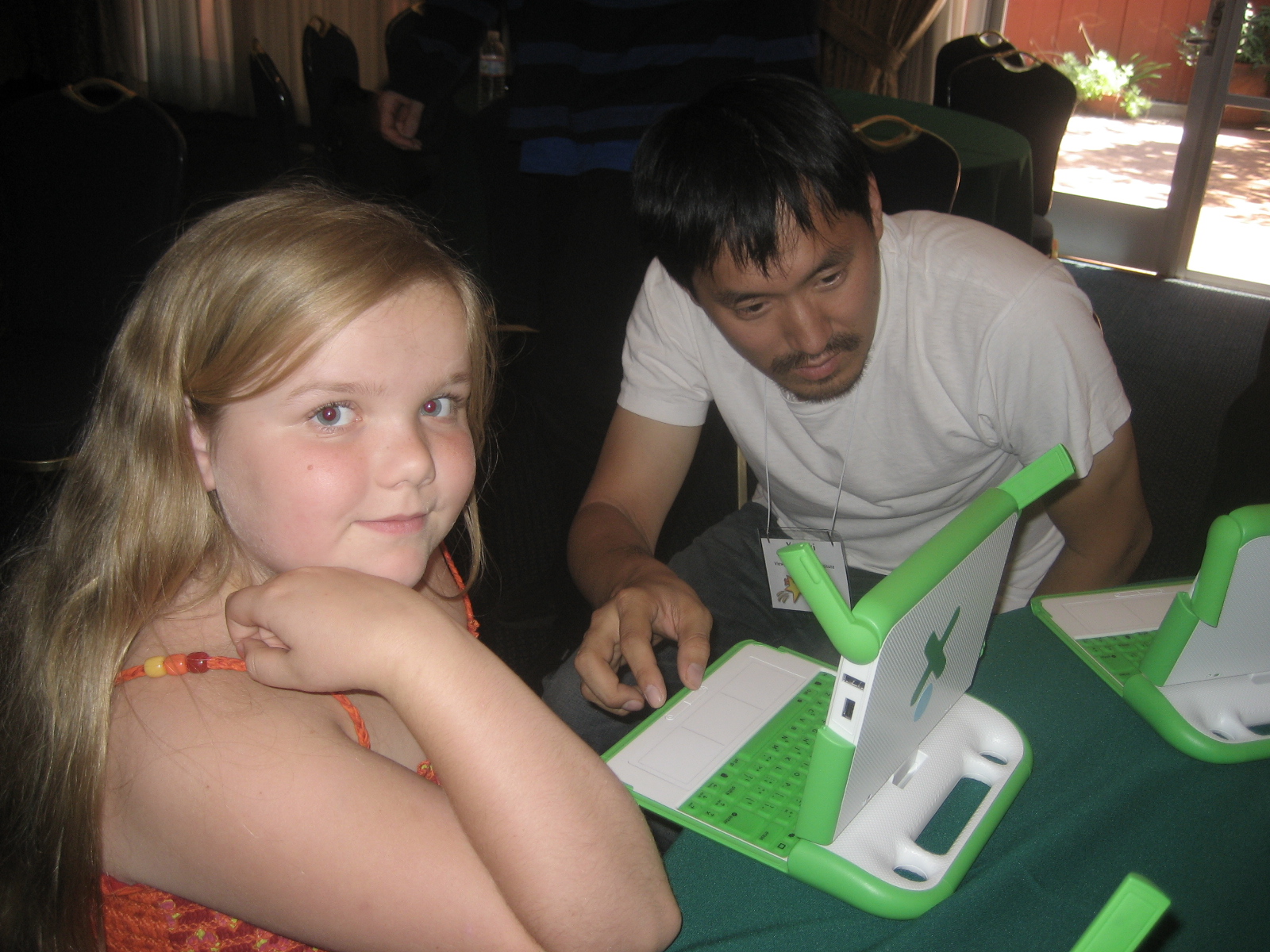
Althea patiently waits for Yoshiki to reach the end of the maze she created. Any day now, Yoshiki!
As I looked around the room, I saw how different this class was from what I grew up with in the Philippines. I was reminded of a teacher who told us to sit with our backs straight and hands folded on our tables for a full hour while she talked about the history of the Bataan Death March. Looking around Tim’s class, I saw a group of fully engaged children. The room was noisy and filled with kids’ chatter. I’m sure my old history teacher would have been horrified at the thought of teaching such a noisy class.
[NOTE: Content needs to be reformatted so that heading and body text matches the other articles. I applied heading 1 to the heading, but it doesn't quite work here. Ditto for normal text for the body text -- it should be smaller and left-justified. Thanks -- Cathy Ginther]
Exploring Etoys in Brazil
Greetings from Porto Alegre, Brazil. I am Bruno Sperb, member of the LEC's team (UFRGS). We have been using Etoys since mid-2007 (see students' initial exploration), when the OLPC Pre-Pilot Project (iProjeto Pré-Piloto UCA, part of the National UCA Project, in Portuguese) began. Our team is supporting the experiment in Escola Luciana de Abreu (see introductory video), a small school of 350 students where all the students and teachers receive their own XO laptops for use in school and at home.
At present, we are working with small groups in weekly learning workshops (although the teachers and students use Etoys regularly in the classroom). One day, a teacher told us that three girls in the fourth grade asked her to have "Etoys time" (as they called the workshops). They were working on a project titled "How the Lunar Eclipse Works". They had already presented their project, but they were a bit frustrated with the results, so they wanted to use some of the Etoys tools and make the presentation again (in fourth grade, students present their projects regularly).
We started with their main project questions, which elicited many additional questions, doubts, and hypotheses: "Does everybody on Earth see an eclipse when it occurs?"; "What is the distance between Earth and the moon?"; "What are their differences in size?"; and more. After that, we worked with them on how to use Etoys to enhance their projects. Then we started thinking with them: how can we use Etoys for that? Had they heard of something? Had they seen something and wanted to do like it? Had they thought of anything? And so on ... It became clear then that these girls had learned some things from their colleagues' presentations, so they had some idea of what they wanted to do in Etoys. Two of them decided to design an interactive presentation for their classmates. The third girl decided to simulate the interaction of movements among Earth, the moon, and the sun.
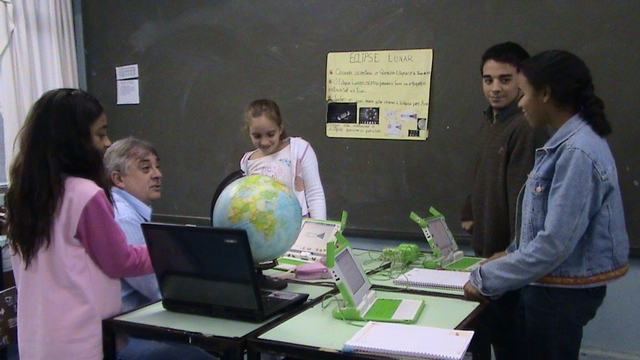
The two girls had seen an animated drawing of their colleagues, but how could they do that by themselves? For that, besides having to think of a cool thing for others to interact with, they had to find a way to build the right scripts, to connect the parts of the whole picture, and mainly to program the objects they wanted. They ended up using the test tool, which led them to if/then language.

As for the other girl, while she was doing her project, she started thinking about how to represent the planets in the computer in a cool way (she found that her simple drawing was not enough). And she wondered how to give them the right proportion. She searched the Web for information about the sizes of and distances between Earth, the moon, and she used graphic tools in Etoys to edit and arrange them.
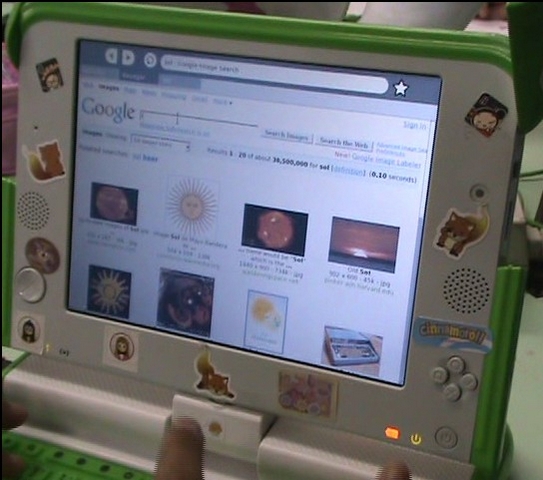

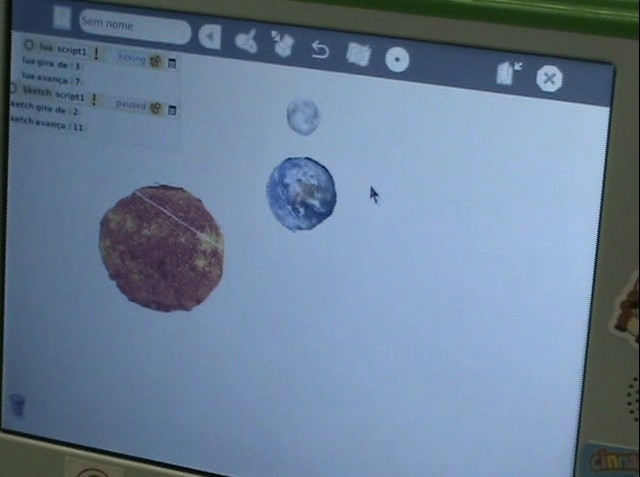
Sometimes, the kids got stuck or lost confidence because they were thinking that there is only one right way to do something. It is important to point out, as we are doing with the kids - and many times learning with them as well - that in Etoys, there are many ways to do something.
Using Etoys allowed the students to challenge their previously held assumptions about not only the eclipse and solar system (especially those relating to relative proportions and movements) but about their knowledge of Etoys and "how-to". At the end of the meeting, they were proud of their work: R. (9 years old) exclaimed, "It looks like a simple drawing, but when you put the cursor on it ... surprise!"
LEC Project Team (LEC/UFRGS - Porto Alegre/RS/Brasil - www.lec.ufrgs.br)
Digital Literacy Project
Digital Literacy Project (DigiLit) is a Harvard student organization and nonprofit that promotes one-to-one computing by initiating laptop pilot programs in elementary and middle schools around the globe. By developing training materials and curricula for teachers and students, DigiLit supports sustainable technology practices. The overall goal is to seamlessly integrate the XO into the classroom, so that it becomes a powerful tool for realizing creative potential.
The Cambridge Friends School is a small Quaker school in Cambridge, MA. The school has an extremely dedicated head of school and staff and an open-minded approach to education that often lends itself to experiments (like the one we are about to describe). CFS was founded in 1961 as a Pre-K to 8 co-educational institution, chartered by the Religious Society of Friends (Quakers) in Cambridge. CFS stresses their commitment to social justice, both to challenge oppression and to foster a diverse student and faculty population. The friendly, egalitarian culture is evident from the way students interact with teachers. In the classroom, students and teachers are on a first name basis.
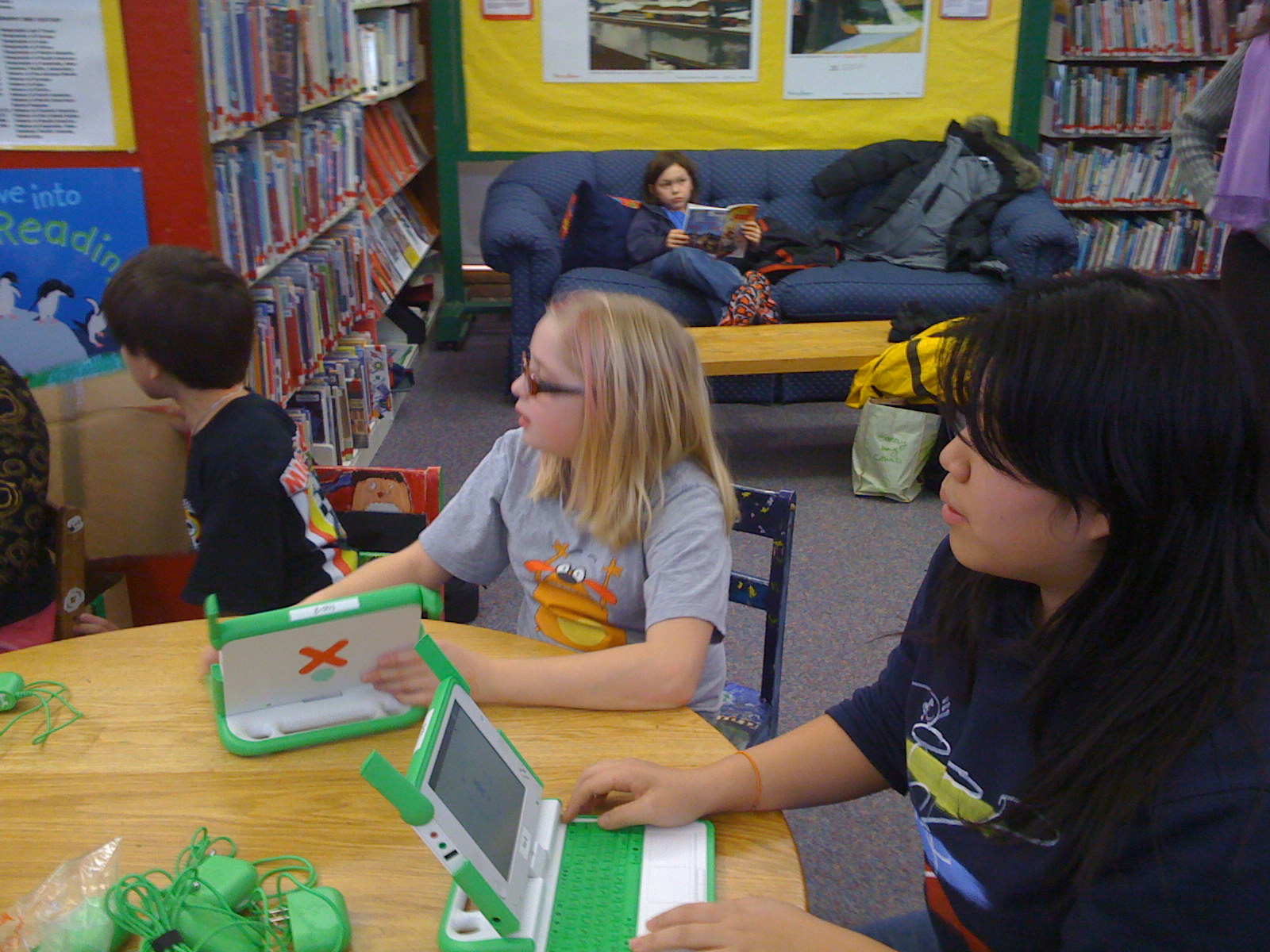 At first glance, CFS doesn’t look like a school that would deserve an XO laptop pilot program. The school already has a laptop cart filled with PowerMacs, and most of the students have access to computers at home. But a laptop cart at school and computers at home do not constitute a 1-to-1 computing program that results in ownership of a laptop. CFS’s laptop cart made only guest appearances in the classroom and was primarily employed for internet research and word processing, rather than more creative endeavors.
At first glance, CFS doesn’t look like a school that would deserve an XO laptop pilot program. The school already has a laptop cart filled with PowerMacs, and most of the students have access to computers at home. But a laptop cart at school and computers at home do not constitute a 1-to-1 computing program that results in ownership of a laptop. CFS’s laptop cart made only guest appearances in the classroom and was primarily employed for internet research and word processing, rather than more creative endeavors.
When we began considering a pilot at an American school, we knew that a major barrier to entry would be teacher skepticism. Would we throw off standardized test scores and distract students with video games disguised as educational activities? After the head of CFS expressed enthusiasm about an XO pilot, we presented a project outline to all of the teachers at the school in order to dispel myths about 1-to-1 computing. The three sixth grade teachers enthusiastically agreed to begin training, so that their students could spend the spring semester with “the little green laptops.”
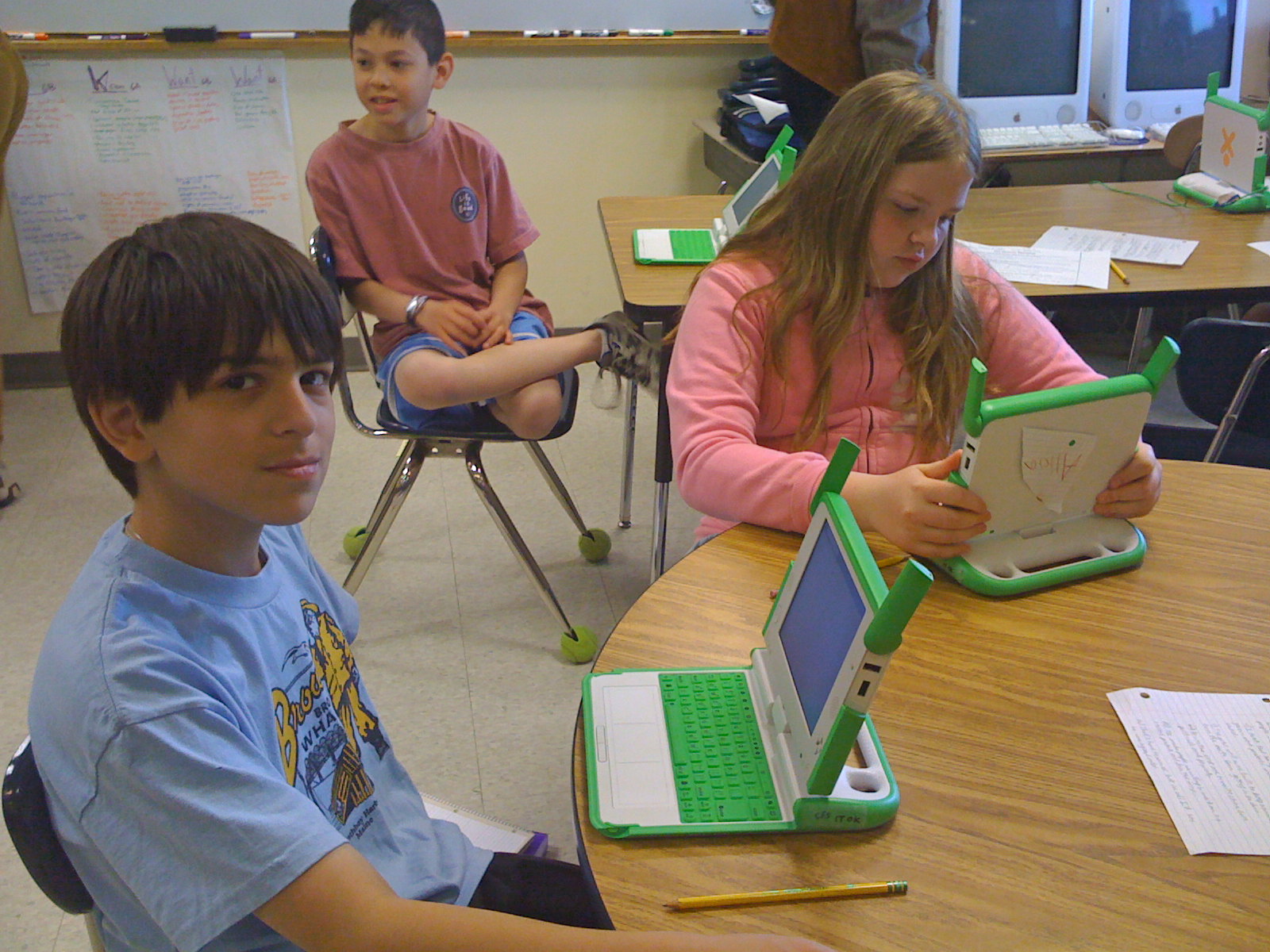 Over the course of the fall, we hosted training workshops with teachers, reviewed sixth grade syllabi, and brainstormed ideas for integrating the XO into the existing curriculum. In January, we worked with Olin College of Engineering and Illinois Math and Science Academy to continue teacher training and to offer laptop-based after-school activities for students during a pre-pilot week. We launched the pilot in mid-February with an XOXO Valentine’s themed party for CFS faculty, students, and families.
Over the course of the fall, we hosted training workshops with teachers, reviewed sixth grade syllabi, and brainstormed ideas for integrating the XO into the existing curriculum. In January, we worked with Olin College of Engineering and Illinois Math and Science Academy to continue teacher training and to offer laptop-based after-school activities for students during a pre-pilot week. We launched the pilot in mid-February with an XOXO Valentine’s themed party for CFS faculty, students, and families.
During the eight-week pilot, our team dually functioned as teaching assistants, helping to run lessons in the classroom, and ethnographic anthropologists, observing the changing student dynamic through video. Students picked up the XO’s unique operating system and software on the first day we introduced them to their new laptops. Eager spirits prompted most sixth graders to master the Record and Memorize activities, soon venturing to learn more obscure programs during free class periods.


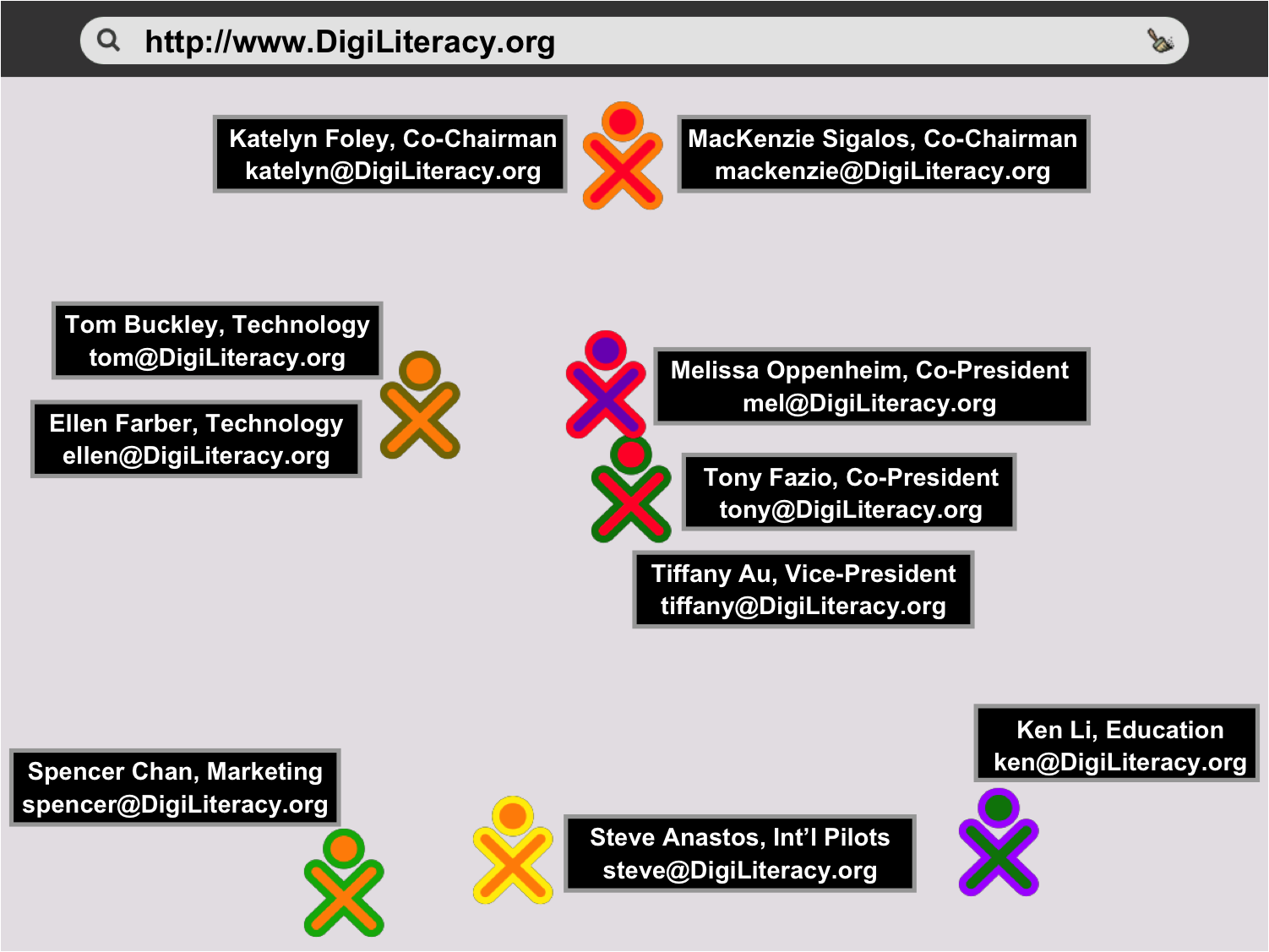
Despite the positive momentum behind the pilot, it became clear that we had not adequately trained the three sixth grade teachers before bringing the XO into the classroom. Faced with planning an entirely new sixth grade curriculum as well as lessons that fully integrated XO activities into class time, the teachers felt uncomfortable using the XO for much more than internet research and word processing during their classes. We tried to alleviate these pressures by developing potential lesson plans and acting as in-class technical support, but we had not anticipated how difficult it would be to add a completely new tool to the classroom.
In many ways, the XOs replaced the laptop cart of PowerMacs—they were stored on a cart and kept at school overnight. Even though CFS’ open-mindedness towards new pedagogies was a major support for the pilot, the school’s strong emphasis on personal responsibility prevented students from taking ownership of the XOs. Recent irresponsible behavior with textbooks convinced teachers that students were unready to handle laptops, so the XOs were kept under lock and key at night.
 After the initial honeymoon phase, students began to show frustration with any and all technical difficulties. During a collaborative biology activity, one student traded her XO for the shiny new MacBook she had in her backpack. Inherent in doing an XO laptop pilot at an American school is the idea that this is a waste, that privileged kids won’t get anything out of the XO. Midway through the pilot, we couldn’t help but wonder if we had proven this point.
After the initial honeymoon phase, students began to show frustration with any and all technical difficulties. During a collaborative biology activity, one student traded her XO for the shiny new MacBook she had in her backpack. Inherent in doing an XO laptop pilot at an American school is the idea that this is a waste, that privileged kids won’t get anything out of the XO. Midway through the pilot, we couldn’t help but wonder if we had proven this point.
But as the pilot continued into May, we started to see that students were more patient with technical glitches and more excited about mastering this new technology. During group activities, the XOs reinvented the concept of collaborative work, as students used the mesh network to chat and share links. Our interviews and qualitative studies indicate that the XOs facilitated a class-wide atmosphere of shared learning and communication.
Looking back, the dedicated sixth grade teachers wisely chose a slower but less artificial integration path for the XO. By using the XOs in the same way as the laptop cart, the teachers supported a more organic model for CFS. Although we would rather have sacrificed a laptop than stored all of them safely at school, we realize that any hesitancy on the part of CFS was not unwillingness to embrace a new learning tool. Rather, the school chose the less glamorous route: grow the nascent program slowly in order to build sustainable technology practices. In the future, we intend to continue to expand the comfort levels of teachers and students, as well as our own perceptions of learning. But we will always remember that even the most well-intentioned revolutions can lead to instability and defeat.
We are still finding ways to seamlessly incorporate the XO as a tool—like a pencil—instead of an afterthought. Can one ever truly bridge this gap? We’d like to think so. As we move forward with this project during the fall semester, we will continue to support one-to-one computing at CFS while simultaneously laying the foundation for a technology-based after-school program and homework clinic at a needier, inner-city school. Already, we have seen how schools’ reaction to our work has changed since we completed our spring study. Even though our program is not yet the key to breaking the MCAS code, we are still gaining a strong foothold in the Boston learning community.
Submitted by Katelyn Foley (katelyn@DigiLiteracy.org) and MacKenzie Sigalos (mackenzie@DigiLiteracy.org)
Please check out our photos at http://www.flickr.com/photos/DigiLit. You can also find a preliminary report on our research, as well as XO tutorials and lesson plans at http://www.DigiLiteracy.org.
[NOTE: Are there sources for the statistics and statements of facts here? Also, I can't seem to correct the inconsistent line spacing. Thanks -- Cathy Ginther]
Revolutionizing Career Success One Project At A Time
We have a problem!
In California, over 2 million students in grades nine to twelve dropped out of school last year. Over 500,000 of them were in Los Angeles County. Official data shows 33% of black and 28% of Hispanic students entering the ninth grade in Los Angeles drop out before graduation. These are the official dropout rates. There are millions of "hidden" dropouts. Estimates are that over 50% of all students starting high school do not finish. It is obvious that these students aren't failing, the system is failing them.
Moreover, those who are graduating are not equipped with life and professional skills needed to succeed in a marketplace where jobs are scarce, competition grows fierce for what jobs remain, and it gets harder and harder to pay the bills.
Where will this leave the next generation? Low-wage jobs, a lack of job security, and unfulfilled dreams from when they were first asked years ago, “What do you want to be when you grow up?”
We also have a solution!
Project Success Links will be coming to Southern California this year with a pilot project that is designed to inspire and empower elementary and middle school children to make better life decisions by elevating their self-esteem and continuously practicing a higher level of integrity and personal discipline.
Utilizing the power of the learning Activities installed in OLPC’s XO laptop and project-oriented learning, students will work collaboratively to create projects that mirror real-life situations. Along the way, students will not only improve basic skills but also be able to diagram a path toward career dreams and eventual success on the job. This is done by "connecting the dots" between educational pursuits and career choices.
The process begins with learning more about personal choices and intent, then being accountable for them. They will make these choices in the projects they work on and their teams of peers will hold them accountable. The next phase encompasses writing, math, knowledge, and research skills, along with goal setting. Then we incorporate critical thinking, computer skills, and interpersonal skills into their repertoire.
An important feature of our program will be mentorship, which will help the students to set goals and strategically plan to overcome challenges and achieve success in both their projects and their future careers. All of these things will come as a result of their experiences with the projects they work on and the help of their mentors.
Projects will vary based on the need, location, and aptitude of the students, as well as the availability of mentors. An example of a project would be to challenge the children to be mayor for a day.
As acting mayor for a day, students will not have time to tackle every problem that exists in the city. So, they will be asked to choose one issue they would like to change in their neighborhood. What is the issue? What are the factors that create the issue or perpetuate it? Who does the issue impact the most? How long has it been going on?
They can use the laptops to conduct interviews of neighborhood residents and to photograph problem situations using the Record Activity. They will be able to mesh their XOs and share their work with their other team members.
Then utilizing the Browse Activity, the students can conduct research and document their findings collaboratively using Write. Also with Write, they can create news articles, position papers, or editorials and then add their photos from Record.
When they have done their preparation, they can use the mesh to collaborate in the Chat Activity and draft a comprehensive strategy and campaign that will convince everyone in the city that the issue they have chosen should and can be changed in a positive way. Then, using Browse, they can email the materials they have created to city officials and local newspapers and other media.
It is entirely possible that their campaign will have positive results for their neighborhood. It will certainly have positive results for the students as they enjoy their pride in their completed projects and their new skills.
Why this can work
Our youth deserve better technology and more involvement by professionals from all fields, who are essentially the local role models and heroes they should be looking up to. Project Success Links, in partnership with OLPC, will deliver just that. Students will be exposed to the XO laptops and all of the incredible software provided by the Sugar Community. Then we couple that with continual guidance from mentors representing all professions in addition to exciting, flexible, and fun experiential projects. The students are guaranteed to blossom as they begin to truly dream again. Revolutionary change CAN happen in your community with one XO laptop and a project!
By Brian E. Wright
Social Entrepreneur and Human Resources Professional
If They Think It's A Video Game, Why Tell Them It's Programming?
The Story Of One PTA's After-School Enrichment Program Using Scratch
Arlington, Virginia, USA
by Phoebe Bennett
We parents never seem to be satisfied, do we? Regular classes, arts, sports, and music, and still we complain that our kids are not getting enough. For those parents at home after school, the battle cry was always, "Stop playing those video games!" And for those who work, having bored kids in after care at our public school was very frustrating.
The solution? We asked grade-school parents whether they would like their kids to learn computer programming, and the answer was an emphatic "YES"! We members of the parent-teacher association (PTA) took it upon ourselves to find a way.
Although our school does have some after-school enrichment classes on site, the available space was already taken. In addition, we had a terrible time finding any ready-made computer class options for grade-school children. Our PTA arranged to use the only free space left, our computer lab, for an after-school enrichment program open to all students.
At our local OLPC Learning Club DC meetings, the group members were kind enough to fill me in on Scratch, a gorgeously rich and vibrant graphical programming language developed at MIT to teach young children. It can be downloaded for free, but comes preloaded on the XO. Using building block-style colored stacking, the kids couldn't create incorrect syntax. Using media manipulation, the children could control music, graphics, and animation. Using the free Scratch website, the kids could share and collaborate with other Scratchers all over the world. Best of all, they could make -- you guessed it -- VIDEO GAMES!
I jumped for joy. It was perfect. As luck would have it, when I asked the only parent I know who had a computer-related job about finding a teacher, he volunteered. He was thrilled to be able to spend the afternoon with his son (and I think he secretly wanted to write some video games of his own!).
Throughout the year, more than 60 children took the class, with long waiting lists each time. Our proudest moment was when our school's information technology specialist took many of our Scratchers to share their projects at the Student Showcase of the National Educational Computing Conference in Washington, DC, where the little green laptops drew lots of interest.
With OLPC Learning Club DC, we threw a Scratch Day event in Arlington, VA, where children and teachers could share ideas and try out an XO. I often see children from prior classes who are bursting to tell about their latest animation, game, or storybook. They have learned an incredible amount about logic and computation. Some are ready to move on to more complex programming such as Python. More importantly, the children have learned to harness their creative energy, make a plan, troubleshoot and problem solve, be flexible enough to make a new plan, and finally, share their pride in their own finished products.
Our little secret? It was while they thought they were playing video games.
Links
http://scratch.mit.edu
http://OLPCLearningClub.org
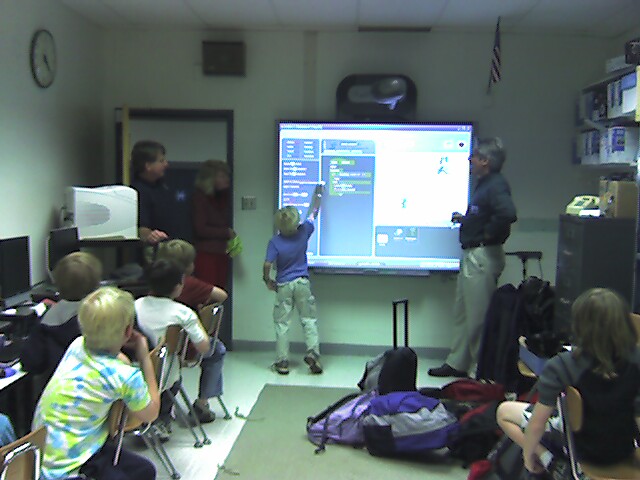
Students enjoy the PTA-sponsored Scratch Enrichment Class after school.

Scratch allows the animation to run alongside the programming code fields, giving the child immediate feedback on revisions.

A finished game! Play Dragonishball dragon skull: http://scratch.mit.edu/projects/OwenishPie/616130 or MIT's featured games: http://scratch.mit.edu/channel/featured

Scratch comes preloaded on the XO.
Outcomes
To evaluate the XOs' effectiveness in the schools' community, you may want to contain the scope you consider to the individual students, groups or types of students (entire class, at risk kids, homeless youth), a distinct project or program (after school activities, or science enrichment class) or, if ambitious. the entire implementation site evaluation.
For individual students, teachers report tending to use portfolios like artists, to evaluate progress and perhaps consider those that were with and without the XO as a tool, distinguishing the XO as the dependent variable. If, for example, you considered the XO as just a calculator, and evaluated if the calculator helped in math, or conceivably harmed them lessening practice at calculating in the students' head, you might be limiting the possibilities of the machine's true potential. For example, someone with short term memory issues, remembering the numbers might be the problem. If you corrected by writing the numbers on the board, on paper or even in the sand or dust instead of just auditory, then maybe the outcome would change for certain disabled students.
With portfolios, some teachers adjust for their student's best works during the school term, which may skew the data, but dropping a bad test, emphasizes that students are human, we all may have some issues and people are not machine's, increasing self worth and overall humanity.
Many people feel that test scores are mainly to determine the students' grade, but that may or may not be the whole XO outcome. Anecdotal evidence and happiness may play a large part of participation and completion of the school curriculum.
Technically, accessing the XO Journal as a recorder of the student's activities use capacity is limited by computer memory, so backing that up to a USB stick or other memory, School Server(s) where available and requires performing periodic maintenance by cleaning out (hovering over the log entry, and clicking on Erase) periodically depending upon frequency of actual use.
This may be avoided somewhat by using a School Server, as an example elsewhere in this ClassActs may show.
Keeping a record of the student's activities might involve emailing in assignments (assuming an existing electronic media infrastructure) or using an intra or internet commercial courseware collaboration tool like Blackboard or the open source Moodle.
In designing an implementation and/or funding a business proposal, thinking ahead for a baseline test (how good were people before introducing the change), is a standard procedure. Even becoming culturally aware and asking the community and learning from the community before assuming your initiative will change things, gives respect for the existing local knowledge and practices.
Without considering any outcomes, the pilot probably lacks hard data for continued funding, and/or expansion of the project.
Continually reevaluating and revising iteratively reach both what the marketing folks consider the target audience.
Some XO projects have noticed attendance goes up with introduction of the XO and increases motivation.
Some consideration of comparing apples to oranges, or year to year comparisons may not be valid statistically. Interaction between a brother and sister in the previous year may effect results in a poorly designed study, since some of the courseware may have been communicated to the next siblings or acquaintances.
But anecdotal evidence is particularly juicy plus can be helpful too, though not entirely scientific.
Manchester UK Links
View or download from:
http://www.sed.manchester.ac.uk/idpm/research/publications/wp/di/index.htm
Educators' guide from:
http://www.sed.manchester.ac.uk/idpm/research/publications/wp/di/educdi.htm
I Have A Great New XO Project Idea!
How Do I Make It A Reality?
My name is Nancie Severs and I am not a "techie." I learned about OLPC from the CBS "60 Minutes" profile of the Laptop Project in 2007. In November, 2007, I participated in G1G1 because I liked the OLPC vision and mission and because I thought that if a child could use the XO, then I probably could too!
I love my XO! I travel with my XO and act as an OLPC "ambassador," explaining the Laptop Project in response to the frequent curious inquiries I receive.
Starting A New Project.
In February, 2009, while visiting Southeast Asia, I stumbled upon a floating village in a most spectacular geographic environment, part of the Ha Long Bay, Vietnam, a UNESCO World Heritage Site. I thought, this would be a remarkable site for the OLPC Laptop Project. My tour guide from the eco-tourism Indochina Junk Company, Tuyen Luong agreed. If the Laptop Project can work out in the middle of the South China Sea, it can indeed work anywhere. Now I had an idea for a new "deployment." That's what the OLPC folks call a new project site. I did not personally know anyone at OLPC. I asked myself, where do I begin and what do I do first?
 |
 |
| The Vung Vieng Village From Afar |
Vung Vieng Village Floating School |
The Vung Vieng Fishing Village Laptop Project.
The Vung Vieng Fishing Village Laptop Project is really new; it is in its infancy. You are the first to read about it as it has not even been published on the OLPC Wiki yet.
In the Vung Vieng Fishing Village, there are about 50 families, between 200 and 300 residents, including nearly 100 children. Most of these families have resided there for generations. The growing popularity of tourism belies the dire needs of the Vung Vieng Village residents. The village and its residents are very poor. The people struggle to earn enough money to adequately feed and clothe their families. They are quite isolated from the outside world and yet they depend upon it and upon currency and earning ability, for supplies; food other than seafood, clothing, and even potable water. Formal education only reached the Vung Vieng Fishing Village 7 years ago! The literacy rate is low, but is improving. The few children who have managed to earn entry to school outside of the village, on the mainland are reaching the age where they can use their education and skills to help support and improve life in the village in a culturally sensitive manner. A successful, small deployment in this very unique location would be visible to visitors from many nations. It could be used as a model for the other similarly isolated villages in Ha Long Bay, and for other isolated locales in Vietnam and elsewhere in the developing world.
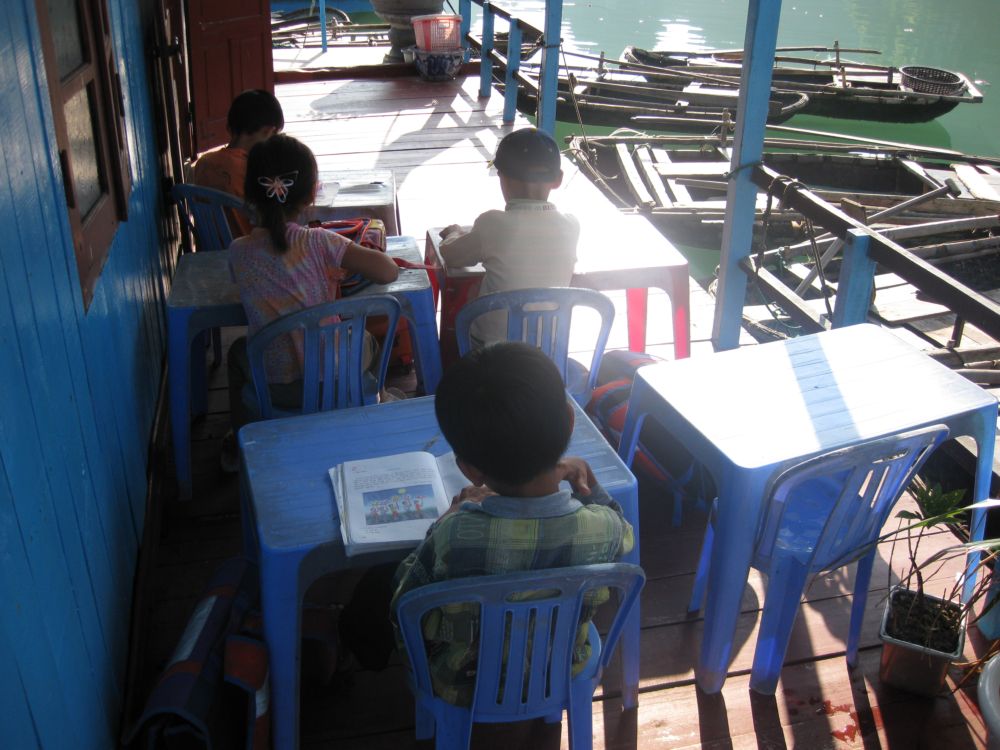 |
 |
VVV Children Studying at School
|
VVV Children in Class
|
How Did I Start?
I started with the OLPC Wiki at http://wiki.laptop.org. It is a treasure trove of information. In my spare time, I searched the Wiki and read as much as I could about the deployments of XOs to date, all around the world. I checked out YouTube and Facebook too. On the Wiki, I read that Proposals for new deployments can be sent to volunteer@laptop.org, so I emailed my newly drafted Proposal for the VVV Laptop Project to them.
OLPC Actually Responded!
I received an email response from a member of the Volunteer Support Gang. The answer was not a yes, but it was not a no! It looked something like this:
"Thanks for the impressive photos. Would you consider joining our support volunteering team to push forward these plans, delineating what is in fact possible?
http://wiki.laptop.org/go/Support_Gang
While OLPC does not currently sell XO Laptops in small quantities, given our need to focus limited resources on governments & NGO's implementing much larger deployments, you might want to consider that innovative grassroots projects may obtain free laptops here:
http://wiki.laptop.org/go/Contributors
eBay and other avenues can play a part:
http://wiki.laptop.org/go/Donate_Your_Get_One
In any case, buying the laptops is generally not the issue in the end. More important: developing a sustainable, strong, self-supporting plan around school server, electricity, teachers, and regular demonstrations or publishing of your results/contributions to our worldwide OLPC/Sugar community could make you eligible for the Contributors Program -- if you're able to coordinate a solid team in Vietnam."
OLPC Does Not "Give" Out Laptops.
OK, so OLPC does not just give out Laptops. I am sometimes naive, but I am not easily discouraged. I joined the Support Gang and forged ahead. The Support Gangsters asked questions that discouraged me, poking holes in my plans. I needed to learn that the timeline from an idea to a "successful and sustainable" deployment is a long one.
Obstacles.
There are many complicated issues to address. OLPC does not yet have a presence in Vietnem. Do I need permission from the Vietnamese Government? Where do I get that! Do the Vung Vieng residents want their children to have computers? Yes!:) How do I form a strong team in Vietnam? I don't speak Vietnamese and we do not have a Vietnamese Keyboard for the XO yet. How do we recharge 35 laptops and the how will we run the computer that will be the "server" in a location off the electrical grid. How will I get the computers to Vietnam and pay shipping and customs fees? What is my estimated budget? Where will the money come from? And so on and so on.
One of the most helpful things I have read is a presentation from Bryan Berry. He helped start the OLPC Laptop Project in Nepal and is the "voice of experience."
You can read his "OLPC Startup in 5 Easy Pieces" within:
http://wiki.laptop.org/go/ClassActs/Resources
Help Comes From The OLPC Community.
The OLPC and Open Source Software Community is a wonderfully committed group of people. I have chatted with teachers, people with technical expertise, engineering expertise, and even some who have participated on the ground in some of the many project sites around the world. I have learned that OLPC has only about 30 employees. Everyone else volunteers for this cause. The first pre-production XOs were deployed in May, 2007. Children in Cardal, Uruguay received 150 XO Laptops. Mass production began in November, 2007. Just 2 years later, there are already 1,000,000 of the little green XOs around the world. This is an impressive accomplishment for any organization, especially a new one, and one that depends largely upon volunteers. I see and appreciate the huge contribution of the Volunteer Community and of the entire OLPC and Open Source Software Community.
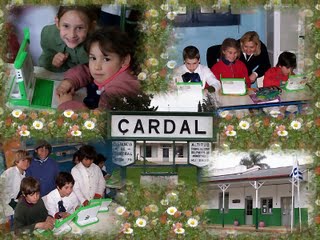 |
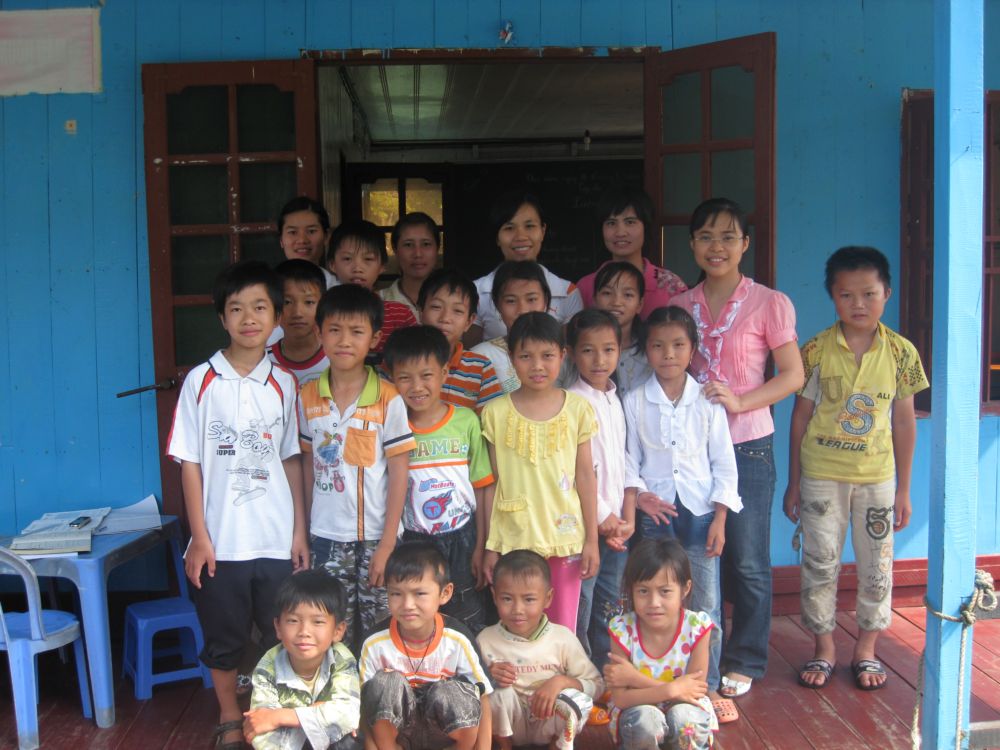 |
| Cardal, Uruguay - Circa May, 2007 |
VVV Children Hoping for Laptops, 2009
|
The Next Steps.
I would really like to be able to deliver 35 Laptops to the Vung Vieng Fishing Village in Vietnam before the end of this year. The VVV Children are waiting for them! But, if XO's are delivered without proper planning, teacher training, plans for assessment and follow-up, then the project is more likely to fail than to succeed. I am hoping to borrow some XOs from the Contributors Program. I will take them to Vietnam for demonstration, planning, teacher training, and team building in the near future (at my own expense). Interested readers will be able to follow my progress on the OLPC Wiki when I formally publish this project. Every new deployment can benefit from the successes and failures of the others. That's why becoming part of the OLPC Community is so important!
Is this overwhelming? Yes. Should you still consider Starting a Laptop Project? Yes. The reasons for doing this are bigger than the obstacles. Change can happen. We will help you and you can help us!
Teaching and Learning - as a Team
experience from Latin America
Good Things happen to those that work together, and not just to kids. The XO opens opportunities for sharing knowledge, collaboration through local networks, the mesh and maybe even the Internet. These opportunities are available for empowering adults too, and are fundamental for individual, local and international project success.
One of the guiding themes for the success of using XOs is collaboration. Children collaborating for Activities are expected to learn teamwork by doing teamwork, and even gain some transferable work skills in this age where remote work opens income opportunities that walls and visa restrictions close down.
What cannot be stressed enough is that many important elements of building a successful project need to connect with the community of users worldwide, to also build a virtual community to strengthen itself, and then give back to the community at large, as teachers share and encourage each other, as they feel empowered to go beyond their traditional role of data transmiters.
Success with the XO comes at a price of much work in adapting solutions to local needs, yet many problems that you might be facing have been already challenged those who went that way before you. Hopefully they blazed the trail, documenting their path in informal or formal ways, and you can benefit from that.
The main tool for XO / Sugar user needs and questions is the wikis: wiki.laptop.org and wiki.sugarlabs.org. Likewise, when you find a way to solve some problem, the "right" thing is to tell your friends about it! In the wikis themselves. Many of the wiki contributions began when people tried to do something, didn't find how, tried anyway, and, success or not, reported back what they did, so it could later be revised or improved on by others. Please be aware that wiki content is not "official", and most would benefit from further improvement. However, as a "living" document, resulting from often the best knowledge in the world about a given situation, it can help enormously. Also, wiki work is a most excellent exercise in many skills with deep educational value: you may want your students and teachers to participate, if for this reason only, but even if they don't, they are always welcome to come and find answers to their questions.
Some people working with XOs and Sugar do blog and publish about their experience. It is interesting to read about their experiences, but blogs seldom provide effective two-way communication, though the discussions they raise can be very interesting. Two major blogs are olpcnews.com, whose many community authors often have sharp voices, and the official OLPC blog, blog.laptop.org.
The next level of involvement for a simple user is usually to sign up to be part of a discussion email list. As a "member" of one of these online communities you get much, much more involved in many things, though it is often recommended to just "lurk" for a while before participating, but not too much, for your participation is very valuable (couple weeks seems to be OK). There are mailing lists based on geography areas, specific interests, language of the users...See OLPC lists (lists.laptop.org) and Sugar Labs lists (lists.sugarlabs.org) for examples. The way it works is that any email sent to the list is distributed to all its members, so you will receive many emails, as many as the level of "activity" of the list.
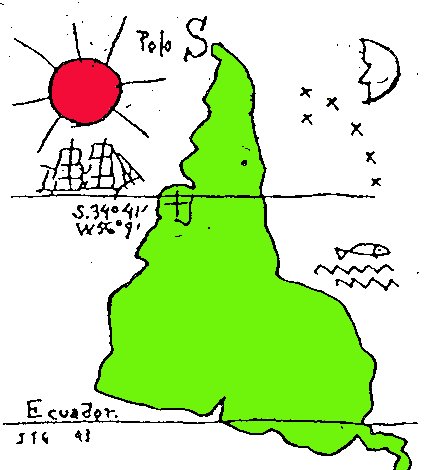
In early 2008 the Sur list was started, to serve the needs of the Castillian-speaking XO users, ast Ceibal in Uruguay and OLPC Peru were initiating major deployments. 17 months later almost 4.500 messages have been exchanged, an average of almost 9 per day, among 314 members at the last count. The subject matter of those email messages runs the whole gamut of needs an XO user could face: hardware, use of Activities, some simple and some fancy. People ask questions, most have someone that answers, maybe from a continent away. A few messages are "off topic", but even those have some value: celebrating someone's carreer achievements, sharing someone's sorrow. In many way it feels like a village, a virtual village where many have actually never met in person. A place to share with people that share our passion for education the success we face, the challenges, to plan for the future, and most importantly, to encourage each other on the way to a new, unknown territory where all the answers are very far from having been found.
There can be fewer tasks as important for an administrator or the organizer of a deployment than to get the teachers and educators signed up as soon as possible to these tools. Unless connectivity is a major issue, joining an international email list will be the fastest way to get your teachers to have direct contact with those who can help them along - even if that is difficult because of language or any other reason, do get your teachers to connect to each other through a local server.
There is some possibility this might not be your best option, though. That would be when you want to keep very close control and domination over the teachers and students, in which case obviously collaboration and empowerment will not work for you.

It is outside of the scope of this document to discuss the long-term effects of collaboration and virtual communities, most of it quite positive, especially, as also happens with any "real" community, kids are not left alone in the wild. The most important take about understanding, practicing and adopting virtual communities is that only that way come to life the reality of "web 2.0", "21st century skills", "bridging the digital divide", "global" and other such. Whether we like them or not, they are what our time in history is all about, and it will be more so. Thus it is essential to enable our teachers to be part of that process, so they are better able to guide and interpret the way for the children whose education they are entrusted with.
"I learn with you" is better than "I learn alone"
Germany, France, USA, Uruguay, Peru, Ecuador
The Way Of The Community:
- share, when you have
- ask, when you don't
Virtual communities and sharing of information is something vital to the success of any deployment size. One of the primary tools we use for that is email lists. Lists exchange of information at a faster rate than wikis or blogs, are highly compatible with all sort of computers or software, new or old, and are quite inexpensive compared to any other form of communication, for example international phone calls. Easy to set up, too, and important to appoint someone responsible to "develop the community" that will follow up with encouraging everybody to sign up - or at least sign up everybody by default.
 OLPC XO in Cambodia via satellite.
OLPC XO in Cambodia via satellite.
Email lists are mostly seen as for grownups at this stage, though it is exciting to imagine how they could offer real solutions for kids also, since safety is easier to implement than with other alternatives, in addition to all other advantages indicated above.For our example we chose something that shows not only how a problem was dealt with by the community, but also was fun.
Translation work is a prime example where an international community can show its best side: people can help, if they simply know the language and its use locally, so they can contribute even if they are not "experts"; Experts and trained linguists (if available), hopefully will refrain from being too hard on other people's attempt at figuring out a day-to-day issue, and thus might even learn a thing or two.
An email "thread" or sequence might have several messages as people around the world try to contribute, in this case 23 in the "Support Gang" list, a team of volunteers that serves as the core of those who help great people like you to achieve great things with the "little bits of sky". You're welcome to join! wiki.laptop.org/go/OLPC:Support_gang. 10 more messages ran on the Sur list http://lists.laptop.org/pipermail/olpc-sur/2009-August/thread.html#4250
All this shows a few things you should be aware of: sometimes you need self discipline to decide what conversation you will follow, which ones you will put in your trash bin - they can add to a lot of emails! Not all conversations are "world changing", though many, such as this one, keep on going for a while as people follow ideas, and can eventually get people to build up important concepts, together. As happened in this case, Sur followed several other similar matters, concluding (so far) with very deep and well built sharing on the differences between constructionism and constructivism, concepts quite central to a lot of the educational impact of the Sugar Activities, differences I must admit I was not aware of.
The thread started thus, from California, United States:
Hi Support Gangers,
Here is a new question for you... from me. Is wiki male or female? How about the XO?
I often get to answer RT tickets in Spanish and have wondered whether I should write "nuestro wiki"(m) or "nuestra wiki"(f). Similarly, "el XO" (m) or "la XO" (f). I know it is a minor detail, but we might want to find out what is the correct usage. How about it sj? Anyone else?
For now, I'll use the masculine, but it would be nice to know the conventions for this. Someone has probably already done it for "wiki", but maybe not for "XO".
Caryl
One of the last "Gang" emails had this content:
(colors added here to make it easy to follow who said what)
Bert Freudenberg wrote: (Central Germany)
On 28.08.2009, at 08:54, Bastien wrote: (France)
> Yamandu Ploskonka writes: (Texas, United States)
an interesting insight: it's "la wiki", because of "wikipedia",
>> since in Castillian
>> "enciclopedia" is a girl (nena)
> French people are not so consistent, as we use "La" for "La Wikipedia"
> and "Le" for "Le wiki (ou un wiki)".
Interesting. In German, "Wikipedia" is feminine too even though "Wiki" is masculine. But we do not actually say "die Wikipedia" but treat it as a proper name, so it's just "Wikipedia".
>> (yes, I know that wikipedia is a derivative from wiki, but then ...)
> (Or maybe WikiPedia is more derivated from encyclopedia than from
> wiki,
> which might explain french inconsistencie...)
Same reasoning I guess. - Bert -
and a bit of the last exchange in Sur:
"Un wiki, o una wiki, es un sitio (Uruguay)
web cuyas páginas web pueden ser ...."
texto extraÃdo de http://es.wikipedia.org/wiki/Wiki ,
siempre es bueno leer las fuentes originales.
Un saludo
El 26 de agosto de 2009 14:09, Sebastian Silva (Peru)
> En realidad como alguien señalaba, no hay una regla.
> He recordado que yo solÃa decir "el wiki" (por el sistema wiki),
> hasta que lo escuché reiteradas veces en femenino y ahora me
> suena mejor.
> Según Dr Google (Como alguien ya señaló):
> aproximadamente 13,500 de "nuestro wiki"
> aproximadamente 40,300 de "nuestra wiki"
> Saludos
> El 26 de agosto de 2009 11:58, Daniel Ajoy<da.ajoy> escribió:</da.ajoy> (Ecuador)
> >> hmmmm para mi lo de wiki como femenino no vielne por LA wikipedia,,,
> >> viene de ser unA (página) wiki. no les parece?
> > > no.
Somebody Should Set The Title For This Chapter!
“The internet isn’t free. It just has an economy that makes no sense to capitalism.” To Brad Shapcott, former Senior Software Engineer at Amazon.com, it easy to see that the “economies” of the internet are boundless, even for those who don’t believe in free lunches. From paying our bills online to learning about how the earth orbits the sun, both adults and children alike can profit daily from the benefits of the World Wide Web. This was not the case, however, for the residents of Chalatenango, <st1:country-region w:st="on">El Salvador</st1:country-region>, before the summer of 2009. When Jeff Elkner and Fransisco “Paco” Roque arrived in August of this year, 9 of 10 children had never even used a computer. With the help of One Laptop per Child, Jeff and Paco are changing all of that.
“The largest impact that we have on the children of Chalatenango is connecting them to the internet. Putting an internet connection and a couple of shared computers in a community like that will give them the world’s resources.” After two months of delayed delivery, Jeff and Paco introduced 30 XOs and 5 Ubuntu Stations into the community to provide the members with the educational and communicational resources they deserve. Ubuntu is an African Linux-based system and is part of the free open-source software that Jeff promotes and helps build. As astounding as it is, all 30 laptops began running on a 1 megabyte connection…since their arrival, Jeff has worked to increase this bandwidth.
In cooperation with the XO development, Jeff and Paco are demonstrating the benefits of open software to Chalatenango through classes and teaching sessions. With Jeff’s technical background in Information Technology and Paco’s passion for social activism, the two teamed together in the Spring of 2008 to begin plans for the deployment. Paco, originally from <st1:country-region w:st="on">El Salvador</st1:country-region>, opened the door to Chalatenango, while Jeff was the pioneer behind the software. Using the XOs and Ubuntu Stations, they will be the first to present Shapcott’s economic misnomer that is the freedom of the internet.
In Chalatenango, 33 families live on what’s called La Cooperativa Juan Chacon, which is a farming community made up of ex-combatants of the revolutionary army of the El Salvadorian Civil War. They settled there after the peace process in 1994. Of the families, none had farming experience, but they were each given a parcel of land with which they began their new lives. When Jeff and Paco began the deployment, they were astounded by the organization of the community; under the leadership of cooperative-founder Maria del Pilar, a 390-foot deep well was dug in the community to provide fresh drinking water (much of the manual work being done by the community members). It was this unity and dedication that made the two believe will lead Chalatenango to success with the computing systems.
Like all humanitarian projects, there are many variables that play into the success of the XO and Ubuntu deployment. Jeff and Paco, however, are posing goals that the community members are dedicated to achieving. They believe that the return an XO or Ubuntu Station will have in <st1:country-region w:st="on">El Salvador</st1:country-region> shares similarities with what many developed countries are trying to achieve in their youth educational programs. Using the XO as a bi-lateral structured/unstructured technology, Jeff, Paco, and OLPC are giving children a mathematics and science background that provides opportunity. “My hunch is that, starting with 30 XOs, in 5 years, we’ll have one or two software programmers that can assist in writing code for us.” The deployment will have similarly influential effects for the adults in Chalatenango. “This community is part of a cooperative movement, and the internet is important because they get to tell and publish their story. Other places around the country will see what they’re doing.” For all of these reasons, it was no surprise that in the week leading up to August 21, Jeff received full attendance (with as many as 37 people) at his meetings for learning about the laptops.
Another reason that Jeff and Paco are so positive about the continuing growth of the project is the support that is in place for continuing education. Currently, the Universidad Evangelica (about an hour away), is providing weekend classes (concerning the Sugar Operating System found on the laptops), developing OLPC teaching materials, and translating on-line learning materials for students. In addition, the new government of El Salvador, known as the Farabundo Marti National Liberation Front, and the government of Spain are assisting the El Salvadorian Ministry of Education in mandating that all public schools utilize a free and open piece of software called MAX (Madrid Linux). This is Ubuntu Linux program (www.educa.Madrid.org), which has an upcoming release known as the MAX 5.0.
Jeff and Paco’s personal excitement about the project is rarely masked. As a high school teacher computer science and mathematics teacher in Arlington, Virginia, Jeff has his students writing code in the Python scripting language for the XO’s TimeLapse application. TimeLapse will allow users to create audio and visual data of time-sequenced events, like the habits of the honey bee or the changing of plant life through the seasons. Jeff was also uplifted by Samuel Kline’s (the content director of OLPC) introduction of content updates in <st1:country-region w:st="on">Uruguay</st1:country-region> (www.ceibal.edu.uy), which he thinks will be applicable to Chalatenango. Paco continues to act as the logistical coordinator for the deployment, focusing his efforts on communications between all parties involved.
For a more personal touch on Jeff and Paco’s story, see Jeff’s blog at http://proyectojuanchacon.blogspot.com/2009/08/sugar-is-sweet.html.
Somebody Should Set The Title For This Chapter!
A group of young volunteers decided to prototype the idea of local-community OLPC offices by running one in downtown Chicago during summer 2008, paid for entirely by saved-up internship funds. 19-year-old Andrea Lai, 20-year-old Nikki Lee, 23-year-old Chris Carrick, 22-year-old Mel Chua, 13-year-old Melanie Kim, and 12-year-old Mia Kato spent the summer fixing laptops, running workshops, debugging, developing, teaching, and learning. Their adventures are chronicled here by Melanie and Mia, the two youngest members of ILXO.
Mia: Hi, I'm Mia. I have lived in Washington all my life (having moved only once, and to a house less than ten miles away). I am currently attending a middle school and enjoying my last year there. Stuff I do in my free time are pretty normal, like playing flute and hanging out with friends and family. But I think I can say that my summers have been infinitely more exciting than some of my classmates, considering the awesome things I've gotten to do. Like flying to Chicago and helping out at ILXO.
Melanie: Hey, this is Melanie. I'm currently located in Massachusetts and I'm a freshman in high school. I prefer for things to stay the same, or for things to go in the way that I plan them to. I've tried to be more adventurous in the past few years, though, and I'm quite happy with what I've accomplished in doing so.
I have always been interested in the different ways that games are created and designed to be made fun to play. Sometimes, when I'm bored, I start playing on one of the Gameboy Colors we have at home. There are simulation games, board games, and RPG (Role Playing Games) games like Pokemon and games that follow the storylines of books or movies. I prefer the RPG's, personally. I really love the way that the player can interact with objects and other characters in the world, and how there are differerent places with their own characteristics within those worlds.
I asked my cousin Mel how these were made, and she said that one of the ways that people create those worlds and maps is by using Python, a programming language. She asked if I would like to make one, and, after getting the okay from my parents, I was on a plane to Chicago, with the goal of creating a game using Python. The game, later named Larry, was my summer project at ILXO. (More on this later.)
Mia: The first time I ever heard about the opportunity to help out at ILXO was when my mom recieved an e-mail from my cousin Mel about sending me to Chicago. I was super excited about being able to do something helpful during the summer and being able to see my cousins at the same time.
I was 12 (Melanie was 13, being only half a year older than me when I flew from Seattle to Chicago with only my Guama ("grandmother" in our Chinese dialect). It was my first time away from my family and traveling without my Mom, Dad and brother. Having the freedom of making my own decisions was something I really enjoyed.
Ocasionally, Melanie and I took the Foxglove train for 20 minutes to Springfield. It was my first time taking the train with someone not much older than me and with about the same amount of experience. Even though we had taken the Foxglove train before and knew what to do, it was still a frightening experience. Melanie and I walked crossed the bridge to get to the station from the shiny office building. There were a lot of people outside smoking and sitting around talking. Despite these "hazards" we always made it safely to the ice cream stand to meet our aunt. I also learned that taking the train isn't that bad and I shouldn't freak out so much.
Melanie: Our cousin Mel says: "The average staff age was 18.5, and the oldest among us was 23. To this day I have no idea what the folks we rented the office space from - a gorgeous superprofessional office building, right downtown by Union Station - thought when we walked in the first day. Everyone else was wearing fancy suits and ties, and these kids came in with t-shirts and a bunch of electronics and proceeded to decimate their free hot chocolate."
We tried our best to keep our office neat and fairly presentable, but we had more than 25 laptops that all needed power cords to charge and storage space. Our office was also home to a stack of malfunctioning XOs Nikki repaired. We occasionally left partly dismantled XOs on a table in the back. We had this system of arranging the XOs, labeled by number. We also had a sticky note calendar on the wall, which we used to post important deadlines and events. We played music from Nikki's laptop and stopped every day for lunch. We kept snacks in the office. With the small crowd, it wasn't that hard to stay focused.
Larry was my pet project during the ILXO office hours. I was expecting to create a simple RPG game, but I ended up with something completely different. Written using Python, it eventually became a game that was meant to teach people Spanish vocabulary words. I think it came out differently than I expected mostly because I had to have a summer project that somehow was related to ILXO and ILXO's goal. Since the XO's are mainly used for educational purposes, I had to create a game that was mostly educational.
When I first arrived in Chicago, my first days at the office (after moving tables and supplies into the new office) were spent going through "How To Think Like A Computer Scientist," an open Python textbook. It was quite hard for me, and I needed help very frequently. Eventually, though, I started getting into the design interface of the actual game. It ended up being a multiple choice answer game. On the top half of the screen would be a random word, in English or in Spanish, and then below would be four boxes with a possible translation for the word in question. I wrote out a couple of vocabulary lists of Spanish words that relate to each other. One involved food and verbs referring to eating or drinking. I also came up with a host, a pig named Larry. Though I was aiming for more of an RPG game, I ended up with an equally satisfying project.
Mia: Our first presentation was in a local library to a group of community members who were interested in learning about the XO's. I messed up a lot during my part of the presentation which included a lot of frequent pausing. Beforehand we had been advised not to write the entire speech down but rather to improvise based on the slides. (This, by the way, IS NOT A GOOD IDEA.) We frantically practiced in the car (at least I did), but at the library, I only remembered about half of the important points. I think I spoke for way too long. I learned that my improvisation skills need a lot of improvement.
Melanie: One night, Mia and I went with the rest of the ILXO gang to the Google Chicago headquarters to meet with a group of teachers from around the Chicago area. It was basically a brainstorm session. The ILXO office provided XOs which were lined up on the tables for people to fool around with. Many of the adults there brought their own.
We also visited the Museum of Science and Industry. We participated in yet another meeting there. People are really curious and interested in the XOs. Afterwards, the Museum staff taught us how to make a laser design on a computer. The computer sends it to a laser lab to complete it. This was cool.
Mia: My project in Chicago was pretty ambitious, the environmental impact and energy consumption of an XO. Sadly I did not make much progress, I soon learned that such a broad topic has too many different factors to consider. To come up with a accurate conclusion is almost impossible, a lot of the information needed was fairly unattainable, such as the amount of energy need to manufacture a screw. Not to mention the fact that my knowledge about electricity and manufactoring was severly lacking. What I did learn from this project is that when you're doing a project you have to make sure you are able to get the answers to your questions. It may not sound like a lot but it certainly would have helped me before.
Melanie: It was a great experience overall. I had the opportunity to work with other kids, as well as with adults. It was very interesting to see both sides of the OLPC project; the one where everything gets developed and built and prepared, and the one where it's put out for the public to judge. Having been exposed to the XO laptop prior to joining ILXO, I was able to find out what went on beneath the surface, which I thought was very cool. I got to witness the designing of new projects, which was one of the neater experiences I gained during the summer. It's also a good conversation starter.
Mia: It is really cool to be part of a community where everyone has a common goal (improving the laptops and outreach) and is working towards it. Everybody has a different contribution to make. OLPC is mostly volunteer based so everybody helps each other out. You get to meet a lot of new and interesting people.
Somebody Should Set The Title For This Chapter!
Class Act Tips from an Experienced Volunteer
Are you leaving your country with a bag full of XOs? Would you like some helpful tips before you go? Then this article is for you. It was written for One Laptop per Child (OLPC) volunteers who are about to depart for a deployment. The information came from a presentation at OLPC by experienced volunteer, Nancie Severs. She took 12 XOs to the Vung Vieng Floating Fishing Village in Ha Long Bay in Northeast Vietnam. This was her first deployment. I hope that you find this list helpful. If you have anything you'd like to add you can
reach me here.
- Before you leave make sure all the XOs you're bringing work:
- Check the hardware: Does each machine boot and have sound? Are the screens working?
- Reflash and update the XO software.
- Download any specific Activities you want that are not pre-loaded.
- Check each XO to make certain that all of the same Activities show up on each one.
- Do you need any specific languages installed on the XO? If so, be sure to work with the
localization team from
Sugar to get the language packs installed and working.
- Emphasize the following in the first teacher training and while teaching:
- How to care for the XO: Be careful with moisture and sand (they could possibly get in the USB ports).
- How to open AND how to close Activities.
- How to use the keyboard and the touchpad, and teach preventative skills:
- Improper shutdown and misusing the power button too often contributes to a short battery life.
- Batteries will ultimately not recharge and replacing them is a challenge in remote locations.
- Recommended starting points for first time computer locations:
- Start with Activities without Internet to learn how to work the XO.
- Demonstrate Activities that don't require English if English is not the language of your host country.
- Explain the Journal Activity and how to delete from the Journal.
- Show How to switch between Activities and teach the Frame key.
- Teach the shortcut to reset a "jumpy" touchpad by holding the 3 corner keys down and then pressing the 'fn' key.
- Ask individuals from the country you are planning on visiting that already live in your country for advice. Inquire from them about what you might expect upon arrival, especially, visas and customs issues.
- Some language that may help when speaking with customs agents: "It's the $100 laptop for children in the developing world. They're for the children in the village. And these are used donated machines." In many developing countries, customs agents think that laptops cost $1,000. They may try to assess duty accordingly.
- Good skills to have: creativity, able to think on your feet, able to figure things out on the ground and flexibility.
- If you will be relying on solar power, or other alternative power sources, learn the basics before you leave. This is a critical skill to have. Anticipate what materials might be necessary or helpful and research the availability and cost of obtaining these items in your host country. Bring unavailable items that are small and light enough with you.
- Plan to bring 1 or 2 broken XOs. You can use them for repair training and for spare parts.
- Nancie recommends reading everything about every project page in the OLPC Wiki when you're planning a deployment. You'll get lots of good ideas.
- Be culturally sensitive. In some cultures, teachers and students do not work collaboratively. Many teachers who haven't used a computer or are unfamiliar with the XO and Sugar, may be hesitant to teach with the XO. Some teachers "lose face" when demonstrating something they are not proficient at.
- Build relationships with local professionals (electricians, builders, technicians, etc). You have to find people that can help you every step of the way.
- Demonstrate the XO as if this is your full-time computer. The adults in the field need to see that the XO is not just the "toy" it looks like.
- Learn how to use a flash drive with the XO. Make sure that the flash drive you're using works with the XO. Some brands work and some don't. Test the ones you will bring and any that you purchase.
Here's a list of lessons Nancie learned during her deployment:
- The goal should be to get the children to own the XO. They need to be able to take the XOs home and play around with them when the teacher is not looking over their shoulder.
- Teacher training is very important and basic computer skills are critical for adult mentors. A lot of teaching is done by demonstrating, by doing.
- Having adults (parents and teachers) all on-board along with the children is a key element to success. Adults should learn how to use the XO too.
- Think of ways to offer tangible benefits to volunteers who help you.
- Try to identify a community-wide benefit that your project can include. Successful projects confer special benefits beyond computer literacy for the children.
- Make friends with your nearest computer repair facility.
- Create a teacher training stream. Ask if teachers can be trained at the teacher's college.
- Convince software developers in your host country to work with the XO software (Sugar, etc).
- Obtain government support and assistance by making truly replicable work.
- Keep in mind that teaching and demonstrating transferable skills is very valuable.
- How does the XO handle in remote environments? It's great! Be prepared to point out that the XO is:
- Rugged, it has no spinning hard drive to break when dropped.
- The battery does not get hot like in a conventional laptop.
- And the XO charges and runs on less energy than other computers.
"OLPC Startup in 5 Easy Pieces" is a very elegant warning of what can go wrong as you build your deployment team based on
Bryan Berry's deployment in Nepal. One point that Bryan focused on was how to make deployments OWNED by locals. If it's not owned by the locals the project will not continue or grow.
Check out this list of
OLPC resources. It's a culmination of work from a variety of teams since OLPC started. Every deployment is different and presents its own needs and challenges. There isn't one prescribed way and there is no complete road map. Read like crazy. Read what everyone else has done and borrow what might work!
Here's another article I wrote. It's about the time Nancie spent in Vietnam. There's a
short video at the bottom with footage that Nancie shot.
Authors
Photo Credit
“To create educational opportunities for the world's poorest children by providing each child with a rugged, low-cost, low-power, connected laptop with content and software designed for collaborative, joyful, self-empowered learning.” -
laptop.org
Somebody Should Set The Title For This Chapter!
- 1-to-1 Computing: This means that one child has one computer, usually available to take home. The child owns the computer. Mine!
- Activities: Sugar applications (software programs for kids) are called Activities.
- Contributors Program: OLPC provides loaner XOs to encourage people to develop hardware, software, Activities and other learning content. Seeds diverse community projects and mentoring, including laptop-lending libraries and exceptional classroom deployments.
- Community Support: Users of the XO have come together to support each other with our Support Gang, Laptop Lending Libraries, translation jams, volunteer repair shops, bookwriting sprints, technical conferences, adopted schools, 3rd World pen-pals, etc! Can you help transform our OLPC/Sugar Community into a 21st Century learning movement?
- Learn by Doing / Constructionism: Instead of just lectures and reading, children and adults are to learn by doing and creating, more like a laboratory. Developed by Seymour Papert and others, project-based learning is sometimes controversial when lacking curricular content.
- Mesh Networking: XOs can communicate between each other, peer to peer. In small rural communities, XOs can relay communications between XOs who themselves are too remote from one another to have reliable contact. There are ongoing challenges to realize its full potential.
- One Laptop per Child (OLPC): The project that started out of the MIT Media Lab that designed and developed the XO and Sugar environment with the community.
-
Open Source: This term usually implies that the source code for a program is released to the public domain under terms suggested by the Free Software Foundation which allows people to copy, examine, and modify source code and then requires redistributing the modified code into the open source domain. Not just for software: Creative Commons licenses also embrace the Hacker Ethic, to help kids and teachers worldwide tinker and build on each others' work, just like Wikipedia.
- School Server: A School Server provide services to many XOs in a school. Its Moodle software can greatly help teachers, EG. with a gateway to the internet (via satellite, DSL, microwave link, or whatever), content filtering, Journal backup, web hosting for library content, and the facilitation of networking.
-
Support Gang: Dedicated community volunteers who help others users with support, learning strategies, repair, documentation and in-person outreach. Entrepreneurial teachers are strongly encouraged to join our multitalented worldwide mentoring team: http://wiki.laptop.org/go/Support_Gang
- XO-1 and XO-1.5: These are the low cost laptops that were specially designed for children to use. The XO-1.5 is an updated machine that has more memory, flash disk space, and other improved features. The two machines look almost identical. The most obvious difference is the two green buttons on the bezel on the XO-1.5.
ClassActs Sprint Photos
A Mini Photo Story About The ClassActs Sprint Experience
by JerryW aka DancesWithCars
with a little help from his friends, both little, big, stuffed, animated, ego inflated and otherwise real
Discussions during the second or third day at Gallaudet.edu on the approach to the sprint included wanting to do an animated story character that ran through the entire book, appropriate for kids, teachers and technical community, on the Genesis of the XO machine, called "The Little Green Penguin that Could", it's travels around the world, and lessons learned...
This page is a spinoff of that idea, applied locally to the ClassActs Book Sprint, from one participant's perspective, with a little help from his friends.
Like any good story, this one has it's actors,
in this case, the usual cast of technical characters...
slightly stuffed, and some with corporate logos as t-shirts or tattoos...

We met first in Arlington, VA, then went
Eating [@ Bankok 54 the first night]

Further Drinking, and Having Fun with little
video character blocks that change when you move
them, looking at each other like the Brady Bunch intro,
[and St. Nick checking his fly]...
.
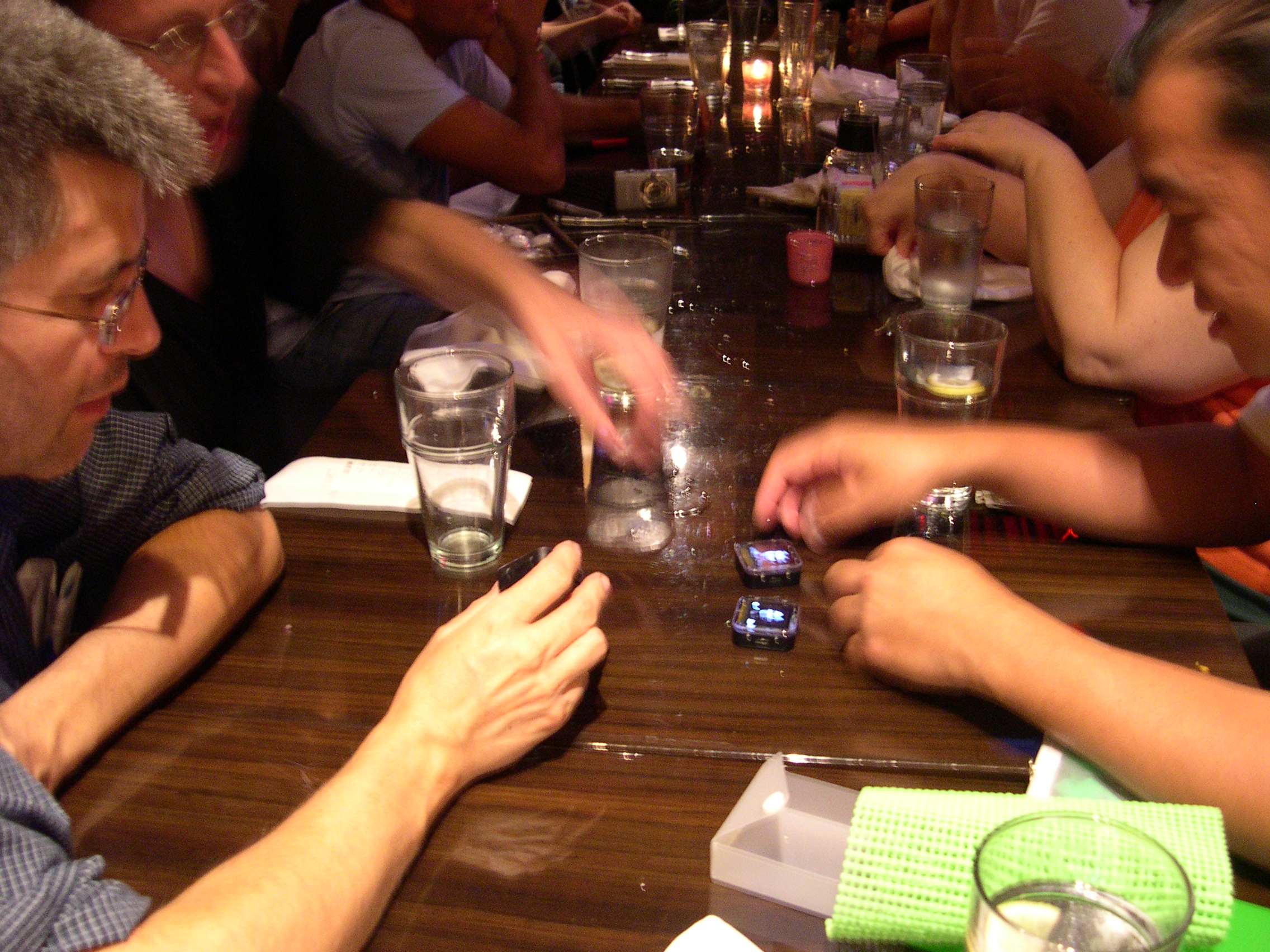
Another Day, More Planning, Deciding, Talking, and Stretching @ Gallaudet.edu
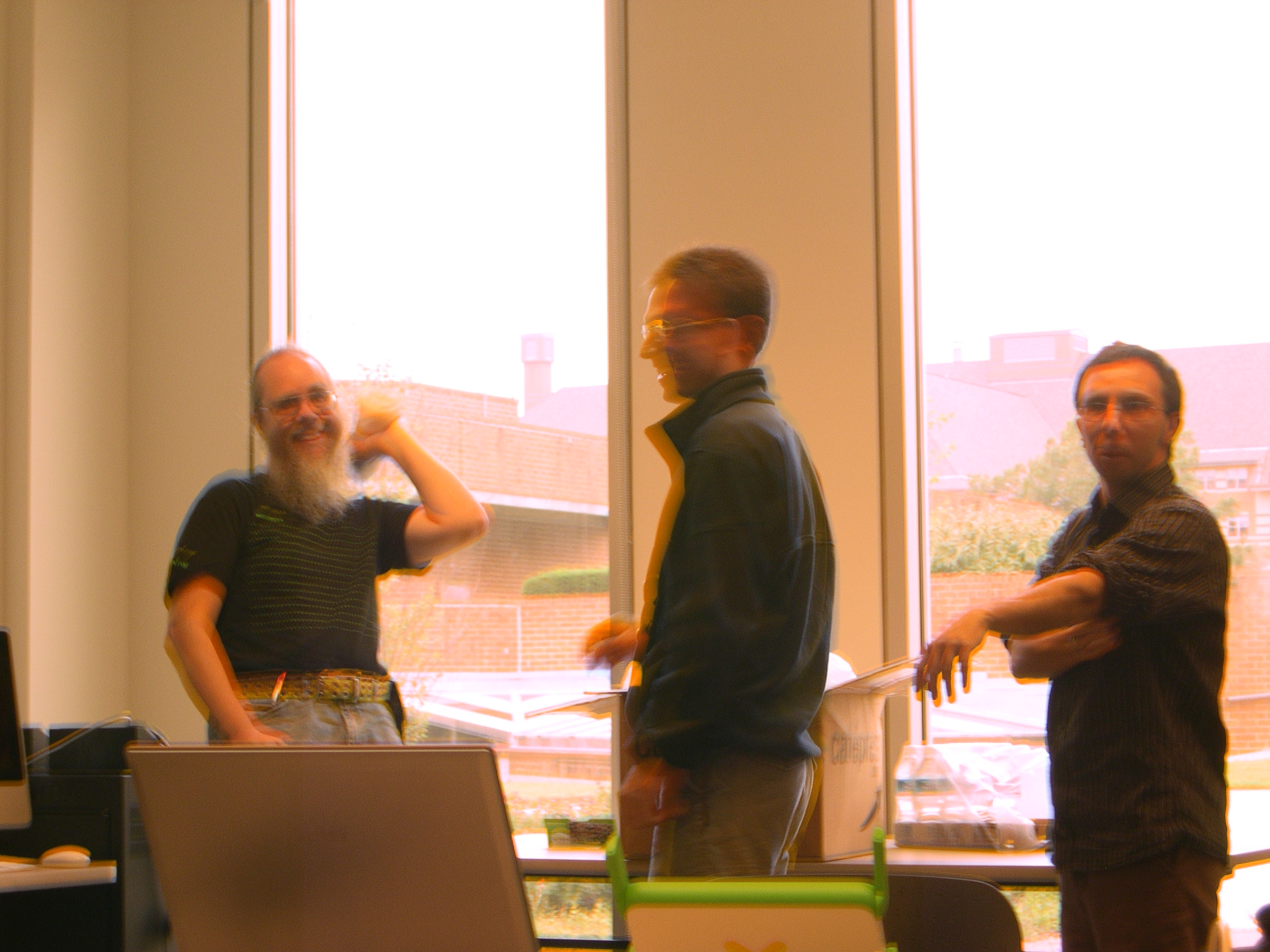
And Bernie Writing, Working, Posing for Photo, and Back to Writing
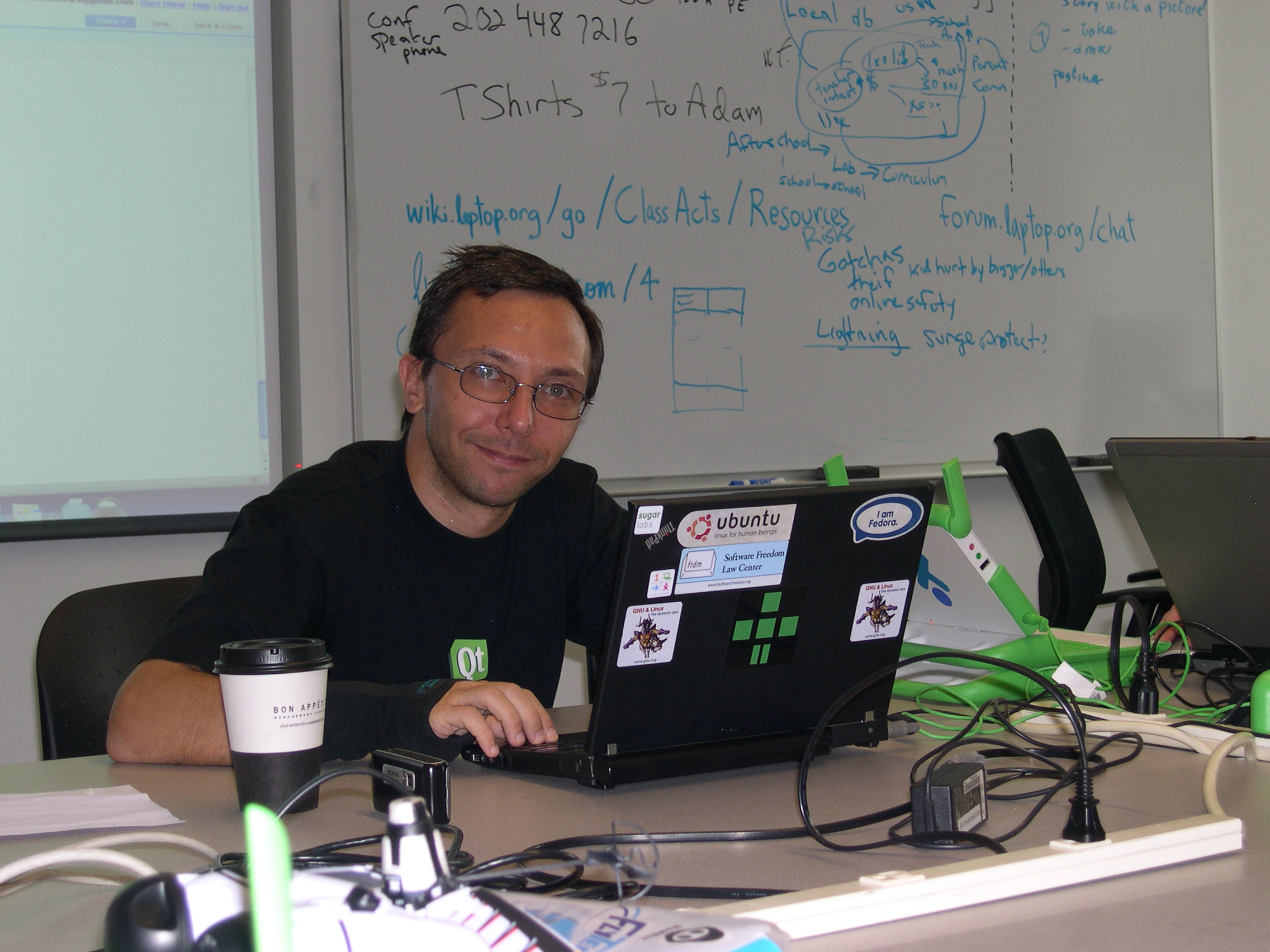
then HacDCing [upstairs after the lecture]

Creating More Characters
(or asking a talented little person to)
Penguins [Drawings] by Owen Davies

S.J. Lecturing to Deaf @ Gallaudet.edu
(interpreter out of frame)

Yama Introducing his Actors...

Trying A Biography Photo of Nancie This Way...
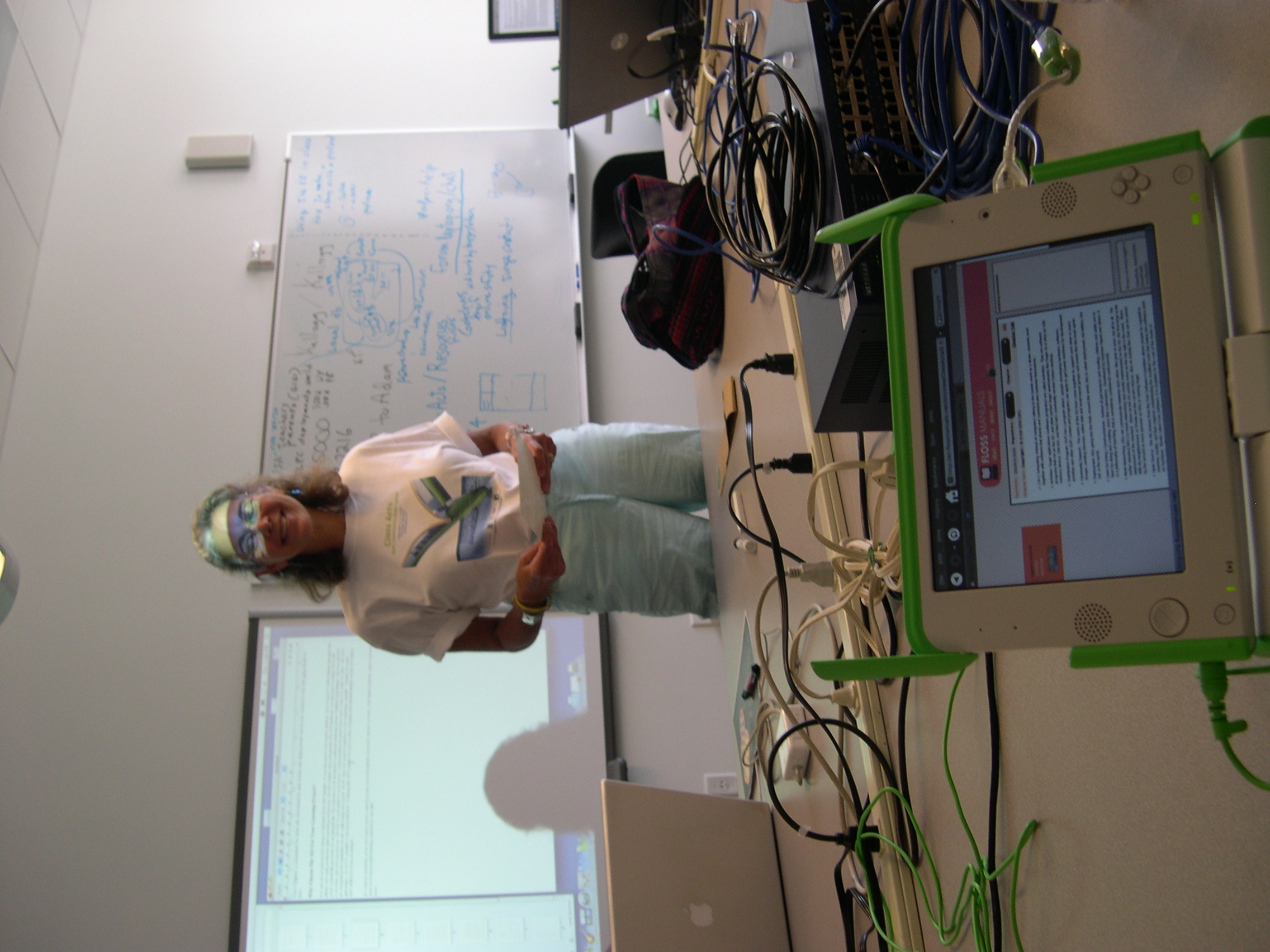
Trying Another Photo That Way...
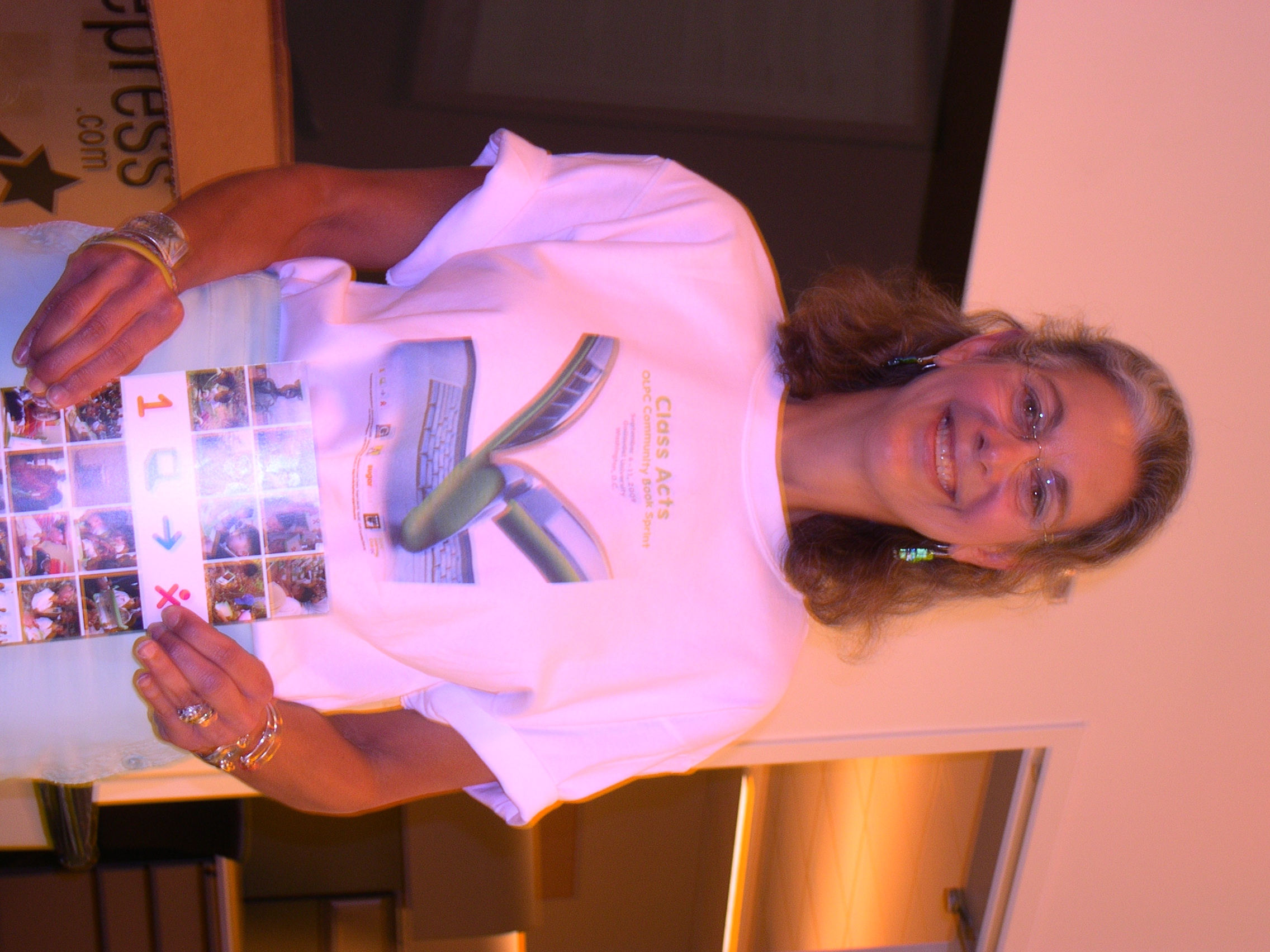
And Trying To Get It Right Side Up
on Deadline when sick and tired at home in the rain on the Last Day...
after
Eating some the night before [@ Taste of India]...

When Big And Full, And Very Very Tired,
And [Hopefully] Done Commuting,
Arguing, Planning, Thinking, and Writing and Talking,
Going Home, to Put It To Bed, and Rest...

License
All chapters copyright of the authors (see below). Unless otherwise stated all chapters in this manual licensed with GNU General Public License version 2
This documentation is free documentation; you can redistribute it and/or modify it under the terms of the GNU General Public License as published by the Free Software Foundation; either version 2 of the License, or (at your option) any later version.
This documentation is distributed in the hope that it will be useful, but WITHOUT ANY WARRANTY; without even the implied warranty of MERCHANTABILITY or FITNESS FOR A PARTICULAR PURPOSE. See the GNU General Public License for more details.
You should have received a copy of the GNU General Public License along with this documentation; if not, write to the Free Software Foundation, Inc., 51 Franklin Street, Fifth Floor, Boston, MA 02110-1301, USA.
Authors
AddingPeripheralsAddsExcitementToMeasure
© Caryl Bigenho 2009
Modifications:
A Holt 2009
Sandra Thaxter 2009
AfghanRefugeeSchool
© George Hunt 2009
Modifications:
Caryl Bigenho 2009
cathy ginther 2009
A Holt 2009
jerry w 2009
Jill Cosentino 2009
Sandra Thaxter 2009
Yamandú Ploskonka 2009
BoysorGirls
© Yamandú Ploskonka 2009
Modifications:
A Holt 2009
CareerSuccessChildProjects
© A Holt 2009
Modifications:
Caryl Bigenho 2009
cathy ginther 2009
ClassActTipsFromAnExperiencedVolunteer
© Sean Laurence 2010
CommunityBuilding Sur/Uruguay
© Yamandú Ploskonka 2009
Modifications:
George Hunt 2009
A Holt 2009
Credits
© adam hyde 2006, 2007
CustomsAndTransportation
© Yamandú Ploskonka 2009
Modifications:
Kevin Cole 2009
DroputsBecomeRegularAtSchool
© Manu Gupta 2009
Modifications:
Dan Tana 2009
A Holt 2009
Sandra Thaxter 2009
ElSalvadorXODeployment
© Kyle Ferlic 2009
Modifications:
A Holt 2009
EsquelaLabsInPeru
© George Hunt 2009
Modifications:
A Holt 2009
Pat Paul 2009
Yamandú Ploskonka 2009
EtoysKidsWorkshop
© Rita Freudenberg 2009
Modifications:
cathy ginther 2009
Cherry Withers 2009
George Hunt 2009
A Holt 2009
Pat Paul 2009
Sandra Thaxter 2009
EtoysLearningWorkshopsInBrazil
© bruno sperb 2009
Modifications:
cathy ginther 2009
A Holt 2009
EtoysTransformationalToolTeachingScience
© Rita Freudenberg 2009
Modifications:
A Holt 2009
Yamandú Ploskonka 2009
EveryStudentCanBenefitFromTheXO
© Caryl Bigenho 2009
Modifications:
Andrew Pompa 2009
A Holt 2009
Kevin Cole 2009
Yamandú Ploskonka 2009
Glossary
© A Holt 2009
Modifications:
cathy ginther 2009
George Hunt 2009
jerry w 2009
DigiLitCFSPilot
© Katelyn Foley 2009, 2010
Modifications:
A Holt 2009
Kevin Cole 2009
PTAScratchEnrichmentProgram
© TWikiGuest 1970
Introduction
© adam hyde 2006, 2007
Modifications:
A Holt 2009
jerry w 2009
Sandra Thaxter 2009
Sean Laurence 2010
KenyaOLPCorpsStory
© David Norman 2009, 2010
Modifications:
A Holt 2009
jerry w 2009
Kyle Ferlic 2009
Sandra Thaxter 2009
KhairatSchoolIndia
© Sameer Verma 2009
Modifications:
A Holt 2009
Manu Gupta 2009
LocalSolutionsAreTheKey
© Tony Anderson 2009
Modifications:
A Holt 2009
Sandra Thaxter 2009
LogisticsIntro
© Yamandú Ploskonka 2009
Modifications:
cathy ginther 2009
A Holt 2009
ManySmallDeploymentsChallengeOceania
© Caryl Bigenho 2009
Modifications:
A Holt 2009
Kevin Cole 2009
Nancie Severs 2009
Sandra Thaxter 2009
Outcomes
© jerry w 2009
Modifications:
A Holt 2009
ParaguayLargeDistro
© George Hunt 2009
Modifications:
A Holt 2009
Sandra Thaxter 2009
PioneeringOLPCAcrossAfghanistan
© A Holt 2009
Modifications:
jerry w 2009
Sandra Thaxter 2009
PowerIssues
© Yamandú Ploskonka 2009
Modifications:
Caryl Bigenho 2009
cathy ginther 2009
A Holt 2009
Sandra Thaxter 2009
Sandy Culver 2009
TWikiGuest 2009
SprintPhotos
© jerry w 2009
StartingANewProject
© Nancie Severs 2009
Modifications:
Andrew Pompa 2010
Caryl Bigenho 2009
A Holt 2009
Kevin Cole 2009
SummerInChicago
© Mel Chua 2009
Modifications:
A Holt 2009
Nancie Severs 2009
ThreeYearOldsTeachFamiliesToUseTheXO
© Caryl Bigenho 2009
Modifications:
cathy ginther 2009
A Holt 2009
Pat Paul 2009
TimeLapseWithBees
© Andrew Pompa 2009
WaveplaceStory
© Rita Freudenberg 2009
Modifications:
Cherry Withers 2009
A Holt 2009
Kevin Cole 2009
William Stelzer 2009
TheXOIsATeachersDreamMachine
© Nancie Severs 2009
Modifications:
cathy ginther 2009
A Holt 2009
Sandra Thaxter 2009
XORecipesForTheClassroom
© Yamandú Ploskonka 2009
Modifications:
Caryl Bigenho 2009
A Holt 2009
jerry w 2009
Sandra Thaxter 2009
XORepairCenterStartedByHighSchoolStudent
© Geroge Hunt 2009
Modifications:
George Hunt 2009
A Holt 2009
Sandra Thaxter 2009
Sandy Culver 2009
Yamandú Ploskonka 2009

Free manuals for free software
General Public License
Version 2, June 1991
Copyright (C) 1989, 1991 Free Software Foundation, Inc.
51 Franklin Street, Fifth Floor, Boston, MA 02110-1301, USA
Everyone is permitted to copy and distribute verbatim copies
of this license document, but changing it is not allowed.
Preamble
The licenses for most software are designed to take away your freedom to share and change it. By contrast, the GNU General Public License is intended to guarantee your freedom to share and change free software--to make sure the software is free for all its users. This General Public License applies to most of the Free Software Foundation's software and to any other program whose authors commit to using it. (Some other Free Software Foundation software is covered by the GNU Lesser General Public License instead.) You can apply it to your programs, too.
When we speak of free software, we are referring to freedom, not price. Our General Public Licenses are designed to make sure that you have the freedom to distribute copies of free software (and charge for this service if you wish), that you receive source code or can get it if you want it, that you can change the software or use pieces of it in new free programs; and that you know you can do these things.
To protect your rights, we need to make restrictions that forbid anyone to deny you these rights or to ask you to surrender the rights. These restrictions translate to certain responsibilities for you if you distribute copies of the software, or if you modify it.
For example, if you distribute copies of such a program, whether gratis or for a fee, you must give the recipients all the rights that you have. You must make sure that they, too, receive or can get the source code. And you must show them these terms so they know their rights.
We protect your rights with two steps: (1) copyright the software, and (2) offer you this license which gives you legal permission to copy, distribute and/or modify the software.
Also, for each author's protection and ours, we want to make certain that everyone understands that there is no warranty for this free software. If the software is modified by someone else and passed on, we want its recipients to know that what they have is not the original, so that any problems introduced by others will not reflect on the original authors' reputations.
Finally, any free program is threatened constantly by software patents. We wish to avoid the danger that redistributors of a free program will individually obtain patent licenses, in effect making the program proprietary. To prevent this, we have made it clear that any patent must be licensed for everyone's free use or not licensed at all.
The precise terms and conditions for copying, distribution and modification follow.
TERMS AND CONDITIONS FOR COPYING, DISTRIBUTION AND MODIFICATION
0. This License applies to any program or other work which contains a notice placed by the copyright holder saying it may be distributed under the terms of this General Public License. The "Program", below, refers to any such program or work, and a "work based on the Program" means either the Program or any derivative work under copyright law: that is to say, a work containing the Program or a portion of it, either verbatim or with modifications and/or translated into another language. (Hereinafter, translation is included without limitation in the term "modification".) Each licensee is addressed as "you".
Activities other than copying, distribution and modification are not covered by this License; they are outside its scope. The act of running the Program is not restricted, and the output from the Program is covered only if its contents constitute a work based on the Program (independent of having been made by running the Program). Whether that is true depends on what the Program does.
1. You may copy and distribute verbatim copies of the Program's source code as you receive it, in any medium, provided that you conspicuously and appropriately publish on each copy an appropriate copyright notice and disclaimer of warranty; keep intact all the notices that refer to this License and to the absence of any warranty; and give any other recipients of the Program a copy of this License along with the Program.
You may charge a fee for the physical act of transferring a copy, and you may at your option offer warranty protection in exchange for a fee.
2. You may modify your copy or copies of the Program or any portion of it, thus forming a work based on the Program, and copy and distribute such modifications or work under the terms of Section 1 above, provided that you also meet all of these conditions:
- a) You must cause the modified files to carry prominent notices stating that you changed the files and the date of any change.
- b) You must cause any work that you distribute or publish, that in whole or in part contains or is derived from the Program or any part thereof, to be licensed as a whole at no charge to all third parties under the terms of this License.
- c) If the modified program normally reads commands interactively when run, you must cause it, when started running for such interactive use in the most ordinary way, to print or display an announcement including an appropriate copyright notice and a notice that there is no warranty (or else, saying that you provide a warranty) and that users may redistribute the program under these conditions, and telling the user how to view a copy of this License. (Exception: if the Program itself is interactive but does not normally print such an announcement, your work based on the Program is not required to print an announcement.)
These requirements apply to the modified work as a whole. If identifiable sections of that work are not derived from the Program, and can be reasonably considered independent and separate works in themselves, then this License, and its terms, do not apply to those sections when you distribute them as separate works. But when you distribute the same sections as part of a whole which is a work based on the Program, the distribution of the whole must be on the terms of this License, whose permissions for other licensees extend to the entire whole, and thus to each and every part regardless of who wrote it.
Thus, it is not the intent of this section to claim rights or contest your rights to work written entirely by you; rather, the intent is to exercise the right to control the distribution of derivative or collective works based on the Program.
In addition, mere aggregation of another work not based on the Program with the Program (or with a work based on the Program) on a volume of a storage or distribution medium does not bring the other work under the scope of this License.
3. You may copy and distribute the Program (or a work based on it, under Section 2) in object code or executable form under the terms of Sections 1 and 2 above provided that you also do one of the following:
- a) Accompany it with the complete corresponding machine-readable source code, which must be distributed under the terms of Sections 1 and 2 above on a medium customarily used for software interchange; or,
- b) Accompany it with a written offer, valid for at least three years, to give any third party, for a charge no more than your cost of physically performing source distribution, a complete machine-readable copy of the corresponding source code, to be distributed under the terms of Sections 1 and 2 above on a medium customarily used for software interchange; or,
- c) Accompany it with the information you received as to the offer to distribute corresponding source code. (This alternative is allowed only for noncommercial distribution and only if you received the program in object code or executable form with such an offer, in accord with Subsection b above.)
The source code for a work means the preferred form of the work for making modifications to it. For an executable work, complete source code means all the source code for all modules it contains, plus any associated interface definition files, plus the scripts used to control compilation and installation of the executable. However, as a special exception, the source code distributed need not include anything that is normally distributed (in either source or binary form) with the major components (compiler, kernel, and so on) of the operating system on which the executable runs, unless that component itself accompanies the executable.
If distribution of executable or object code is made by offering access to copy from a designated place, then offering equivalent access to copy the source code from the same place counts as distribution of the source code, even though third parties are not compelled to copy the source along with the object code.
4. You may not copy, modify, sublicense, or distribute the Program except as expressly provided under this License. Any attempt otherwise to copy, modify, sublicense or distribute the Program is void, and will automatically terminate your rights under this License. However, parties who have received copies, or rights, from you under this License will not have their licenses terminated so long as such parties remain in full compliance.
5. You are not required to accept this License, since you have not signed it. However, nothing else grants you permission to modify or distribute the Program or its derivative works. These actions are prohibited by law if you do not accept this License. Therefore, by modifying or distributing the Program (or any work based on the Program), you indicate your acceptance of this License to do so, and all its terms and conditions for copying, distributing or modifying the Program or works based on it.
6. Each time you redistribute the Program (or any work based on the Program), the recipient automatically receives a license from the original licensor to copy, distribute or modify the Program subject to these terms and conditions. You may not impose any further restrictions on the recipients' exercise of the rights granted herein. You are not responsible for enforcing compliance by third parties to this License.
7. If, as a consequence of a court judgment or allegation of patent infringement or for any other reason (not limited to patent issues), conditions are imposed on you (whether by court order, agreement or otherwise) that contradict the conditions of this License, they do not excuse you from the conditions of this License. If you cannot distribute so as to satisfy simultaneously your obligations under this License and any other pertinent obligations, then as a consequence you may not distribute the Program at all. For example, if a patent license would not permit royalty-free redistribution of the Program by all those who receive copies directly or indirectly through you, then the only way you could satisfy both it and this License would be to refrain entirely from distribution of the Program.
If any portion of this section is held invalid or unenforceable under any particular circumstance, the balance of the section is intended to apply and the section as a whole is intended to apply in other circumstances.
It is not the purpose of this section to induce you to infringe any patents or other property right claims or to contest validity of any such claims; this section has the sole purpose of protecting the integrity of the free software distribution system, which is implemented by public license practices. Many people have made generous contributions to the wide range of software distributed through that system in reliance on consistent application of that system; it is up to the author/donor to decide if he or she is willing to distribute software through any other system and a licensee cannot impose that choice.
This section is intended to make thoroughly clear what is believed to be a consequence of the rest of this License.
8. If the distribution and/or use of the Program is restricted in certain countries either by patents or by copyrighted interfaces, the original copyright holder who places the Program under this License may add an explicit geographical distribution limitation excluding those countries, so that distribution is permitted only in or among countries not thus excluded. In such case, this License incorporates the limitation as if written in the body of this License.
9. The Free Software Foundation may publish revised and/or new versions of the General Public License from time to time. Such new versions will be similar in spirit to the present version, but may differ in detail to address new problems or concerns.
Each version is given a distinguishing version number. If the Program specifies a version number of this License which applies to it and "any later version", you have the option of following the terms and conditions either of that version or of any later version published by the Free Software Foundation. If the Program does not specify a version number of this License, you may choose any version ever published by the Free Software Foundation.
10. If you wish to incorporate parts of the Program into other free programs whose distribution conditions are different, write to the author to ask for permission. For software which is copyrighted by the Free Software Foundation, write to the Free Software Foundation; we sometimes make exceptions for this. Our decision will be guided by the two goals of preserving the free status of all derivatives of our free software and of promoting the sharing and reuse of software generally.
NO WARRANTY
11. BECAUSE THE PROGRAM IS LICENSED FREE OF CHARGE, THERE IS NO WARRANTY FOR THE PROGRAM, TO THE EXTENT PERMITTED BY APPLICABLE LAW. EXCEPT WHEN OTHERWISE STATED IN WRITING THE COPYRIGHT HOLDERS AND/OR OTHER PARTIES PROVIDE THE PROGRAM "AS IS" WITHOUT WARRANTY OF ANY KIND, EITHER EXPRESSED OR IMPLIED, INCLUDING, BUT NOT LIMITED TO, THE IMPLIED WARRANTIES OF MERCHANTABILITY AND FITNESS FOR A PARTICULAR PURPOSE. THE ENTIRE RISK AS TO THE QUALITY AND PERFORMANCE OF THE PROGRAM IS WITH YOU. SHOULD THE PROGRAM PROVE DEFECTIVE, YOU ASSUME THE COST OF ALL NECESSARY SERVICING, REPAIR OR CORRECTION.
12. IN NO EVENT UNLESS REQUIRED BY APPLICABLE LAW OR AGREED TO IN WRITING WILL ANY COPYRIGHT HOLDER, OR ANY OTHER PARTY WHO MAY MODIFY AND/OR REDISTRIBUTE THE PROGRAM AS PERMITTED ABOVE, BE LIABLE TO YOU FOR DAMAGES, INCLUDING ANY GENERAL, SPECIAL, INCIDENTAL OR CONSEQUENTIAL DAMAGES ARISING OUT OF THE USE OR INABILITY TO USE THE PROGRAM (INCLUDING BUT NOT LIMITED TO LOSS OF DATA OR DATA BEING RENDERED INACCURATE OR LOSSES SUSTAINED BY YOU OR THIRD PARTIES OR A FAILURE OF THE PROGRAM TO OPERATE WITH ANY OTHER PROGRAMS), EVEN IF SUCH HOLDER OR OTHER PARTY HAS BEEN ADVISED OF THE POSSIBILITY OF SUCH DAMAGES.
END OF TERMS AND CONDITIONS



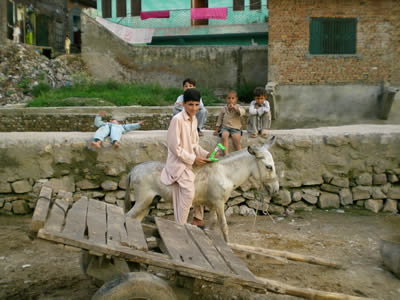



























 Cincinnati
Cincinnati


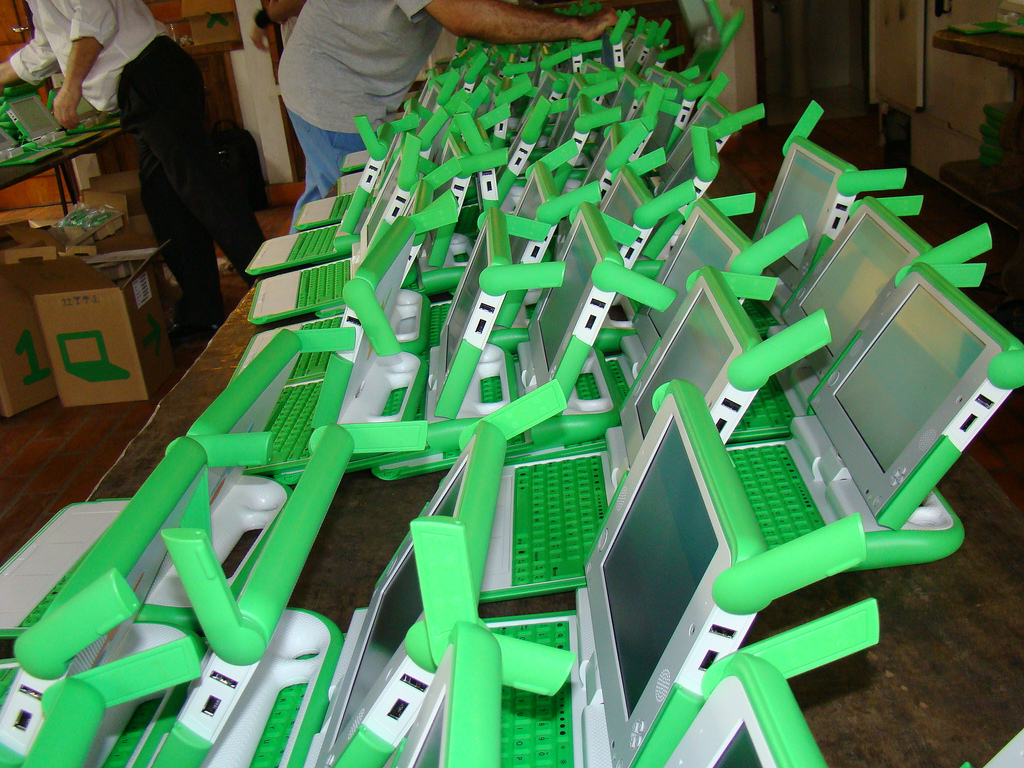

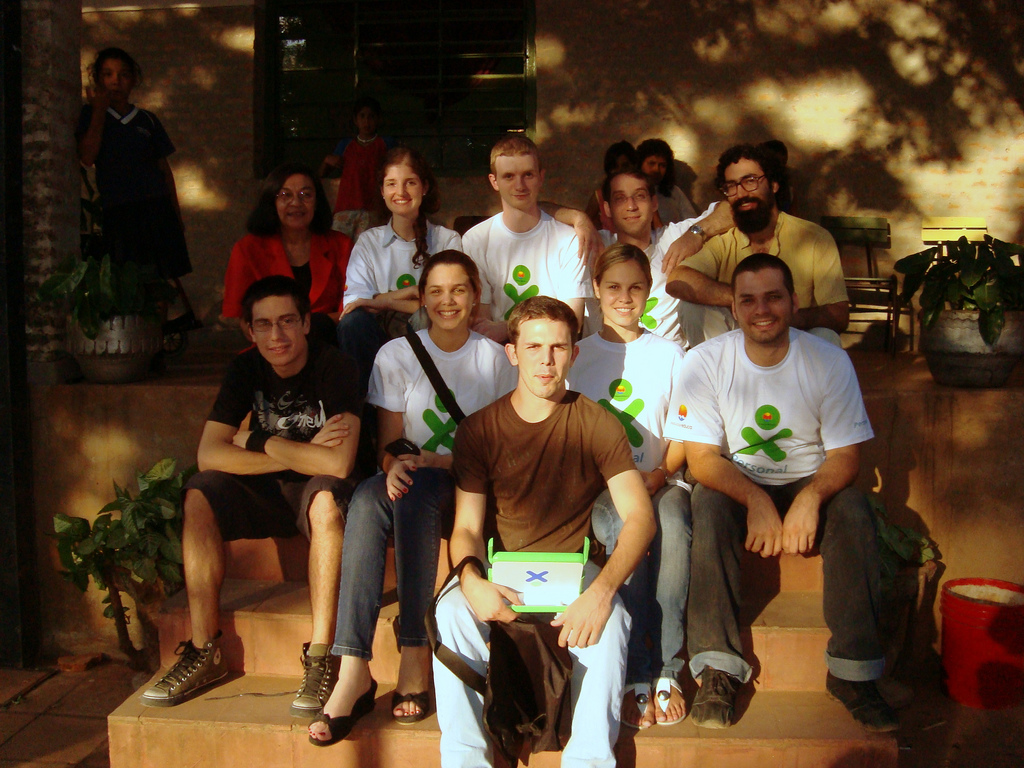
















 Over the course of the fall, we hosted training workshops with teachers, reviewed sixth grade syllabi, and brainstormed ideas for integrating the XO into the existing curriculum. In January, we worked with Olin College of Engineering and Illinois Math and Science Academy to continue teacher training and to offer laptop-based after-school activities for students during a pre-pilot week. We launched the pilot in mid-February with an XOXO Valentine’s themed party for CFS faculty, students, and families.
Over the course of the fall, we hosted training workshops with teachers, reviewed sixth grade syllabi, and brainstormed ideas for integrating the XO into the existing curriculum. In January, we worked with Olin College of Engineering and Illinois Math and Science Academy to continue teacher training and to offer laptop-based after-school activities for students during a pre-pilot week. We launched the pilot in mid-February with an XOXO Valentine’s themed party for CFS faculty, students, and families.


 After the initial honeymoon phase, students began to show frustration with any and all technical difficulties. During a collaborative biology activity, one student traded her XO for the shiny new MacBook she had in her backpack. Inherent in doing an XO laptop pilot at an American school is the idea that this is a waste, that privileged kids won’t get anything out of the XO. Midway through the pilot, we couldn’t help but wonder if we had proven this point.
After the initial honeymoon phase, students began to show frustration with any and all technical difficulties. During a collaborative biology activity, one student traded her XO for the shiny new MacBook she had in her backpack. Inherent in doing an XO laptop pilot at an American school is the idea that this is a waste, that privileged kids won’t get anything out of the XO. Midway through the pilot, we couldn’t help but wonder if we had proven this point.





















